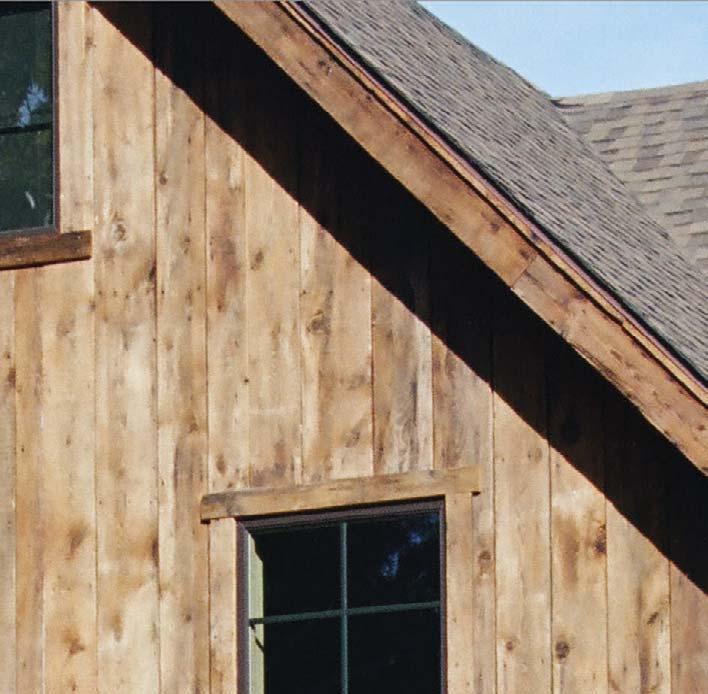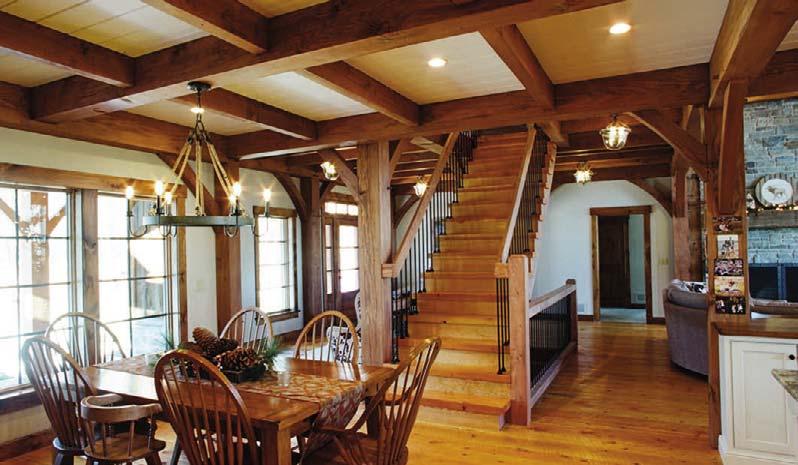
























From the famous ocean walks of tourist hubs Newport and Ogunquit to lesser-known paths through wilder landscapes, we share our 12 favorite places to stroll by the seashore.
For the fifth year running, Yankee readers picked up their cameras to look at our region in fresh new ways. We think you’ll agree they succeeded.
Tom Stuwe’s decades-long career as a Vermont country vet has given him experience with creatures great and small— and insight into those who care for them. By Ben Hewitt
114
They said it would be a chore, and it was. But tending to a broken-down old fence also became a way to honor a home’s generations of caretakers. By Bill Donahue
118
In Lewiston, Maine, thousands of African immigrants are making a brighter future for themselves. In the process, they’re doing the same for Lewiston. By Cynthia Anderson
 Originally from Somalia, friends Ali, left, and Faysal are now fourth-graders in Lewiston, Maine.
Originally from Somalia, friends Ali, left, and Faysal are now fourth-graders in Lewiston, Maine.





Travel along the epic route forged by Lewis and Clark in complete comfort aboard our elegant new riverboats. Experience our award-winning guided excursions that give you an insider’s perspective of the most captivating destinations including Multnomah Falls, Mount St. Helens, and the Columbia River Gorge. Small Ship Cruising Done Perfectly.™







Call today for your free cruise guide.
























30 /// The House That Changed Everything
Architecture fans everywhere mourned the loss of the iconic seaside mansion Kragsyde, but only two decided to honor its memory by replicating the 1880s masterpiece—from scratch. By Jane Goodrich
40 /// Open Studio
Using the forest as his palette, Craig Altobello takes marquetry to new artistic heights. By Annie Graves
44 /// House for Sale
We thought this Connecticut River property sounded too good to be true. We were, happily, dead wrong.
 By the Yankee Moseyer
By the Yankee Moseyer
50 /// “Weekends” Warrior
Go behind the scenes of our new TV show, Weekends with Yankee, with intrepid food editor Amy Traverso.
64 /// New Vintage Cooking
The marvelous soothing power of old-fashioned maple dumplings. By Amy Traverso
68 /// Could You Live Here?
Step back in time in the highly walkable enclave of Old Wethersfield, Connecticut. By Annie Graves
74 /// The Best 5
At these eco-savvy New England inns and hotels, it’s easy being green. By Kim Knox Beckius
76 /// Local Treasure
In Boston, two Kennedy museums illuminate the enduring promise of democracy. By Joe Bills
80 /// Out & About
The sweetest maple festivals this season, plus fairs, concerts, and other events worth the drive. 68

10
DEAR YANKEE, CONTRIBUTORS & POETRY BY D.A.W.
12
INSIDE YANKEE
14
MARY’S FARM
The surprisingly patriotic past of a humble backyard shed. By Edie Clark
16
LIFE IN THE KINGDOM
On a newly built homestead, winter survival gives way to springtime revival. By Ben
 Hewitt
Hewitt
20
FIRST LIGHT
Walking with memories on the Appalachian Trail. By Christine Woodside
24
UP CLOSE
How the Segway scooter navigated the road to fame. By Heather Tourgee
26
KNOWLEDGE & WISDOM
An ode to slushy skiing, tips on evicting squirrels, and celebrating 20 years of Good Will Hunting
144
Looking back at the Boston Marathon moment that became a milestone.

1121 Main St., P.O. Box 520, Dublin, NH 03444. 603-563-8111; editor@YankeeMagazine.com
EDITORIAL
EDITOR Mel Allen
ART DIRECTOR Lori Pedrick
DEPUTY EDITOR Ian Aldrich
MANAGING EDITOR Jenn Johnson
SENIOR EDITOR/FOOD Amy Traverso
PHOTO EDITOR Heather Marcus
SENIOR PHOTOGRAPHER Mark Fleming
DIGITAL EDITOR Aimee Tucker
DIGITAL ASSISTANT EDITOR Cathryn McCann
ASSOCIATE EDITOR Joe Bills
HOME & GARDEN EDITOR Annie Graves
INTERN Montana Rogers
CONTRIBUTING EDITORS Kim Knox Beckius, Edie Clark, Ben Hewitt, Julia Shipley
CONTRIBUTING PHOTOGRAPHERS Julie Bidwell, Kindra Clineff, Sara Gray, Corey Hendrickson, Joe Keller, Joel Laino, Jarrod McCabe, Michael Piazza, Heath Robbins, Carl Tremblay
PRODUCTION
PRODUCTION DIRECTORS David Ziarnowski, Susan Gross
SENIOR PRODUCTION ARTISTS Jennifer Freeman, Rachel Kipka
DIGITAL
VP NEW MEDIA & PRODUCTION Paul Belliveau Jr.
DIGITAL MARKETING MANAGER Amy O’Brien
YANKEE PUBLISHING INC.
established 1935
PRESIDENT Jamie Trowbridge
EDITOR-IN-CHIEF Judson D. Hale Sr.
VICE PRESIDENTS Paul Belliveau Jr., Jody Bugbee, Judson D. Hale Jr., Brook Holmberg, Sherin Pierce
CHIEF FINANCIAL OFFICER Ken Kraft
CORPORATE STAFF Mike Caron, Linda Clukay, Sandra Lepple, Nancy Pfuntner, Bill Price, Christine Tourgee
BOARD OF DIRECTORS
CHAIRMAN Judson D. Hale Sr.
VICE CHAIRMAN Tom Putnam
DIRECTORS Andrew Clurman, H. Hansell Germond, Daniel Hale, Judson D. Hale Jr., Joel Toner, Cor Trowbridge, Jamie Trowbridge
FOUNDERS
ROBB & BEATRIX SAGENDORPH
PUBLISHER Brook Holmberg
ADVERTISING: PRINT/DIGITAL
VICE PRESIDENT/SALES Judson D. Hale Jr.
SALES IN NEW ENGLAND
TRAVEL, NORTH Kelly Moores (NH North, ME) KellyM@yankeepub.com
TRAVEL, SOUTH Dean DeLuca (NH South, CT, RI, MA) DeanD@yankeepub.com
TRAVEL, WEST David Honeywell (NY, VT) Dave_golfhouse@madriver.com
DIRECT RESPONSE Steven Hall SteveH@yankeepub.com
SPECIAL PROJECTS Rebekah Valberg, 617-733-2768 Rebekah@maxradius.net
CLASSIFIED Christine Anderson Yankee.MyAdPortal.com
SALES OUTSIDE NEW ENGLAND
NATIONAL Susan Lyman, 646-221-4169 Susan@selmarsolutions.com
CANADA Alex Kinninmont, Françoise Chalifour, Cynthia Jollymore, 416-363-1388
AD COORDINATOR Janet Selle
For advertising rates and information: 800-736-1100, ext. 149 NewEngland.com/adinfo
MARKETING
CONSUMER
MANAGERS Kate McPherson, Kathleen Rowe
ASSOCIATE Kirsten O’Connell
ADVERTISING
DIRECTOR Joely Fanning
ASSOCIATE Valerie Lithgow
PUBLIC RELATIONS
BRAND MARKETING DIRECTOR Kate Hathaway Weeks
NEWSSTAND
VICE PRESIDENT Sherin Pierce
DIRECT SALES
MARKETING MANAGER Stacey Korpi

SALES ASSOCIATE Janice Edson
SUBSCRIPTION SERVICES
To subscribe, give a gift, or change your mailing address, or for other questions, please contact our customer service department: Online: NewEngland.com/contact
Phone: 800-288-4284
Mail: Yankee Magazine Customer Service
P.O. Box 422446
Palm Coast, FL 32142-2446 Printed





































































Seasons: Best Spring Flower Festivals

Craving color? Check out these bloom-filled ways to kiss winter good-bye.
NEWENGLAND.COM/ FLOWERFESTIVALS

Recipes: Saint Patrick’s Day Favorites

Ten sweet and savory dishes to satisfy the Irish in all of us.
NEWENGLAND.COM/ STPATRICKSDAYFOOD
Travel: Mad About Maple
We’ve got your cravings covered with a state-bystate guide to the region’s top maple fests.

NEWENGLAND.COM/ MAPLECELEBRATIONS
Crafts: Naturally Vibrant Easter Eggs
How to create colorful, natural egg dyes from common kitchen ingredients.
NEWENGLAND.COM/ EASTEREGGS













MARK
“Riding shotgun with a large-animal vet definitely lands in my all-time 10 favorite assignments,” Fleming says of shooting “A Farmer’s Best Friend” (p. 104). A proud resident of Portland, Maine, who studied photojournalism at the Rochester Institute of Technology, Fleming recently joined Yankee as senior photographer after working for the likes of Down East and Boston magazines, REI, and L.L. Bean.
Growing up in western Maine in the ’70s, this author and journalist spent a lot of time in Lewiston (“City of Hope,” p. 118). For 12 years she’s been writing about the city’s new immigrants—and its transformation. “When I’m with friends drinking chai in a downtown café,” she says, “I have a feeling of having come full circle.” Her in-progress book, Isbedal, follows seven new residents up to and beyond the 2016 election.
BILL

In “Painting the Fence” (p. 114), Donahue describes just part of a larger effort to reinvigorate the New Hampshire house that’s been in his family for more than a century. “It’s all about making the house stand up and survive for—let’s say at least 30 years, at which point, I hope, I’ll hand the task off to the next generation,” says Donahue, who has also written for The New Yorker and The Atlantic, among others.
CINDY
An award-winning oil painter with a BFA from the New Hampshire Institute of Art, Rizza found a bit of serendipity in illustrating “Painting the Fence” (p. 114): Turns out, she’s friends with some of the author’s neighbors at Gilmanton Corners. “It seems like a truly special community where everyone knows each other,” she says, “especially those tasked with maintaining the charm of the old homes there.”
A veteran photojournalist who previously worked for the Washington, D.C., bureau of The New York Times, Toensing brought a unique perspective to documenting the African immigrant community in Lewiston, Maine (“City of Hope,” p. 118). Through the nonprofit VisionWorkshops, she has helped teach photography to Somali and Sudanese refugees in Maine, and Burmese refugees in Baltimore.
CHRISTINE WOODSIDE

Woodside, a Connecticut-based writer and editor, says the experience of hiking the Appalachian Trail has changed a lot in the 30 years since she first tackled it (“Trail of Memories,” p. 20). In many ways it’s less challenging, a fact that she mourns: “Carrying our own gear and being truly out of touch with the home front, as we were back in the pre-cellphone 1980s, made me a more resilient and grateful person.”
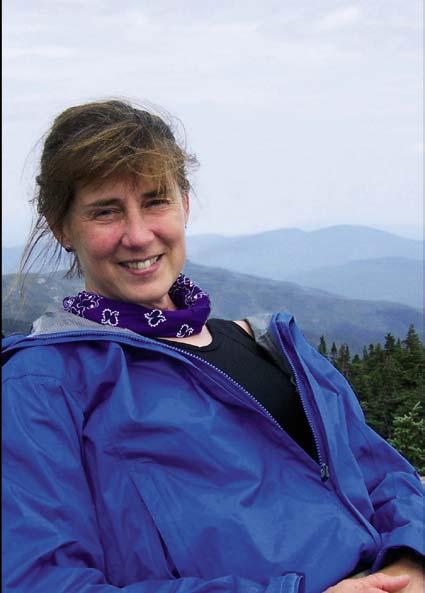
Your article on Joel Woods [“A Hard Life Made Beautiful,” January/February] speaks volumes on what it takes to become an artist in photography. The real artist is self-taught and schooled by reality; gets his photo ops in the rough, instantaneously, while being extraordinarily alert and balanced; and uses any camera he can get his hands on. The wannabe buys a Canon or Minolta, signs up for a course or curriculum, and then rides around during foliage season to be delivered photo ops on a silver platter. (By the way, I’m more the inbetween type....)

David
SöderbergGlastonbury, Connecticut
I really enjoyed the January/February issue, especially Ben Hewitt’s column, “The Wheel Deal.” I chuckled when it mentioned that the Subaru was the unofficial state automobile of Vermont. I, too, own a Subaru, a 2011 Outback with just under 140,000 miles. They are great cars and run forever. We have owned many vehicles, from hand-me-downs to former police cars, but I have a feeling we will be driving our Outback until the wheels fall off.
Smart, those Vermonters.
Gretchen Becker Albuquerque, New Mexico

Thanks so much for the piece on the Sacred Cod [Up Close, November/ December]. When I was a kid in the ’50s, my grandfather was a court officer in the Massachusetts Statehouse. He always told me it was his job to guard the Sacred Cod. Now I have something to prove to my doubting friends that the big fish exists!
Elizabeth E. Brown Lancaster, PennsylvaniaPS: He also told me it was his job to paint the dome gold.



I was delighted to see mention of Calvin Coolidge’s 1924 campaign in Yankee [“Getting Out the Vote,” November/December]. However, the accompanying photo actually shows President Coolidge’s father. (Both were named John Calvin Coolidge.)
Coolidge’s father had a great influence on his son’s life, and one can only imagine his thoughts as he contemplated this election, which Coolidge would win in a landslide.
Apartment and cottage living at Piper Shores offers residents fully updated and affordable homes, with all the benefits of Maine’s first and only nonprofit lifecare retirement community. Located along the Southern Maine coastline, our active, engaged community combines worry-free independent living with priority access to higher levels of on-site healthcare—all for a predictable monthly fee.




Calvin Coolidge
Diane Kemble Education director, Presidential Foundation
Presidential Foundation





Plymouth Notch, Vermont
The feature “Curious About George” [January/February] incorrectly identified a Portsmouth, New Hampshire, church where George Washington attended services in 1789. Then called Queen’s Chapel, it is today known as St. John’s Episcopal Church.
t’s been nearly a century since a 7-pound baby boy was born at 83 Beals Street in Brookline, Massachusetts, on May 29, 1917. His parents named him John Fitzgerald Kennedy, and it’s almost inconceivable that he would have turned 100 this year, since we know him forever as a president with youth, vigor, and optimism, standing on a Cape Cod beach, hair tousled by a salt-filled wind. In “Beyond Camelot” (p. 76), we remember JFK, his brother Ted, and an era when politics was defined by civil discourse as we visit the two adjacent Boston museums that speak to the Kennedys’ legacy at a time when understanding history has seldom felt more important.
JFK loved the ocean. Indeed, visitors to the smaller John F. Kennedy Museum, in Hyannis, will see his statue outside, caught midstride among tufts of beach grass. For most of us, a walk by the ocean remains one of life’s great levelers. When you stroll beside the wave-rippled water with seabirds fluttering all about, it matters little if you are young or old. Life seems better then. It just does. In “Walks Worth Their Salt” (p. 86), we take you along on some of our favorites. But it’s far from an exhaustive list—so much coastline, so few pages—and intrepid seekers of coastal walks no doubt have their own special trails and beaches. We want to hear about those, too, so email your personal picks to editor@yankeemagazine.com.
Our lead story (“City of Hope,” p. 118) centers on a small Maine city filled with recent arrivals from distant shores. More than almost any other community in the country, Lewiston has seen a seismic shift in its identity: Of its nearly 36,000 residents, some 6,000 emigrated in the past 16 years from African nations beset by strife. Many are Muslim. They want to work, raise families, and thrive in New England. Writer Cynthia Anderson follows some of these new Mainers, who have known hard pasts and now face a future that seems a bit more brittle than it did a few months ago.
As you get to know these newcomers, ask yourself if their hopes and dreams are all that different from those of two families who arrived in New England in the mid-19th century, driven from Ireland by the potato famine. The Fitzgeralds emigrated from the village of Bruff, in County Limerick; at the same time, a cooper named Patrick Kennedy set sail for the United States from Dunganstown. Years passed and marriages happened and generations followed, and on May 29, 1917, a baby boy was born in Brookline.
Mel Allen editor@yankeemagazine.com





































ore than 30 years ago, I bought a little cottage called Bide-a-wee in the woods off Seaver Pond. Along with another, larger outbuilding, there was a small shed beside the remains of a stone foundation. That shed was tall, with a hip roof, bigger than an old phone booth but not by much. Despite the sturdy construction, it seemed to me the shed must have been an outhouse.
My only neighbor, Paul Geddes, lived up at the Seaver farm. Also known as Silver Lake Farm, it once was owned by Edgar Seaver, legendary for his bachelor lifestyle and Yankee thrift. At one point Bide-a-wee had been part of the Seaver farm, even if just as a rental; Edgar, who ran the rural mail route by horse and buggy, gave the cottage its name, which means “stay awhile” in Scottish parlance.
Paul, who worked for Edgar as a kid, became a great friend to me, and over the years he’s provided me with stories about Bide-a-wee and Silver Lake Farm. He’s the one who told me that the structure I thought was a mere outhouse began life as a government-issued “spotter shed,” where citizen volunteers would sit to watch for enemy planes during World War II. Having never heard of such a thing, I found this intriguing.
In order for my shed to have been a spotter shed, Paul explained, it couldn’t have started its life in the Bide-a-wee woods. Instead, it sat up on the high point of Silver Lake Farm, in that wonderful open meadow that offered views of both our beloved mountain and Silver Lake, which sparkled and beckoned in the near distance.
At that time of war, there were many other spotter sheds across the country. In fact, almost any high hill with an unobstructed view was crowned with such a structure. The Ground Observer Corps—all volunteers who wanted to help the war effort—occupied these sheds. Ranging from teenagers to senior citizens, these vigilant observers sat in the sheds for hours at a time, in shifts, scanning the skies for Axis planes. Usually there were charts on the walls, bearing the profiles of enemy planes so that they could be easily identified. Apparently the sheds were also equipped with a phone (which for me solved the question of why there were wires stapled to the outside of my little outbuilding); if a plane was spotted, it could be reported to the number written on the wall.
No enemy aircraft was ever identified over the continental United States during World War II; still, this plane-spotting program was part of everyday life back then.
Paul was not on the farm during the war—he was in San Diego, serving in the Navy—but he does know about the shed. “It was a government building,” he recalled. “They provided it when the war began, and after the war it was Edgar’s to keep. Perfectly good building.” He doesn’t remember exactly when, but at some point the little shed gravitated down to Bide-a-wee, where it has spent the intervening years. And yes, he said, one of its many uses was as an outhouse.
Who would have guessed that an old shed, once used as an outhouse, sitting now at the edge of the forest, could reveal such an interesting tale of national security? History is hidden in the oddest places.

Dear Reader,
The drawing you see above is called For Now and Ever. It is completely composed of dots of ink. After writing the poem, I worked with a quill pen and placed thousands of these dots, one at a time, to create this gift in honor of the the love of two of my dearest friends.

Now, I have decided to offer For Now and Ever to those who have known and value its sentiment as well. Each litho is numbered and signed by hand and precisely captures the detail of the drawing. As an anniversary, wedding, or Valentine’s gift for your husband or wife, or for a special couple within your circle of friends, I believe you will find it most appropriate.
Measuring 14" by 16", it is available either fully-framed in a subtle copper tone with hand-cut double mats of pewter and rust at $145*, or in the mats alone at $105*. Please add $16.95 for insured shipping and packaging. Your satisfaction is completely guaranteed.

My best wishes are with you.
All major credit cards are welcomed through our website. Visa or Mastercard for phone orders. Phone between 10 a.m.-6 P M PST, Monday through Saturday. Checks are welcomed; please include the title of the piece and a contact phone number on check. Or fax your order to 707-968-9000. Please allow up to 5 to 10 business days for delivery. *California residents- please include 8.0% tax.
Please visit my Web site at
when you are not a part of me; you hold my heart; you guard my soul; you guide my dreams so tenderly. And if my will might be done, and all I long for could come true, with perfect joy I would choose to share eternity with you.”
n the first of February, we begin our move into the house. It is a mild morning, as many this winter have been; the ground is snow-covered, but only just, and in the process of moving we track a slurry of mud and melting snow onto the wide pine floors I’d sanded and finished a mere week before. At first this makes me tense, but I determine to let it go: These floors are going to see a heck of a lot more abuse than this over the coming years. Might as well break them in a bit. Naturally, the house is not finished. For instance, the stair treads consist of rough-sawn boards temporarily screwed to the stringers. Although we have arranged the upstairs into three rooms— one for each of the boys and another for Penny and me—there are no dividing walls, so the separation is mostly theoretical. There is running water at the kitchen sink, which after three months of hauled water seems a minor miracle, but the counters consist of old tabletops laid over rough framing. And in defiance of every building code ever written, our electrical power arrives via a homemade 400-foot extension cord running from an outlet at the meter, along the driveway, and through a window we leave open just enough for the cord to pass. For those of you rightly questioning our common sense or even sanity, please know that the outlet is what’s known as a ground-fault circuit interrupter, which continuously monitors current and shuts down if there’s any deviation.
Soon after we move, Penny and the boys embark on a road trip to Minnesota, where they’ll snowshoe half a dozen miles into the wilderness to spend a long week in a wall tent with similarly afflicted friends. “House living a little too comfy for ya?” I joke to the boys on the morning of their departure. They answer in the time-honored fashion of children the world over: with a silent roll of the eyes that speaks volumes.
With my family away, I soon fall into rural bachelor habits, eating when and what I wish from the same unwashed plate, if I use a plate at all. I stay up late, but strangely I wake even earlier than usual, my entire schedule thrown off-kilter by the solitude. Though of course I’m not really alone: With Penny absent from the bed, our dog, Daisy, takes up residence to my right, and Fin’s cat, Huck, tucks himself into the crook of my left arm.
To help pass this lonely time, I build shelves for the pantry, then fill them with the multitudes of jars and cans that have until now been piled in boxes. It is pleasing to stand back and see our stores of food arranged in neat rows, and it occurs to me that although the shelves were a relatively minor project, they are a big step in transitioning our house to our home.
Just as I finish the shelving, it becomes cold—the first real cold snap
As winter slides into spring, maple sap flows and a comforting ritual says welcome home.As Huck the cat looks on, the author heads to the second floor of the home that he and his family have built from scratch in rural northern Vermont. The stairs are trimmed in spalted maple boards that were pulled out of a friend’s barn.
It is pleasing to see our stores of food arranged in neat rows, and it occurs to me that although the shelves were a relatively minor project, they are a big step in transitioning our house to our home.

of the winter, an intense and clarifying cold, stripping life down to water, wood, and food, in repeating cycles. I make the animal rounds every two hours, flipping their troughs to stomp out the ice, then refilling from a bucket, calling to the cows as I do, because if they don’t come drink in the next hour the layer of ice atop the water will be too thick for them to break with their soft noses. Spittle freezes in my immature beard (shaving: another thing I’ve let go during my family’s absence) as I yell to the beasts, who seem not to appreciate my efforts in the least.
Before the cold snap ends, on a late morning when the sky is clear and the sun high, I walk the woods to the height of our land. Down low, just past the barn and brief expanse of pasture, the trees are dense and predominantly coniferous, but as I climb, the hardwoods increase in number, and soon I come to the sugar bush that composes the upper swath of our property. Here the understory clears, and the light courses past the leafless upswept limbs, casting long, serpentine shadows. The effect is almost cathedral-like.
or female or both. They lead me to the stream that runs almost the length of our property, and where the deer crossed, I turn onto the stream bed. The intense cold has created a layer of ice just strong enough to support my weight, so I walk directly down the stream’s center, following the bends, clambering over a big cedar that’s fallen from one bank to the other. From beneath the ice comes the sound of water folding and churning into itself. I break through once, but the pool is shallow, and the water does not breach my boot tops.
For a time, I follow a set of fresh deer tracks—a small animal, young dearth of snow will result in a truncated season, while others declare with unequivocal certainty that the conditions will have allowed the frost to settle deep into the soil, setting the stage for a record crop. Everyone agrees that the bare ground has made for easy tapping.
Near the bottom of our property, right before the stream flows through a large culvert to cross under the road, I hop onto land and trot through the orchard. I’m in a hurry now, feeling as if I’ve frittered away too much time, knowing the animals’ water will be frozen over yet again.

The cold does not last, and the arrival of March soon brings a stretch of ideal sugaring weather. For months, sugar makers have speculated about what the relatively warm and snowless winter will mean for the sap run. Consensus is elusive, with some claiming the

We’d promised ourselves not to sugar this year, to instead apply ourselves to the long list of tasks forsaken in last summer’s quest to get a roof over our heads. But then the days begin to stretch at both ends, and clouds of steam appear over neighboring sugarhouses, and, perhaps most threatening to our intentions, we step outdoors to feel the warm sun on our sallow cheeks.
“I think we should hang just a few buckets,” I say to Penny near the end of the first week of March. “A half
dozen or so. No more than 10.” We’ve already missed the early sap runs, but with any luck there will be a few more.
She agrees, and by that evening there are 40 buckets hanging from the sugar maples populating the fringes of the old skidder road that accesses the upper reaches of our land. When pressed, I am forced to acknowledge that 40 is a wee bit more than 10, but Penny says it’s near enough to consider it a mere rounding error. And anyway, I never was too good with math.
Since we don’t yet have a proper sugaring setup at our new homestead, we boil atop the wood cookstove, the windows of our unfinished home thrown wide to expel heat and steam. This year we’ve determined to make as much maple sugar as the season allows; we’ve made sugar in years past but only in small quantities, just enough to whet our considerable appetite for this traditional sweetener (for best results, sprinkle atop the homemade butter you’ve spread on a slice of toast fresh off the cast-iron top of the wood cookstove before the sun has cleared the eastern horizon). Besides, around these parts, maple syrup’s as common as mud on a lateMarch back road. But sugar? That’s as special as hen’s teeth.
We turn the first sap run into sugar, then the second, then the third. The fourth, too. And the fifth. Indeed, the trees just keep giving and giving; in the unofficial rural debate between deep snow and deep frost, the deep-frost argument has claimed the title by a country mile.
I gather the last of the sap on Sunday, April 17, carrying two near-tooverflowing 5-gallon buckets down the hill from the sugar bush and through the fenced-in pasture, the cows watching me in that skeptical way they always do. The old fool, at it again. Frodo, our 3-day-old bull calf, totters on spindly legs. He eyes me briefly before returning his attention to his mama’s swollen udder.
My arms ache from the weight of all that sap, and I will myself another 50 steps before stopping to rest. But I make it 55.


 BY CHRISTINE WOODSIDE
BY CHRISTINE WOODSIDE
ne bright Monday afternoon, I step onto the Undermountain Trail below Bear Mountain, in northwest Connecticut. I climb east. The trail rolls mostly straight up, but because this is an old hill it feels smooth, with only one fast jog north, up steeper rocks. Traveling on a dirt and boulder track widened by many boots, I push upward through mountain laurels. I have come out today because I needed that periodic reconnection with the Appalachian Trail, the 2,190-mile forest highway that links Georgia to Maine. Once I reach the ridge, I will intersect the AT—which pulls me, like a force, back into the pilgrimage of my past.
At age 28, I walked the entire AT with my husband and our friends Phil and Cay. After about a month, our other hiker pals called us the Eight-Legged Thing; that is, it didn’t matter what our names were. I let the other six legs, so to speak, drag me along, and they and this trail gradually taught me that I could press on through all weather, pain, and exhaustion. I grew up here.

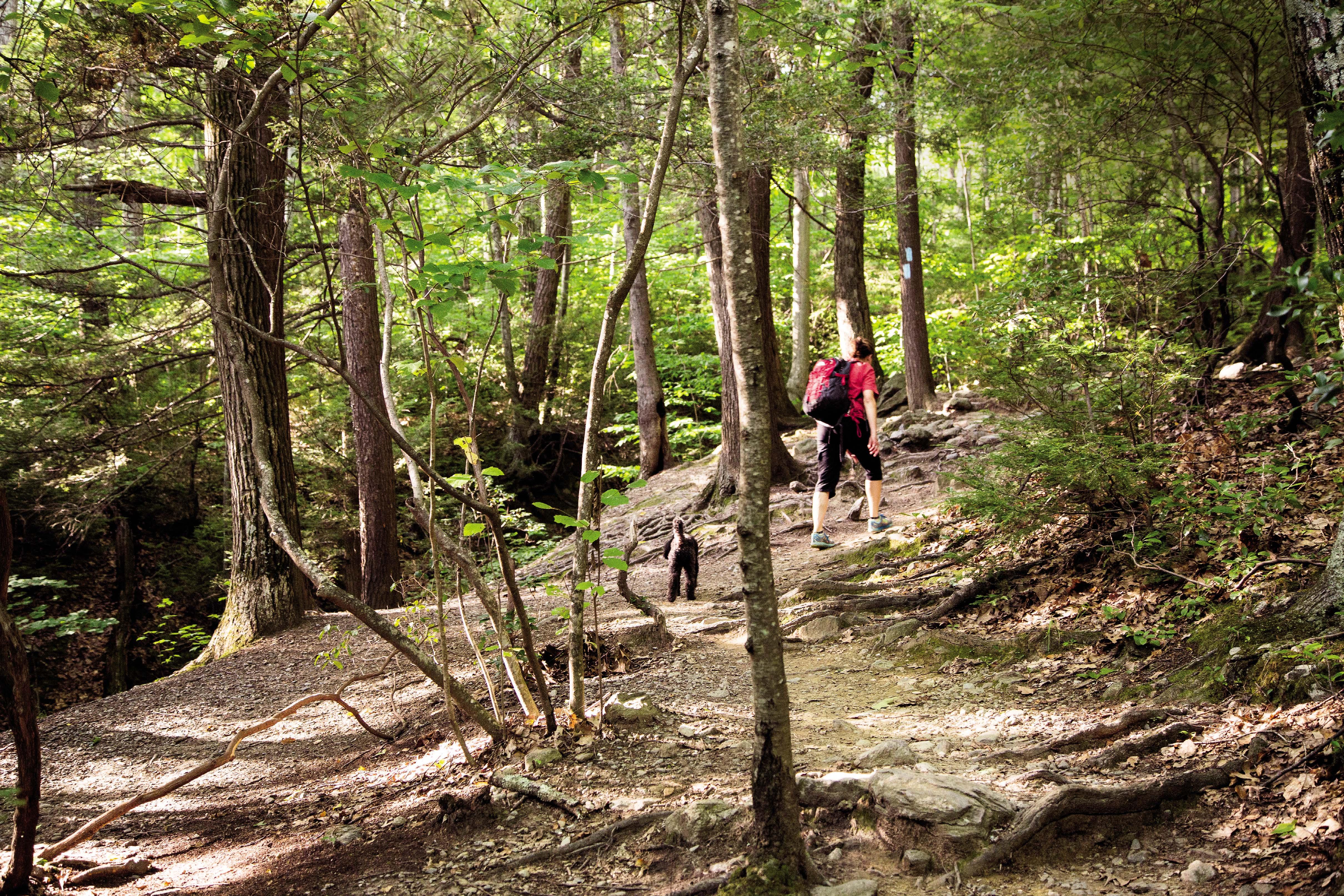
It’s been decades since my “thru-hike,” but I am still a changed person, one who pauses with surprise at water coming out of a tap. One who doesn’t care about rain or stale bread, who doesn’t wish for new carpeting, shiny cars, or cruises. Any point along the AT delivers that power. It pulls people back to simplicity. That makes the AT different from any other trail in the East. I don’t have time for more than a three-hour round trip today, yet I know that is enough for the AT to reconnect me.
At Riga Junction, I stare up at a giant signboard of faded and chipped light-green paint with routed yellow letters. A million people have gaped up at this sign:
Appalachian Trail South North
A world-famous walk leads back into the past— and deep into a hiker’s soul.On the Undermountain Trail with her poodle, Talley, Christine Woodside treks toward its intersection with the Appalachian Trail. RIGHT : Woodside and her husband, Nat Eddy, on the AT 30 years ago. COURTESY OF THE AUTHOR (VINTAGE PHOTOGRAPH) PHOTOGRAPHS BY JULIE BIDWELL
If I turn right and walk for two months or so, I will reach the placid rumble of Maine landscape and the giant massif Katahdin, where the trail ends. If I point my scuffed leather boots in the other direction for, oh, three months, I will stumble into former gold-mining country and onto the treed top of Springer Mountain in northwestern Georgia.
I turn right. I jig from rock to mud. As soon as I start, I have no name, send no texts, make no lists; I’m just leaping across a jumble of sediments that 450 million years ago tumbled this rock onto older marble and other material. Riga Mountain, as the locals call it, is Connecticut’s only example of this geologic drama. The first blackfly of the year heads for my eye.
Sitting quietly on a mount of rock that once was a fire tower foundation, a grizzled man in a red sweatshirt, hood up, stares out over the green fields and the Twin Lakes of Salis-
ing out anymore, so I decided I would prove this theory wrong. Of course I chose this rocky, open ridge up here near the Connecticut-Massachusetts border. But on the way in, I scared her: We’d left late, dark came, she wanted
bury, called Washinee and Washining. We get to talking. His name is Joel Blumert, he’s a guitarist and singer, and he’s been climbing the Undermountain Trail onto the AT and to the top of Bear Mountain for decades. Two years ago, he promised himself he’d climb it once a week for a year. At the end of the year, he bumped it to twice a week, indefinitely.
He’s met long-distance hikers up here a lot. I’m not surprised by how easily we talk. That’s the way it is on the AT. Pretension vanishes.
I meet again, in memory, all sorts of pilgrims I’ve encountered on trips up here.
Once I took a radio reporter up onto this ridge. She’d read that fewer hikers were carrying gear and sleep-
to stop, and I said no, we had to reach a certain campsite with a locking metal box that bears could not break into. That quieted her. It also cemented our friendship.
The next morning, we encountered a soft-spoken man followed by his Welsh corgi. “I find God out here,” he said.
We met a man and a woman from New Zealand thru-hiking the AT in honor of her 60th birthday. She asked why she wasn’t seeing more animals. I considered assuring her that hawks and fisher-cats and coyotes and newts and black snakes and the rest were hiding from the procession of hikers, perhaps only a few feet back from the trodden dirt. But I didn’t have to explain anything to anyone.
I repaired a relationship up here. I followed him, watching his strong legs in baggy blue gaiters fade in and out of fog, sliding over wet rocks. He picked me blueberries on the ridge. That night we camped near a group of boys who were part of a state program for juvenile delinquents. As their mentors stirred a vat of stew, the boys asked if they could meet our poodle, Talley. I could see that they were nervous out here, and they could see that I wasn’t.
I’ve been hiking on the AT for so many years that these memory companions make a crowd. But it doesn’t feel crowded. And I always forget what I have to do after I go back down the mountain. The sun begins to sink. I must go down. I jump from rock to rock.
The Undermountain Trail leaves Route 41 north of Salisbury, CT, and intersects the Appalachian Trail roughly 2 miles up; almost another mile on the AT leads to the summit of Bear Mountain.

The trail taught me that I could press on through weather, pain, and exhaustion. I grew up here.With the Appalachian Trail’s increasing popularity, the experience of hiking it has changed dramatically since Woodside’s 1987 trek. But its power to transport her is as strong as ever, she says.
With a satiny luster and sheen, our 10-11mm pearls resemble sought-after South Sea pearls with rich hues and substantial size. Beautifully crafted with dozens of genuine cultured freshwater pearls and a ne 14kt gold ligree clasp, our timeless strand delivers the look you desire at a price sure to delight.

$150 Signature Pearl Necklace with 14kt Gold Clasp 10-11mm pearls. 18" length. Also available in black item #469070.
Ross-Simons Item #469069
Free Shipping. To receive this special offer, use offer code: PEARL106
1.800.556.7376 or visit www.ross-simons.com/PEARL

On any list of today’s most prolific inventors, Dean Kamen’s name would be slotted near the top: The Bedford, New Hampshire, resident is the brains behind such things as insulin pumps and all-terrain electric wheelchairs. He is also, for good or ill, the man who gave us the Segway PT, the selfbalancing, battery-powered scooter that doubles as cuttingedge transportation and cultural punch line. After it debuted in 2001 with a $5,000 price tag, consumer sales flopped— as did some high-profile riders (President George W. Bush and Piers Morgan took tumbles early on; more seriously, in 2010 the company’s new owner, James Heselden, died after accidentally riding off a cliff). However, this so-called personal transporter found second life in police and private security fleets. Tour operators also recognized its potential, and these days more than 1 million Segway-mounted visitors can be seen puttering about cities worldwide—with helmets firmly fastened, of course. —Heather
Tourgee



If you’re tired of having your outdoor enjoyment rained on...baked out...or just plain ruined by unpredictable weather...
At last there is a solution! One that lets you take control of the weather on your deck or patio, while saving on energy bills! It’s the incredible SunSetter Retractable Awning! A simple...easy-to-use...& affordable way to outsmart the weather and start enjoying your deck or patio more...rain or shine!

The SunSetter is like adding a whole extra outdoor room to your home... giving you instant protection from glaring sun...or light showers! Plus it’s incredibly easy to use...opening & closing effortlessly in less than 60 seconds!
So, stop struggling with the weather... & start enjoying your deck or patio more!

For a FREE Info Kit & DVD email your name & address to freedvd@sunsetter.com

he weather is getting warmer every day, it seems, and there’s still plenty of good snow. But for some reason a lot of skiers have hung up their boots for the year. Why not take advantage of the sunshine, short lines, and off-season rates?
On February 21, 1985, it was 14 degrees with flurries at Killington Ski Resort in Vermont, and there were more than 11,000 skiers. On April 21, 1985, it was 40 degrees, and there were barely 2,000.
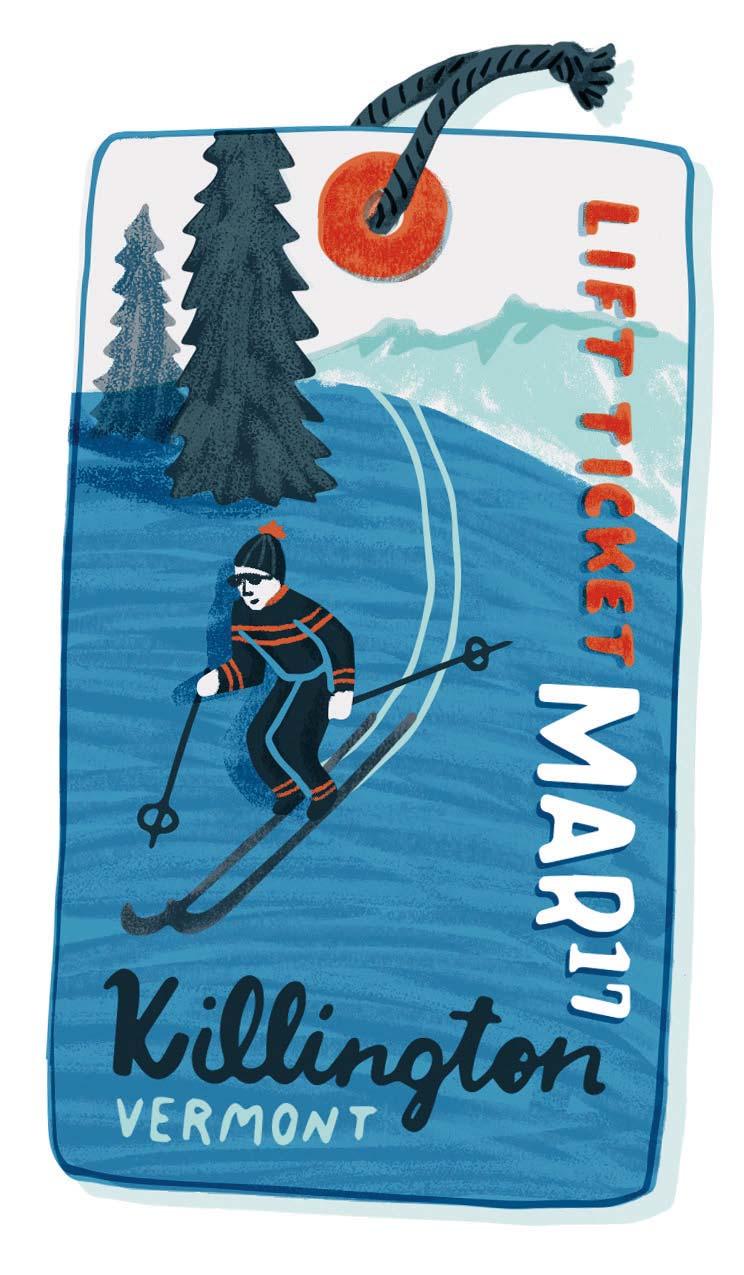
As for me, spring is now my favorite time. The sun comes out, the ice and lift lines disappear, and the amusement picks up, as the people who do show up take to wearing downright silly clothes.
Man-made snow melts slower than the real stuff, and Killington makes lots of its own. April snow is much different from February snow yet still affords great skiing. Some have likened April’s slopes to skiing on a Slurpee, which makes falls wet—but less bruising.
—Charlotte Perkins Gilman (1860–1935). Born in Hartford, Connecticut, Gilman is best known for her short story “The Yellow Wallpaper,” which since being published 125 years ago has become an early feminist classic. As both writer and lecturer Gilman dedicated herself to social reform—a natural calling, perhaps, for the grandniece of Harriet Beecher Stowe, whom Gilman joined in the Women’s Hall of Fame in 1994.

“Each generation of young people should be to the world like a vast reserve force to a tired army. They should lift the world forward.”—Adapted from “Spring Skiing Blooms Again,” by Rollin Riggs (March 1986)
Compiled by Julia Shipley
20th Anniversary that Good Will Hunting marks this year (released 12/5/97)
40

Estimated number of pages in Damon’s oneact play, written at Harvard, that inspired the screenplay
46 Combined ages of Matt Damon and Ben Affleck when they sold their screenplay
one

Number of movie scenes taken verbatim from Damon’s play (the scene in which Will meets psychologist Sean Maguire)
$600,000


Amount that Damon and Affleck each received for the script
$10,000
Amount that Damon and Affleck paid the friend who came up with the movie’s title
nine

Number of weeks spent filming Good Will Hunting
FOUR Number of years between the script’s completion and the first day of shooting
2
Number of Oscar wins (best supporting actor and best screenplay)
$10 million
Amount Good Will Hunting cost to make $226 million Amount it has grossed to date

ive in an old New England home long enough, and you’ll hear the rattle and roll of what sounds like a game of acorn hockey being played directly over your head—or, worse, the subtle sound of burrowing that, once you’ve focused on it, seems to echo incessantly through a quiet house. If squirrels have claimed your attic as their home, removal expert and wildlife biologist Bob Noviello of Windham, New Hampshire, is happy to offer some advice on how to evict your uninvited guests.
If a squirrel breaks into your house, Noviello says, it’s usually looking for a place to give birth. A female squirrel can have a litter of three or four babies twice a year: once in late summer, once in winter. Baby squirrels are weaned in about 10 weeks.
While squirrels are perfectly capable of building their own nests, they often prefer to look for an existing shelter to use. Like bats and other occasional home invaders, squirrels are able to detect minute variations in air pressure that indicate the presence of a gap or void in a structure. They love attics because they’re protected and warm, and there’s storage space

and often food. Attics offer lots of options for chewing, too, like beams, wires, ducts, and even pipes.
Squirrels typically don’t carry diseases that harm humans; however, they are known to carry potentially disease-bearing parasites. Squirrels also leave droppings, which pose health risks such as leptospirosis and salmonella. More urgently: Squirrels can create a major fire hazard if they chew on a home’s electrical wires.
Although there are people who claim to have had success with mothballs or repellents that use some kind of predator urine, Noviello says that none of these remedies will consistently drive squirrels away. Highpitched noisemakers don’t do much
there; it’ll try to find its way back to familiar territory and its food supply, exposing it to predators and traffic and all manner of distress. “Nobody likes to hear it,” Noviello says, “but often relocation kills the animal, one way or another.”
The best way to evict squirrels, Noviello says, is to close up all of your home’s potential critter entry points except one. At that last remaining exit, install an “excluder,” which is essentially a one-way door that will allow squirrels to go out but not to reenter. Be careful, though, not to “exclude” a mother squirrel before her babies have matured. And never close off all openings while squirrels are still inside: They’ll do damage attempting to get out, and may even end up in the living quarters of your home.
The good news, according to Noviello, is that if you can be patient, Mother Nature will do some of the heavy lifting for you. “Wait for them to raise their young in the attic,” he says, “and by late June or early July the heat will drive them out.”
“Little Friends”8”x10”$110 Ltd. edition print
Plan a visit to Mt. Nebo Gallery. We offer a great selection of framed and unframed Will Moses art. Also books, cards and puzzles. Open 7 days a week. Closed major holidays.
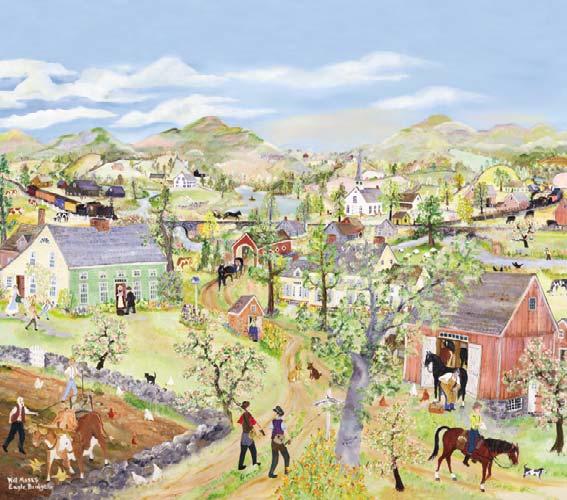

either, and while a strobe light might annoy your furry visitors, they won’t be discouraged for long.
Poisons, on the other hand, may work—but they’re a bad idea for a couple of reasons. First, there are none that specifically target squirrels, so whatever toxic bait you decide to use may well be ignored by the squirrels and end up killing something else. Second, odds are high that if you do poison a squirrel, it will die in your house in a hard-to-reach place. “There are situations where extermination is appropriate,” Noviello says, “but only when it is done humanely by a professional.”
Many think that trapping and relocating the squirrels is the kindest strategy. Noviello disagrees, pointing out that any animal you relocate to the woods won’t simply take up residence
Getting squirrels out of your attic is step one. The ultimate goal, of course, is to keep them out. If the conditions that initially attracted them persist, your squirrels—or their friends— will soon return. To help prevent that from happening, replace any old screens on end vents and repair any areas of rotting wood. (Squirrels are very adept at finding even the smallest of entry points.) Seal up openings with material that will be unpleasant to chew through, like wire mesh or steel wool. However, don’t expect your furry friends to give up without a fight. “Once a squirrel has learned how great it is to live in a house,” Noviello says, “they can get pretty determined.”
ISBN 0-399-24233-5
Book$17.99 “Art
Puzzle$17.25

Getting squirrels out of your attic is step one. The goal, of course, is to keep them out.

LEFT : The cozy “reading porch” outside the library of Jane Goodrich and James Beyor’s loving replica of Kragsyde (the original is shown inset at right).

There was only one way a young couple with little money could build a replica of a storied 19th-century Massachusetts mansion: They had to believe they could.
BY JANE GOODRICHBY BRET
The tale of Kragsyde—and what happened when a young couple first traveled to see the legendary shingled mansion in Manchester-by-the-Sea, Massachusetts—unfolds like an O. Henry short story. Except, that is, the events stretch out for 15 years, as Jane Goodrich and James Beyor re-create the turn-of-the-century beauty from scratch. In the afterword of Goodrich’s forthcoming novel about original Kragsyde owner George Nixon Black, The House at Lobster Cove , she tells her real-life story of encountering Kragsyde and then building the extraordinary replica now perched on Swan’s Island, Maine. —Ed.

oup de foudre , the French say, literally “bolt of lightning” but meaning love at first sight. How better to describe the instant when a chance meeting alters a life? For who can ever expect the sudden place, or glimpse, or turn of the page that will change everything?
I first met Kragsyde in an old box of books my father brought home. I was barely a teen, and paid little attention to the text or the title of the book, but the photographs and drawings gave me goose bumps. These were the most beautiful houses I had ever seen. Not impossible fantasy castles, nor the monotonous ranch-style structures of my own time. Shingled and playful and shaggy, like a favorite dog, full of mysterious rooms placed at odd angles. Fanciful windows I longed to peer from, deep cool porches, turrets with pennants flying from spires, promising endless summers. And the names: Grasshead, Sunset Hall, Wave Crest, Seabright. I studied them all, but even then my eyes could discern the masterpiece: Kragsyde. With its fantastic arch large enough to drive through, its beautiful stones, its romantic perch above the sea, this was the pinnacle. Completely beguiled, I clipped the photograph from the book and pasted it into a scrapbook. The sepia photo, held in my hands for the first time, was both a daydream and a seed.
Seven years later, in 1979, I was working in a sunny window in my college library. I was a sophomore, engaged to be married to a man who was already on his path to becoming a master builder. We often talked about the house he hoped to design and build for us. I was studying graphic arts and photography, but on that day I was awaiting the delivery of several books for an art history project. When the stack slid off the library cart, the top volume, The Shingle Style and the Stick Style , by Vincent Scully, had a familiar photo on its cover. Once again, the attraction was instant. Lightning had struck in the
by-the-Sea, in Massachusetts, to find Kragsyde. We became more excited about our own house plans as we drove, devising ways in which elements of the style could be incorporated into our own house. But our
Frances Burnett, that Kragsyde had been torn down in 1929. Sensing our disappointment, she offered to take us to the original site. Rounding the edge of Lobster Cove and seeing the bare cliff top where I had always envisioned the great house standing was like witnessing an extinction.


“The building plans can still be found in the Boston Public Library,” Ms. Burnett told us, consolingly.

In a small diner in Manchester, James and I ate lunch and commiserated. It was an easy first step to our mutual complaints that the world of 19th-century beauty was slipping away, to be replaced by the cheap and poorly crafted. It was frighteningly easier to come to our next wild thought. Why not rebuild Kragsyde? We knew how. It was a leap, a whim, an oath, an ambition, a naïveté, and a motif for the long marriage that followed.
The next day in the Boston Public Library, we encountered our first reality. We never thought about our jeans and longish hair, or our obvious poverty, when we entered the rarebook area where the plans for Kragsyde were housed. It never occurred

to us that simple interest would not be enough of a key to open the archives. But since we had no academic credentials, the vault remained closed. “You might want to call the man who donated the plans,” the librarian suggested.
Wheaton Holden, professor of architectural history at Northeastern University, was an expert on Kragsyde’s architects, Peabody & Stearns. As an educator, he was also no doubt accustomed to youthful exuberance and possessed the wisdom to foster it.


“We’re going to rebuild Kragsyde!” I told him over the phone when I reached him that day.
“I think that’s just great,” he replied.
In a matter of weeks he gave us copies of the plans and all the relevant photographs and drawings he’d amassed in his years of research. If Kragsyde was a seed planted in my childhood, it was Wheaton Holden who watered it.
By 1982, when I graduated, we’d saved as much money as we could, built a little model of the house, and bought an affordable seaside property in a too-small town in Maine. The daydream was about to be replaced by work—15 years of it, performed entirely by us, mostly on nights and weekends after coming home from our day jobs. We embraced it with diligence and no small dose of delight, using old techniques and traditional materials. As finances waxed and waned, the progress was sometimes slow, but each month brought advances and
Seeing is believing. Microsun™ lamps produce vibrant light that makes it easier for people to read, work on a laptop, or do needlework. Our lamps reduce glare and eye strain by delivering light that’s as natural feeling as the sun itself, so that you can spend more time doing the things you love. See what you’ve been missing with a Microsun lamp.


Why is Microsun the world’s best reading lamp? Just look under the shade. Our patented Microsun lighting system combines full spectrum rare earth metals with unique LEDs to help you see more vivid contrast and brighter colors. The Microsun light source is an electronically controlled Halide-LED system that uses a mere 90 watts of power, yet produces an incredible 7000 lumens! No other lamp features this revolutionary technology.
Patented** Halide/LED lighting system


























Proprietary Microsun bulb













Uniquely brilliant lighting
Two SunStyle™ LED bulbs













Warm ambient lighting




Three light levels
Choose Halide, LED, or both



“My eyes aren’t what they used to be–this is like reading in sunlight!”
– Susan A., Long Valley, NJ
hard-won satisfaction in seeing the sepia photograph become tangible, as beautiful in our own century as it was in the century it was designed. We could look out the fanciful windows and walk under the fabulous, legendary arch, and we had built them ourselves.
Together with a college classmate named James van Pernis, Goodrich launched Saturn Press in 1986, producing greeting cards and stationery printed on antique presses. Her “day job” was paralleling the evening work of resurrecting traditional construction methods. At the same time, Goodrich found herself becoming increasingly fascinated with George Nixon Black, the original owner of Kragsyde.
To my 19-year-old self, George Nixon Black was no more than the original owner of Kragsyde, but as we rebuilt his house, I felt his ghost in every corner. It took 10 years of research on this elusive man to realize his life was as romantic and compelling as the house he occupied, and that his was a story worthy of being told.… The curious thing was how in searching for Black, I also found myself.
And in that seeking, she recalls, a bit of ephemera floated up from the past:
It came from the Manchester Historical Society, and from the pen of Frances Burnett, the docent who was the first person we met on our long journey. Buried in their archives was a copy of a letter she’d written in reply to someone who had sent her a newspaper article about our rebuilding of Kragsyde:
“I well remember this young couple who visited the Society back in 1979. I took them to the site of the old
house and told them it had been torn down. They had an old rattletrap car and I remember wondering how they could ever contemplate building such a mansion, but they have done it, and more power to them.”

In fact, we never went back to the Boston Public Library to see the plans; with the help of Wheaton Holden, there was no need. Yet even though I never laid eyes on those original elevations, I know every line of the house. How could I not, after building it, after laying the rafters of those familiar roof lines, and mixing the mortar for the enormous chimneys?
I know how the shingles travel the eaves, and where the snow builds up in those valleys. I know both its past and its present. The huge shadowed porch where Black played billiards, where I today hang a hammock, and the bow window where I find a sunny place for a blue and white bowl of flowers.
Adapted from the afterword of The House at Lobster Cove , a novel about George Nixon Black by Jane Goodrich, to be published this spring by Applewood Books. To learn more, go to houseatlobstercove.com.






























are HANDMADE using the finest quality ingredients, and are fully cooked before packaging. One dozen delicious pierogi are nestled in a tray, making a one pound package of pure enjoyment!


You can get Millie’s Pierogi with these




Turns any day into an occasion – order today!


Our Timeline Growth Rules are hand crafted in Maine using traditional materials and methods continuously practiced since 1869. The rules are heirloom quality. Each 6ft 6in blade is milled from select Sugar Maple, markings are engraved into the blades and filled with pigment, and the inlaid ends are machined from solid brass.
Record your child’s growth as it happens directly onto the face of the rule and record milestones and special events on the back.

Your child’s formative years pass quickly. The growth and personal history recorded on the rule will become a symbol and celebration of your child, a memento made more precious by time.
A truly unique shower gift or birth acknowledgement.

$79 .00
Shipped free in contiguous 48 states




SKOWHEGAN WOODEN RULE, INC. (207) 474-0953
www.skowheganwoodenrule.com


 Craig Altobello ( RIGHT) launched his woodworking career after taking a 1978 workshop with Thomas Moser; today he specializes in the painstaking art of marquetry, as seen on this page.
Craig Altobello ( RIGHT) launched his woodworking career after taking a 1978 workshop with Thomas Moser; today he specializes in the painstaking art of marquetry, as seen on this page.
 BY ANNIE GRAVES
BY ANNIE GRAVES
slice of walnut wood suggests a dark mountain, outlined against a rippling sky of spruce. Chickadees rendered with bits of black acacia flit across a background of pale sugar maple. A heron poses, a study in
the sky, but if I
“This” is a 2-by-6-inch plank of common spruce from the local lumberyard in Peterborough, New Hampshire, where Altobello has lived for the past 26 years. He has shaved off a 1⁄16 -inch slice from this plank and, with the skilled eye and hand of a practiced marquetry artist, coaxed the illusion of a pale-streaked sky from the whims and tempests of nature embedded in the wood. Using its grain and color to best advantage, Altobello has created a sky from spruce.
“I cut each layer of the same piece of wood, sometimes to the third or fourth slice. Each layer is different— but I know it when I see it. That one,” he says, holding it out to me, “suggests ‘sky.’ My palette is the wood. I’m trying to tune in to create a painterly look.”
Once he’s chosen his background, Altobello sets to work sifting through bins of thin veneers to find just the right pieces to, say, craft a kingfisher’s head, or lay out the foreground in a mountain landscape, or create the delicate wings of a dragonfly. The colors, the textures, the varieties of wood are dizzying—a palette of infinite possibilities. Or perhaps he’s simply freeing scenes and images already inside the wood.
In theory, the art of marquetry is similar to that of inlay, with cutout pieces of wood being used to create pictures. In practice, the two are fundamentally different: Where inlay
features wood laid into carved-out trenches, a work of marquetry is created independent of a base, more like a puzzle of perfectly fitting pieces that is finally mounted on a piece of Baltic birch plywood that goes unseen. “Marquetry is more versatile,” Altobello explains. “With inlay you can rarely get the edges so perfect.”
Perfection and play seem equal partners in Altobello’s garage workshop. Tidy, well-organized bins of thinly sliced woods are arranged by color. The woods themselves can sound like bit players in a Wizard of Oz sequel: spalted sugar maple, cherry burl, baked poplar, wenge. The equipment is just as multifarious, from a lovely cherry hand plane made by Altobello to the large DeWalt scroll saw he calls his most important piece of equipment. Though imposing, this saw is “the opposite of intimidating,” he says. “It’s like a sewing machine.”
With it, he cuts the pieces that will all fall into place as a mountain scene or a bird caught midflight. From start to finish, an image can take up to a week to create.
He shows me a piece from the White Mountain series he’s working on, this one called Morning from Zealand Falls Hut , with Mount Kerrigan and Kerrigan Notch in the background. “I do a lot of hiking in the White Mountains,” he says thoughtfully. “I’ve hiked since I was child. It’s where my passion lies the most, so to do artwork based on hiking experiences is dear to me.”
Most of the mountain is rendered in shades of walnut that Altobello found in a lumberyard near Exeter. Creamy baked poplar from a lumberyard in Kingston suggests the mountain on the right. The silhouetted fir trees are made of wenge, a dark African wood with delicate zebra-
like stripes. (Though Altobello tends to favor local wood, when he does use exotics he looks for Forest Stewardship Council–certified pieces or scraps from other woodworkers.)

Is it a coincidence that Craig Altobello’s last name translates as “high beauty”? I’m still caught up in the unfinished mountain scene as he describes his latest idea for a series, depicting the old White Mountain high huts that are no longer there.
His eyes light up, and he’s off, riffling through one of the bins: “I’ve got a piece of wood over here....”
Prices vary: $125–$250 for 5½"x5½" autumn leaves; $375 for small birds; $4,000 for triptych. Altobello’s work is carried at the Sharon Arts Center, Peterborough, NH, and Artisans Way, Concord, MA. For more information, call 603-924-8522 or go to craigaltobello.com.
The timeless rope chain is once again in the trend spotlight. We’ve made the standard sublime by spiraling and twisting this classic for a fresh new look. Crafted in Italy by expert silversmiths, our exclusive design has a rich polished nish that highlights every curve.

$89 Italian Sterling Twisted Rope Chain
Sterling silver. 18" length. Graduates to 3 8" wide. Lobster clasp. Enlarged to show detail. Also available in 20" length $99.
Ross-Simons Item #873338
Free Shipping. To receive this special offer, use offer code: ROPE40 1.800.556.7376 or visit www.ross-simons.com/ROPE
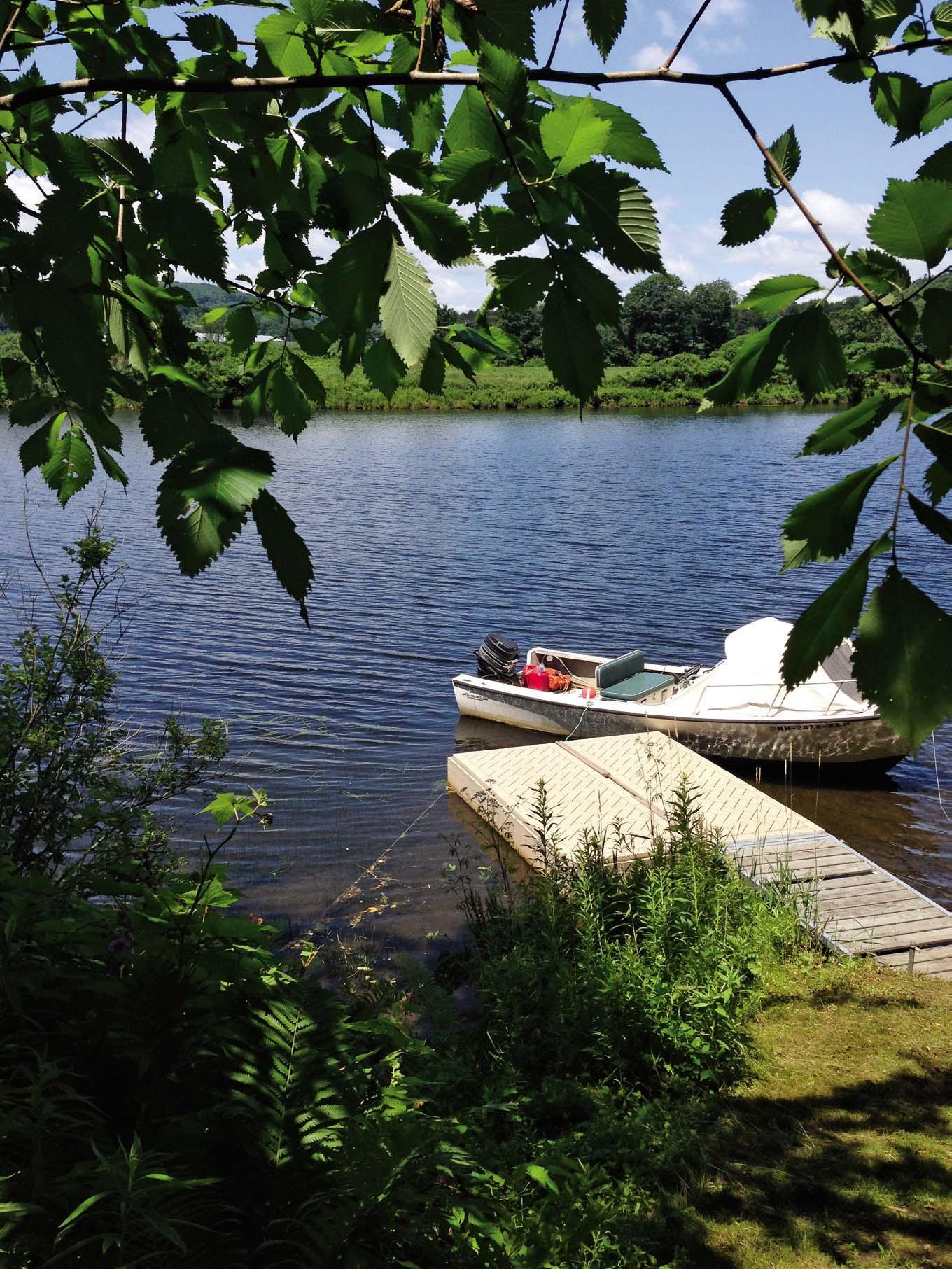
Yankee likes to mosey around and see, out of editorial curiosity, what you can turn up when you go house hunting. We have no stake in the sale whatsoever and would decline it if offered.
o be honest, we didn’t expect much when we accepted an invitation from a young (judging by the photos she sent us) woman to visit the Connecticut River property she’d recently placed on the market. Maybe it was the price, $398,500, that put us off a bit. Most properties on the Connecticut that we know about are worth millions. There must be something wrong with hers, we thought. But her letter describing the trials and tribulations of building on a steep bank above the river back in 2004 was intriguing, and, well, we decided to have a look.
Our attitude totally changed the minute we pulled off Route 10 in Orford and into a parking area in front of a charming-looking contemporary eight-room Cape. The woman waiting for us on the cement sidewalk leading to the house introduced herself as Lynne Fenoff, our correspondent. As expected, she was young, at least to us oldsters.
Lynne led us onto a spacious, brand-new deck overlooking the river and then into a spectacular living/dining/kitchen area with artistically constructed stairs curving up to a bedroom loft. On the ground floor below was the expansive master bedroom and bath, and everywhere, on all three levels, were windows with sweeping views of the river. From several of these windows we noted a substantial grassy road running down to a dock, to which a small motorboat was tethered. So, despite our initial worries about the low asking price, there was certainly nothing wrong with this property. On the contrary, we absolutely loved it.
After hearing Lynne’s story, we had one question: Why in the world would she want to sell? Her answer: pure romance.

For the next hour or so we relaxed on the deck while Lynne told us how she came to create her riverside home. Obviously, it wasn’t always easy…
Lynne: “Growing up in Tewksbury, Massachusetts, I always loved being on or near water. Then, in my twenties, single and working two jobs, I purchased my first home—in Littleton, New Hampshire. It wasn’t on the water, but I could walk to the Connecticut River, and I bought my first kayak. As the years went on, I decided I would love to own property actually on the river and attempted many times to purchase land or a fixer-upper. But everything on the Connecticut was way beyond anything I could manage.

“Then one day I came across this 1-acre lot in Orford, and as usual I made an offer, expecting nothing. But much to my surprise, it was accepted! Shortly afterward I designed this home simply from pictures of homes I admired, and soon my sketches were ready for a builder. It would have large windows facing the river and be completely wheelchair-accessible for my brother-in-law, Ed Clark, who is paralyzed from a long-ago car accident. I wanted him and his wife, Karen, to be able to enjoy my home too.
“My friend, Lee Foster, a retired contractor, offered to build it at a price I could afford—if he could park his huge motor home here so he and his
wife could enjoy being on the river during the building process. All went well, but then came the difficult— and expensive—stuff. I needed to hire a plumber, a well contractor, an electrician, and so forth. The most challenging project was the building of a road down to the water suitable for my brother-in-law in a Jeep.
Building her own home allowed Lynne Fenoff to finally afford the riverfront property of her dreams ( ABOVE ) . She designed it herself— from the window-filled exterior to the modern, open interior ( INSET).We had to comply with a myriad of regulations of the state’s Connecticut River Shoreland Protection Act designed to avoid any erosion of the riverbanks.
“I somehow managed to persevere through it all and eventually sold my house in Littleton and made this my house. Almost every day after work [at various times, Lynne worked at Dartmouth College and nearby Rivendell Academy], I’d come home, take a paddle, and then relax on my dock or up here on the deck with perhaps a glass of wine, watching boaters cruise by. Occasionally I would see a deer swimming over to the opposite shore. It was heaven.”
After hearing Lynne’s story, we had one important question: Why in the world would she want to sell this house? Her answer: pure romance. “About two years ago, I happened to meet a special someone by the name of Ron Fenoff who owns and operates an excavation business. [Ron was away at work on the day of our visit with Lynne.] And guess what? We got married! I now work with him, doing his surveying and pretty much all his computer stuff. He doesn’t like computer stuff. And he persuaded me to live with him on the other side of the river, in Waterford, Vermont, in a mountaintop house he built that ‘looks like it fell out of the sky,’ as he says.”
Eventually, Lynne added, they’ll retire on land they’ve already purchased in Florida. Well, we said, when the Florida part of her story actually comes to pass, we’d love to mosey over to that mountaintop on the Vermont side of the river and write about a house that “looks like it fell out of the sky.”
Lynne promised she would stay in touch.

















Celebrating life in New England at some of the region’s best events
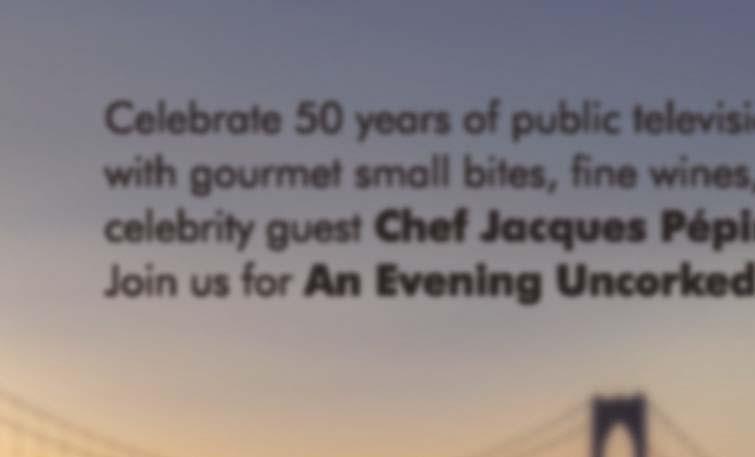







YankeeMagazine editors, partners, and advertisers celebrated Yankee’s holiday issue’s“Christmas in Boston” cover story with an event at Island Creek Oyster Bar in Boston’s Kenmore Square and opening night of the Boston Symphony Orchestra’s Holiday Pops season on November 30th.


www.islandcreekoysterbar.com





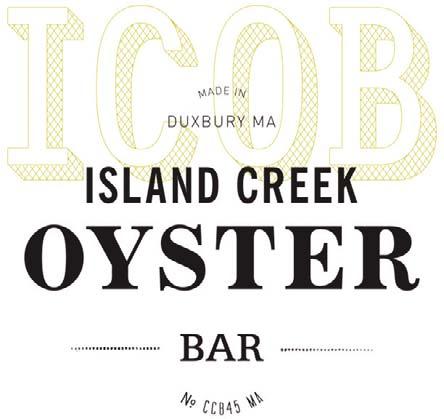
www.bso.org




















































n Martha’s Vineyard, a late October cold snap strips away any illusions that the modulating Gulf Stream breezes will keep winter at bay forever. One week it’s roses and a last trip to the beach; the next week it’s frost. The gingerbread cottages at the Martha’s Vineyard Camp Meeting Association are mostly closed up now, as are the Oak Bluffs arcade and the Flying Horses Carousel that so recently thrummed with vacationing children. Circuit Avenue is eerily quiet, though Linda Jean’s is still serving up breakfast sandwiches and morning gossip for the real residents, the ones who stick around even after the winds turn bitter and damp.
I am here with the last of the tourists to capture these final beautiful days for our new public television series with WGBH, Weekends with Yankee (debuting in April; check local listings). It’s not quite dawn, and looking out my hotel window I see a thin line of orange light cracking the horizon over Nantucket Sound. A cold wind is whistling around the window frame, and I’m thinking I should’ve packed warmer socks.
Down in the lobby, I grab a Linda Jean’s sandwich from WGBH associate producer
Adrienne Rahn, who has made a 6:30 run to pick up breakfast for our small crew. Call time is 7, and we sip coffee and wonder how chilly it will be on the water. At about 7:30 we’ll board the 36-foot fishing boat Payback , out of Edgartown Harbor, to dredge sweet bay scallops from Cape Poge Bay. I’ll be cooking on the boat—or at least prepping raw scallops with citrus and chilies, in the style of an Italian crudo. So despite the poor sleep and thin socks, I’m buzzing. It’s another day of adventure, another day of making television.



Down at the Edgartown docks, we wait. This, I’m learning, is how TV works. We wait for the director, Rennik Soholt, to pre-interview the boat’s captain (Rennik wants us to meet him for the first time on-camera, so that it feels more authentic). We wait for Alan Weeks, the director of cinematography, to adjust his camera settings every time a cloud passes over the sun or to reset a shot from a different angle. It’s fine. We are filming in the most beautiful places in New England, destinations we mapped out over many months with the idea that the series would bring viewers the best of the best. It’s as if we’ve jumped into the pages of Yankee itself. And Richard Wiese, the show’s host—you may know him from his other show, PBS’s

Born to Explore —helps pass time by telling stories of hiking Kilimanjaro at age 11, of skiing to the North Pole, of living among Batwa pygmies in Uganda. I’m the food correspondent, so I’m filming just one segment per show, but he’s always there, ready to share a tip (“Once the camera starts rolling, don’t forget to take five steps before you start talking,” he reminds me— multiple times—yet I still forget).
Rennik signals that it’s time to board the boat. Already my feet are cold. The blood from my better-insulated upper
plus gloves, to layer over my down jackets, but it’s a whole other world among the 4-foot swells. And so, a new challenge: speaking with a steady voice when my body is convulsing with cold. The hair I so carefully styled at 6 a.m. is now a swirling rat’s nest at war with an elastic band. Still, this is heaven. Captain shows us how he drops his chain nets down to the bay floor, where they rake over the eelgrass beds where scallops thrive, leaving the grass mostly intact. Rick Karney, a shellfish biologist and director of the Martha’s Vine-
maturity. And when we haul up our first net full of sea life—crabs, whelks, clams, and a few scallops—he points out which ones are too small to harvest. We toss them back into the water.
After several runs—delayed by the need to move the crew to the harbormaster’s boat for a wide shot, to get the right interviews, to find the fertile beds—we have enough mature scallops to start shucking. Captain easily cracks open the shells and yanks out the viscera with a quick flip of a knife blade, leaving the cream-colored knob of adductor muscle to slice out and eat; I pop one into my mouth and taste a creamy sweetness that underscores
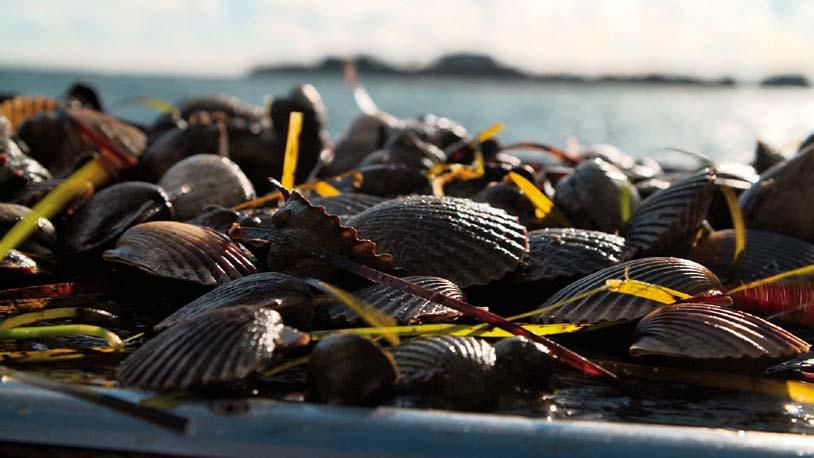


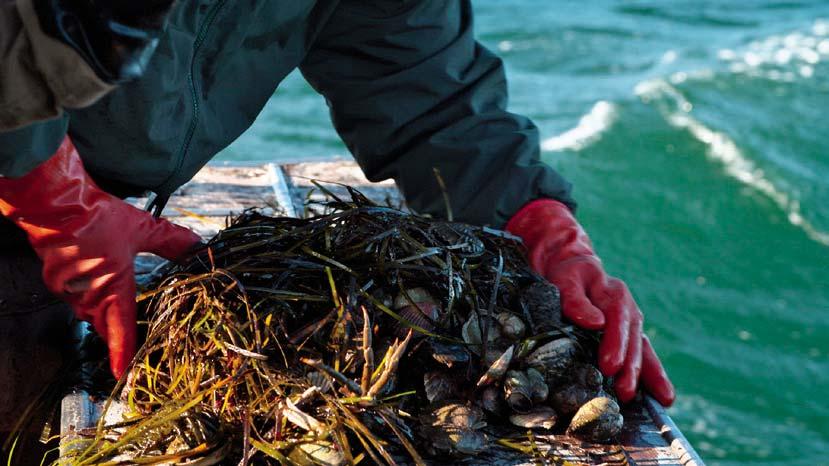

why bay scallops are called “nature’s gumdrops.” With about 40 shucked scallops in hand, I duck into the heated wheelhouse and carve a work space out of a 2-foot shelf. The waves make it difficult to slice evenly, and I have to brace one leg against a bench to stay upright. But I manage to juice two oranges and a lemon, grate some ginger, and arrange the scallops on a plate with the citrus sauce, a little oil, and a sprinkling of chilies, mint, slivered shallots, and sea salt. As crudo should be, the dish is a play on contrasting flavors and textures: hot and cold, silky and crunchy, sweet and sour. The heat from the chilies feels like sunshine. The guys gobble it up— all except Captain, who doesn’t eat scallops raw. Instead, he sets some aside to fry up on a single burner.
Food consumed, we turn around and make our way through the narrow Cape Poge Gut as the tide begins to ebb. Captain has another job to head out to that afternoon, and he’s already given us more time than he had to spare. Back on land, we remove our layers, marveling at all the heat reflecting off the sidewalk, a sensation we wouldn’t have noticed before. “It was a warm day,” Rick assures me. “This is just the beginning of the season.” I wouldn’t dare contradict him. Nor will I ever complain about the price of bay scallops again.
It is the great privilege of journalists to be able to enter the world of a stranger, even live in it for a day or two. Making Weekends with Yankee is a similar experience, only compressed into a high-octane joyride: Today it’s scalloping; tomorrow it might be making cheese in Vermont, baking clams in a remote cove on Mount Desert Island, or cooking on a windjammer in Rockland Harbor. I’m a New England native and have worked at Yankee for nearly 10 years. I’ve covered the region from so many angles, but in making this series I’ve fallen in love with it all over again. If we’ve done our job right, you will too.
The following recipes are just a sampling of the delicious dishes that we
prepared on-camera while filming Weekends with Yankee. For more information, visit the show’s website at weekendswithyankee.com.

TOTAL TIME : 15 MINUTES
H ANDS- ON TIME : 15 MINUTES
Crudo, which means “raw” in Italian, is a preparation in which pristine uncooked seafood is served dressed with citrus, good olive oil, and sea salt (additional seasonings optional). Unlike ceviche, in which the fish “cooks” in citrus juice for several hours, crudo is a last-minute preparation meant to highlight contrasting flavors. I
made this variation aboard the Payback , using scallops just pulled from the sea. As always, you should consume raw fish purchased only from trustworthy sources.
1 serrano chili pepper (or ½ jalapeño)
1 small shallot
Juice of 1½ oranges
Juice of 1 lemon
1 piece fresh ginger root, ½-inch long, peeled ½ pound fresh bay scallops, halved crosswise
2 tablespoons extra-virgin olive oil
6 mint leaves, thinly sliced Chili flakes
Sea salt flakes
Cut the pepper in half and use a straw or chopstick to scoop out the inner seeds and membrane. Next, slice both pepper and shallot into paper-thin slices (a mandolin is a great tool here).

In a small bowl, whisk together the citrus juices. Grate the ginger root into the juice with a Microplane or other fine grater to extract the juice and some pulp, but not the root’s coarse fibers. Whisk to combine.
Divide the scallops among 4 salad plates. Pour the citrus dress-
ing around the scallops, then drizzle with olive oil. Sprinkle with pepper slices, shallot slices, and mint leaves. Sprinkle with chili flakes and sea salt to taste. Serve immediately. Yields 4 appetizer servings
I came by my next seafood feast with far less feigned machismo: While Richard boarded a boat in the early morning with Jay Baker of Fat Dog Shellfish, an oyster farm in New Hampshire’s Great Bay, I slept in
(there wasn’t room on the boat, alas). Around midmorning, we met up at Row 34, the Granite State outpost of the popular Boston oyster bar, where we prepared a fresh take on oyster stew with chef-owner Jeremy Sewall. While I’ll admit I’m a serious apple lover—I wrote a book on the subject— it never once occurred to me to combine apples and oysters. But Jeremy used diced apples as a garnish to delicious effect, adding fennel, thyme, celery, and onion as complementary notes. When he served up the stew in widerimmed bowls over toasted sourdough bread, I savored every bite, despite the total absence of suffering.
OYSTER STEW
TOTAL TIME : 40 MINUTES
H ANDS- ON TIME : 40 MINUTES
2 tablespoons unsalted butter
1 rib celery, thinly sliced, leaves reserved
1 fennel stalk, thinly sliced, fronds reserved
1 small onion, diced
¼ cup dry white wine, such as pinot grigio
2 cups heavy cream
1 bay leaf
3 stems fresh thyme
16 medium oysters, any variety, shucked, with ½ cup oyster liqueur (juice) reserved
Juice of 1 lemon
Salt and freshly ground pepper, to taste
4 slices of sourdough bread
1 tart apple, finely diced
In a medium sauté pan over mediumhigh heat, melt the butter and add the celery, fennel, and onion. Cook, stirring, until the vegetables are translucent, 5 to 6 minutes. Add the white wine and bring to a boil. Turn down the heat and simmer for 3 minutes, then add the cream, bay leaf, and thyme. Continue to simmer until the cream is reduced by almost half.
Add the oysters and their liqueur and bring the stew back up to a simmer. Warm the oysters through, 2 to 4 minutes. Remove pan from heat and let sit for 30 seconds. Season to taste with lemon juice, salt, and pepper.
Lightly toast the sourdough, then place each slice in a small shallow bowl. Spoon the oyster stew over the bread. Garnish with diced apple, fennel fronds, and celery leaves. Enjoy warm. Yields 4 servings.
Allison Hooper is well known among New Englanders who love great cheese and butter. Her company, Vermont Creamery, produces more than 4 million pounds of fresh and aged cheeses, crème fraîche, butter, and other dairy products. You may also recognize her from the pages of Yankee : Our May/ June 2016 issue told the story of Allison and her business partner, Bob Reese, and their newest venture, a model farm called Ayers Brook Goat Dairy, where they work to develop healthier goat breeds and best practices. The goal? To produce milk for the creamery and offer Vermont dairy farmers struggling with the volatile milk commodity market a sustainable alternative to raising cows.
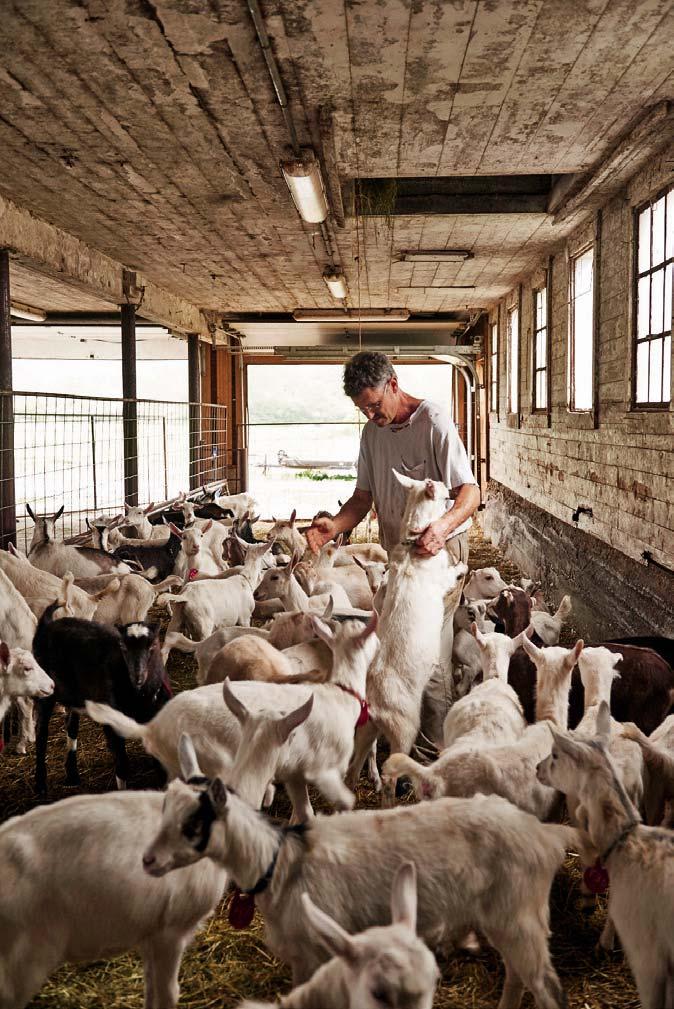

When we visited Allison, we began the day at Ayers Brook, where we were greeted by a herd of 500 beguiling Saanens, LaManchas, and Alpines, then headed north to tour Vermont Creamery’s 14,000-squarefoot cheese-making facility in Websterville. Donning hair nets and sanitation suits, we moved from one


atmosphere-controlled room to the next, each calibrated to optimize milk culturing, curd development, and cheese ripening. Finally, we decamped to Allison’s hillside farm in nearby Brookfield—home to the original milk house where the company began more than 30 years ago— to make a delicious savory tart with her own products. We cooked together and shared stories. It was dark by the time we pulled the sweetsavory tart from the oven, a cozy fall evening enriched with a deeper understanding of what farm-to-table really means.
TOTAL TIME : 2 HOURS
H ANDS- ON TIME : 40 MINUTES
FOR THE CRUST
2 cups all-purpose flour, plus more for counter
2 sticks cold unsalted butter, cut into small cubes
¼ teaspoon table salt
2–4 tablespoons ice water
FOR THE FILLING
1 tablespoon salted butter
1 large Vidalia or other sweet onion, diced
12 ounces fresh goat cheese (chèvre)
¾ cup milk
1 large egg
2 teaspoons minced fresh sage or 1 teaspoon crumbled dried sage
1 teaspoon kosher salt, plus more to taste
lengthwise, seeded, and sliced into ¼-inch half-moons
½ cup dried cherries or cranberries
FOR THE GARNISH
Toasted pepitas
Heat oven to 350° and set a rack to the lower third position. Make the crust: In the bowl of a food processor, pulse together the flour, butter, and salt until the butter breaks down into peasize bits. Drizzle water into the bowl, and pulse until the dough just comes together—don’t overmix.
Turn the dough out onto a lightly floured counter and knead two or three times to bring it together. Form a ball and flatten it into a disk, then wrap in plastic and chill at least 1 hour (up to overnight).
Next, make the filling: In a medium frying pan over medium-low heat, melt the butter, then add the onion and cook, stirring occasionally, until nicely caramelized, about 20 minutes. Meanwhile, in a medium bowl, combine the goat cheese, milk, egg, sage, salt, and pepper. Stir until smooth.
Add the caramelized onion to the cheese mixture and stir to combine. Set aside to cool.
On a floured surface, roll the dough out to a ¼-inch-thick circle. Transfer the dough to a parchmentlined cookie sheet. Spoon the cheese filling onto the center and spread evenly, leaving a 2-inch border around
the edges. Layer the squash over the filling in concentric circles and sprinkle with dried cherries or cranberries. Gently fold the edges of the dough over the filling, pleating as you go. Transfer to the oven’s lower rack and bake until the squash is tender and the crust is nicely browned, 45 to 50 minutes. Top with a sprinkling of pepitas and cut into thick wedges to serve.
Yields 6 servings.
One of our most dramatic days of shooting happened in Acadia National Park on a lesser-known strip of the northern coast, between Eastern Bay
and Frenchman Bay. We set up a traditional beachside clambake among the rock formations known as the Ovens, which are accessible only at low tide and mostly only by kayak. There is no public parking in this corner of the park, but we were guests of Andrew Taylor, whose family has a house here and who, with partners Arlin Smith and Mike Wiley, owns two of Maine’s most acclaimed restaurants, Eventide Oyster and Hugo’s, both in Portland.
The Ovens are geological marvels, caves carved out of weaker rock exposed to eroding tides. For our clambake we assembled lobster, potatoes,



clams, salt pork, a few eggs (tradition has them acting as a sort of timer for the lobster meat), and Red Snapper hot dogs (a Maine delicacy), building a fire on the beach and cooking the food, layered in seaweed and burlap, on a large steel tray Andrew had fabricated for just this purpose. Time was of the essence, as the tide was heading in while the lobsters were cooking. The rocky ground would soon be under water, and all we could do was wait.

Having spent their adult lives in the compressed heat of restaurant kitchens, Andrew, Arlin, and Mike aren’t

EVENTIDE OYSTER’S BROWN-BUTTER LOBSTER ROLL

Northern Pass would:



• Threaten our natural beauty

• Undermine our region’s commitment to clean energy



• Be paid for by New England ratepayers, not shareholders



NORTHERN PASS IS A BAD DEAL FOR NEW ENGLAND. TOGETHER, WE CAN FIGHT IT.


NoToNorthernPass.com




























/NoToNorthernPass @NOTONP




boston symphony orchestra

inclined to break a sweat—but as the water inched up toward the glowing coals and the seaweed steamed under its burlap cover, they began to fidget. Finally, Andrew called it. They pulled the heavy tray off the fire and carried it over some rocks to higher ground. As they returned to finish cleaning up, a wave washed over the still-hot coals, sending a 12-foot plume of steam into the midday air.
Ravenous, we picked at the food with our bare hands, dipping lobster meat into a rich brown butter sauce that the Eventide team makes by cooking powdered milk with unsalted butter until it takes on a walnut hue. This butter is the base of Eventide’s signature lobster roll, a departure from Maine tradition served on a Chinesestyle steamed bun. We’ve adapted their recipe to serve on regular hot dog buns, but that addictive butter is well worth a try.
TOTAL TIME : 30 MINUTES



H ANDS- ON TIME : 30 MINUTES



8 tablespoons (1 stick)




unsalted butter
2 tablespoons nonfat dried milk powder

1 tablespoon fresh lemon juice




Sea salt or kosher salt, to taste
1 pound cooked Maine lobster meat, cut into medium chunks
4 hot dog buns, steamed
Minced chives
Enjoy classical music with Andris Nelsons and the Boston Symphony Orchestra, joined by world-renowned guest artists, along with concerts featuring the Boston Pops, popular artists, and more, at the idyllic summer home of the Boston Symphony Orchestra.



888-266-1200 • tanglewood.org
In a medium skillet over medium heat, melt the butter. Whisk in the milk powder and cook, stirring often, until the solids begin to brown and take on a nutty aroma. Pour the butter into a bowl and add the lemon juice and salt. Wipe out the skillet and add the butter and lobster meat, cooking until just heated through. Divide lobster evenly among the buns and top with chives; serve warm. Yields 4 servings.
This ornate bracelet was inspired by the jewelry of the storied Byzantine Empire. Created for today by expert Italian craftsmen in gleaming 24kt gold over sterling. A time-honored design beautiful for any occasion and every season.

Made in Italy. 24kt gold over sterling silver. 7" length. 1 4" wide. Lobster clasp. Enlarged to show detail. Also available in 8" $59
Ross-Simons Item #846560
Free Shipping . To receive this special offer, use offer code: EMPIRE206
1.800.556.7376 or visit www.ross-simons.com/EMPIRE


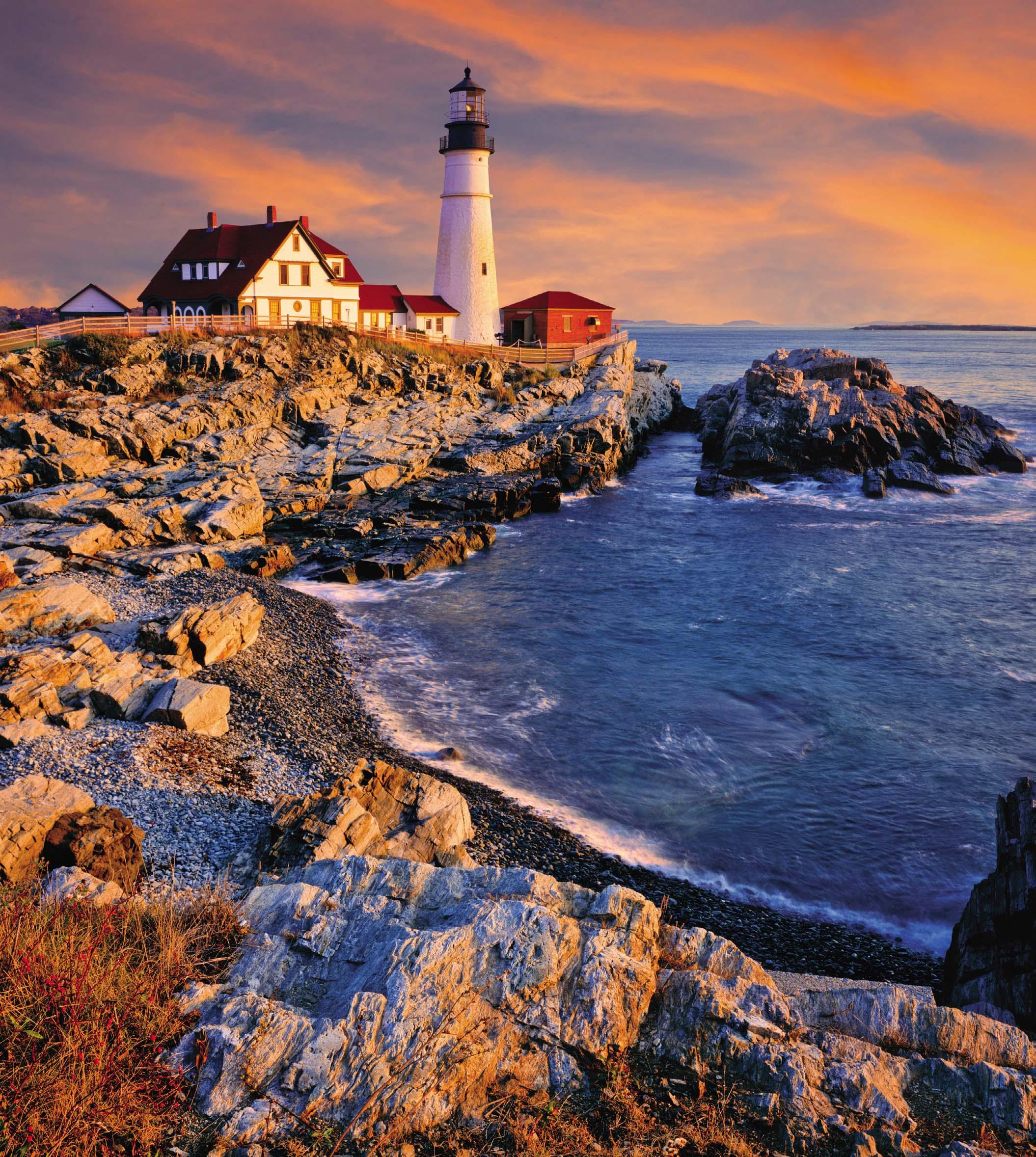


EDITORS OF YANKEE MAGAZINE
A new must-see food, travel, and adventure series that uncovers the best of New England.

Yankee Magazine is teaming up with public television producer WGBH Boston to create Weekends with Yankee, a New England-based travel and lifestyle series. The documentary series will take viewers on an insider’s exploration from city to countryside and far-flung places in New England. Episodes will take place in all six New England states; 13 weekly half-hour episodes are slated to premiere nationally on public television stations in April 2017.
Viewers will be guided through New England by Emmy® Award-winning TV travel host, explorer, and author Richard Wiese. The series will tap into Yankee ’s behind-the-scenes access to the unique attractions that define the region, and the hidden New England that only locals know. Wiese will be joined in his travels by Yankee ’s very own food editor, Amy Traverso, who will share the recipes, local flavors, and sense of community that make up the fabric of the region’s food and dining scene.
NewEngland.com digital editor Aimee Tucker recently spoke to Laurie Donnelly, the series’ senior executive producer, about this new collaboration with Yankee
What inspired you to collaborate with Yankee ?
Laurie Donnelly: Yankee is a New England institution which has been telling the New England story for decades. There is no better partner to capture the people, places, and stories that make up New England. Yankee goes behind the scenes where other people have not been able to go, and they capture
the spirit of New England in a quiet and powerful way. Their stories resonate not only with New Englanders but with people across the country.
What are some of the things you love most about New England and are excited to share as part of the Weekends with Yankee series?
LD: Born in New York and raised in California, I came back to the Northeast for college and never left. From the beaches of Cape Cod to Mt. Katahdin, New England is a place that has always captivated me. The four seasons are unmatched for diversity and beauty, and as a foodie there is nothing better. Nowhere else in the country can you have so many diverse experiences in such a compact area—from the highest mountains to the New England coastline.

Over the course of 13 half-hour episodes, viewers will explore New England with the ultimate tour guide, Weekends with Yankee host Richard Wiese. As a world-class explorer, Richard brings a seasoned traveler’s curiosity and appetite for discovery to his role as the series host and expert guide through New England. He has spent his life traveling the world in search of adventure, but New England is his home, and with this series he’ll be sharing his amazing adventures throughout the region and the best of Yankee Magazine’s insider tips with viewers across the country.

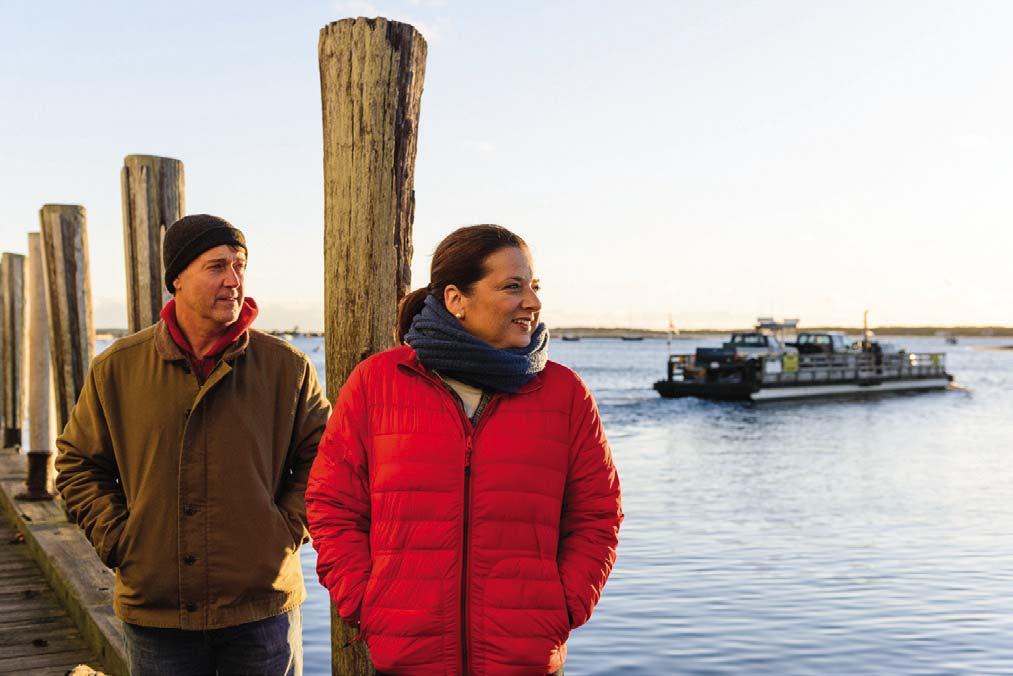
In addition to Weekends with Yankee, Richard is the host of the Emmy Award-winning public television series Born to Explore with Richard Wiese. He is author of the guidebook Born to Explore: How to Be a Backyard Adventurer, and was the youngest person to be elected president of The Explorers Club, in 2002. Richard has traveled to all seven continents on numerous expeditions and projects, including two expeditions to Antarctica, cross-country skiing to the North Pole, and participating in the largest medical expedition ever conducted on Mt. Everest. Richard lives in Connecticut and is a graduate of Brown University.
What does being a New Englander mean to you?




















LD: New Englanders are straightforward, honest, and resilient, and they are all, in my experience, proud to be from New England. People who live here tend to not leave, and if they do they are drawn back again at some point in their lives. It’s a place that really feels like home.
We often hear from readers that they have always dreamed of visiting New England or retiring in New England. Why do you think so many people dream about a place they may have never even been to?
LD: New England is exceptional for its beauty. The people are warm and it has something for everyone. Whether you want to take a long walk on the beach, hike to the top of Mt. Washington, sail off the beautiful coast of Maine, or go antiquing through the six New England states, it offers an exceptional variety of experiences for all ages. Also, some of our oldest states are in New England. They’re brimming with a rich cultural heritage. I think New England makes people across the country feel connected to our American roots.
Weekends with Yankee is a celebration of the many wonderful things to do, see, eat, and experience in New England. What are some of your personal New England favorites?
LD: Duxbury oysters, taking the cog railway up to the top of Mt. Washington, and there is nothing like having tea on Mt. Desert Island. I also grew up sailing, and there is no better experience than a windjammer cruise through the Maine islands to take you away from it all. I am also a tremendous foodie, but with so many great favorites it is hard to pick among my “children”—New England is loaded with great restaurants, but give me a lobster roll anytime and I’m a happy camper.
You’ve spent 30 years delving into subjects that range from gourmet cooking to gardening to the challenges of caring for an aging parent. What changes have you seen in the kinds of content viewers care about? How have our interests changed? And what does it say about our changing world?
LD: In challenging financial times our viewers are burning the candles at both ends—they are trying to balance their home

and work lives. But at the same time they care about learning new things while being entertained. Our programming stays on the cutting edge, responding to where people’s interests are, which continue to evolve, year after year. Our goal is to help viewers be inspired—whether cooking a nice dinner at home or creating a simple container garden or having a weekend adventure that they look forward to after a long workweek.
What is it about lifestyle programming that has such broad appeal?
























LD: It’s armchair traveling and cooking—we can take them to places they might never go, we inspire them. It’s aspirational and inspirational and takes them away from the grind of their daily lives. We always try to push the envelope, introducing them to content, people, and ideas they may never have seen before.




Weekends with Yankee is a production of WGBH Boston’s Studio Six. Executive Producer: Laurie Donnelly (I’ll Have What Phil’s Having, Sacred Journeys). Senior Producer: Anne Adams (Simply Ming, Moveable Feast). Series Director: Rennik Soholt ( Anthony Bourdain: No Reservations, Gourmet’s Diary of a Foodie). Director of Cinematography: Alan Weeks (The Amazing Race, Life Below Zero).






Amy Traverso is the senior food editor at Yankee and an award-winning cookbook author. As Weekends with Yankee’s resident food expert, and recipes, as well as the farmers, chefs, and food producers who enliven the region’s food and dining scene. In addition to her role as the show’s guide to the New England food landscape, Amy brings the magazine’s insider knowledge on the region to life and shares it with viewers nationwide.

Previously, Amy served as food editor at Boston magazine and associate food editor at Sunset magazine. Her work has also been published in Saveur, The Boston Globe, and Travel & Leisure, and she has appeared on The Martha Stewart Show, Throwdown with Bobby Flay, and Gordon Ramsay’s Kitchen Nightmares. Amy is the author of The Apple Lover’s Cookbook, which
Award in the “American” category. She was also the editor of Yankee’s Lost and Vintage Recipes. Amy lives in the Boston area and is a graduate of Smith College.
See more on Amy’s travels with Weekends with Yankee on page 50.
n the first days of March, when the advent of spring is still more conceptual than tangible, a bit of comfort goes a long way. Maple season, with its promise of warmer days and sweet mornings, is a good place to start. Even the most persistent winter seems to recede with the first sighting of a sugar shack in full swing, its door thrown open and steam billowing from the chimney.
In this new monthly column, I’ll be reworking vintage recipes for modern kitchens, with busy schedules and changing tastes in mind. It’s tradition with a twist—and where better to begin than with a maple recipe? Paging through some cookbooks, I came across a delightfully simple dish from the sugar shacks and logging camps of Quebec grandpères , or dumplings simmered in maple syrup. A versatile sweet you could serve for brunch or dessert, this humble dish is a wonder of culinary chemistry: The maple syrup and water provide the cooking medium for the dumplings, which in turn give off enough starch to thicken the liquid into a rich sauce.
Most of the dumpling recipes that I found were made with white flour and enriched with either butter or pork drippings. I opted for butter but, to boost nutrition and flavor, added whole wheat flour. And because maple syrup seems to get more expensive every year, I upped the ratio of water to syrup (it’s typically 1:1), then threw in a bit of rum and salt, producing a delicious salted maple caramel. Topped with some toasted nuts and whipped cream, this is a quick, addictive, and very

comforting way to start (or end) your day.
TOTAL TIME : 35 MINUTES

HANDS- ON TIME : 25 MINUTES
FOR THE SAUCE
2½ cups water
1½ cups maple syrup
1 tablespoon rum (optional, but recommended)


½ teaspoon table salt or fine sea salt
FOR THE DUMPLINGS

1 cup all-purpose flour
1 cup whole wheat flour
2 teaspoons baking powder
1 teaspoon baking soda
1 teaspoon table salt

4½ tablespoons chilled unsalted butter, cut into small cubes
1 cup buttermilk
Chopped toasted pecans and whipped cream, for garnish
In a 4- or 5-quart Dutch oven, bring water, syrup, rum, and salt to a low boil over medium heat. Meanwhile, make the dough: Put flours, baking powder, baking soda, and salt into the bowl of a food processor, and pulse them. Sprinkle in butter cubes and pulse 6 to 8 more times, or until the mixture resembles coarse meal. Transfer mixture to a medium bowl and stir in buttermilk until evenly combined.
With a spoon, scoop up a walnutsize bit of dough. Drop it into the syrup, then repeat until the pot is two-thirds full (the dumplings expand). Cover the pot, reduce heat to low, and let the dumplings simmer until fluffy and cooked through, about 10 minutes. Repeat with remaining dough. If the syrup gets too thick, add a bit of water to thin it out. Serve dumplings warm, topped with whipped cream and toasted pecans. Yields 6 servings
• South County Hospital is first in the world to offer Mako Technology for total knee procedures
• Highly-advanced Mako Technology for total hip replacement, partial knee resurfacing, and now total knee replacement offers an unprecedented level of precision to help restore mobility
• Consistent pinpoint accuracy, optimal implant positioning, superior outcomes
For a consultation with a physician at Ortho Rhode Island – South County Orthopedics, call 401 789-1422.
Want to know more? For information on free evening presentations in your area, please call 401 788-1173.

Looking for a home base while in Stowe? The is your answer. Familyowned and operated for over 50 years, Stowe ake offers it all easy access to Stowe’s shops, restaurants, and breweries, and an extensive trails network for crosscountry skiing and biking. And the spa! Start your springtime renewal with the Maple Sugar Body Polish and then move to the 12-foot-high massaging waterfall in the Aqua Solarium. Serenity follows outside as you meander through the 10,000-square-foot herbal garden and the seven-circuit meditative Labyrinth.



day version of the old-fashioned New England country store. Come in and sit a spell while you play a game of checkers, or dash into the photo booth to commemorate your visit with a quick pic. With an emphasis on quality products and locally sourced items, the shop delivers an outstanding selection of Vermont wine, craft beer, cider, and specialty foods, plus souvenirs, clothing, housewares, crafts, toys, gift baskets, and more.

Skiing is synonymous with Stowe, so it’s no surprise that the makes its home here. Discover an inspired tribute to the history of skiing, displaying seven distinct collections that include machinery, ne art, equipment, fashion through the decades (oh, those cringeworthy ’70s), and a thoughtful exhibit that’ll leave you saluting the bravery and endurance of the 10th Mountain Division of skiing troops from WWII.

pace as you snowshoe, or cross-country the 5.3-mile . The path meanders from the village of Stowe up to Topnotch Resort, crisscrossing the West Branch of Little River several times, offering up pastoral views of farmland, woods, and mountains along the way.

When You Go: Take home a sweet reminder of your visit to Stowe with a box of confections from local chocolatier Laughing Moon Chocolates on South Main Street. Open every day of the week, with free chocolate-dipping demos at 2pm, it also offers private chocolate making workshops for adults and families if booked in advance.


COULD YOU LIVE HERE?



he adventurers built their homes on the future Wethersfield town green before there was a town, before there was a United States. In 1634 this was the king’s land, though it was already farmed by Native Americans. Metal markers scattered around today’s Broad Street Green indicate where those first Englandborn colonists raised up their dwellings: We’re walking the same rich earth as Captain Robert Seeley, Abraham Finch, and Leonard Chester of Blaby. Their pasture is now our playground.
Broad Street Green’s half-mile-long expanse, poised at the southern end of the Old Wethersfield historic district, is still ringed with colonial homes and dotted with ancient trees. It’s just a block from the ButtolphWilliams House, the dark clapboard beauty that was the setting for Elizabeth Speare’s award-winning children’s book The Witch of Blackbird Pond , which detailed life here in the 1600s, when innocent folks could be accused of witchcraft based on a bit of bad weather. Farther down the street, the Ancient Burying Ground rises up with timeworn tombstones that read like stories of their own; among these, four stones mark the graves of slaves.
Old Wethersfield is a 2-square-mile antique storehouse of venerable homes. Main Street features colonial triplets from the 1700s that now compose the Webb-Deane-Stevens Museum, including a home where, in fact, George Washington slept. Ship captains’ houses cluster near Wethersfield Cove, echoes of a once-bustling inland port that traded with the West Indies. Agricultural history sits tucked behind the faded
LEFT : Long-standing seed purveyor Comstock, Ferre. RIGHT, FROM TOP : Spiro and Julia Koulouris, who run the market and café at Comstock, Ferre; historical elegance at the Buttolph-Williams House; a young devotee of Main Street Creamery & Café. PHOTOGRAPHS BY JULIEThe Nutmeg State’s largest historic district may be the most perfect walking village in all of New England.


1820s brick facade of Comstock, Ferre, the country’s oldest continuously operating seed company. Rich layers of intrigue, not two minutes from I-91—a highway exit, it seems, can turn back time.
“After living in Europe, I wanted a place where I could walk,” says Paula Rubinow, bustling between tables at her Main Street Creamery & Café. No question, Old Wethersfield is a stroller’s nirvana, traversed by miles of flat, well-maintained sidewalks, inviting as a stretch of beach, with plenty to see: This section of Wethersfield is Connecticut’s largest historic district, a primer of architectural styles, and its condensed nature heightens the impact of 150 structures built before 1850, most bearing names and dates. It’s an island of antiquity bordered by modern life, with I-91 to the east, Silas Deane Highway to the west (shopping centers and food stops), and grittier South Hartford immediately north.
A mile-and-a-half amble from the center, Wethersfield Cove links to the Connecticut River via Folly Brook, nourishing the fertile alluvial soil that inspired residents to found two of America’s oldest seed companies, still flourishing, and fostered perfect growing conditions for the famous local Wethersfield Red onions.
Membership in the Webb-DeaneStevens Museum means scoring invitations to Thanksgiving dinner and first dibs at April’s Tags and Treasures sale. Volunteers also maintain the 1921 Colonial Revival garden behind the Webb House, says tour guide Katie Sullivan, who helps bring the museum’s three houses to life (all are owned by the Connecticut chapter of the Colonial Dames). The Wethersfield Historical Society dangles its own roster of social-
izing opportunities, from leading tours of Wethersfield Cove’s 17th-century warehouse to volunteering at events like Taste of Wethersfield. But when it’s time for a blowout, Old Wethersfield can party like it’s 1776, with a Memorial Day Revolutionary War encampment that pits British redcoats against the Fifth Connecticut Regiment (and coincides with Comstock, Ferre’s Heirloom Festival extravaganza).
Summer nights on the terrace are sweet at Lucky Lou’s, a casually elegant

OPPOSITE , FROM TOP : Sweet tooths gather at Old Wethersfield’s destination ice cream shop; the past comes to life at the annual Revolutionary War encampment at the WebbDeane-Stevens Museum.
Main Street bar and grill in the 1787 gambrel-roofed Deming-Standish House. Chef-owner Lucas Kyriakos waxes poetic about the 35-pound halibut he can’t wait to carve up, but it’s hard to believe it could surpass last night’s sea bass and mashed cauliflower. His cousins, Spiro and Julia Koulouris, conjure farm-to-fork fare across the street at Comstock, Ferre’s new Heirloom Market café. Dessert central is Main Street Creamery & Café, mostly known as Paula’s. “Where is she?” demands one young customer. “I want to show her my Irish jig.” Look overhead and you’ll see why Rubinow changed her mind about selling the business, after customers begged her to stay: Every inch of ceiling is covered with photos of families, friends, and generations of kids who’ll never forget that this was their place.

Choose from some 1,800 varieties of seeds at Comstock, Ferre or at Hart’s Seed Company, founded in 1892, across the street. Check out the conjoined shops Heart of the Coun-

try (teas, table linens, jewelry) and Antiques on Main, which is like rummaging through a great old trunk with prices from yesteryear. “I don’t know what it is, but I hope I never sell it,” says Antiques on Main owner Joan Hughes, when I ask her about the
silver doodad wrapped around two marbles beside the register. “Every man who comes in here carries it over to the window and studies it to figure out what it is.” A few blocks away, on Silas Deane Highway, lurks the “real” shopping world.
As of this writing, General Wallace T. Fenn’s charming 1890s four-bedroom residence, located on Broad Street Green and needing some rehab, was for sale for $299,900. The 1774 Captain Josiah Buck Homestead—4,000 square feet of history with nine fireplaces, an in-ground pool, and two barns, all overlooking Wethersfield

Cove—listed at $499,900. And a new center-chimney saltbox with three bedrooms, situated in the historic district near the cove, was being offered for $325,000.
George Washington not only slept here, in a beautifully preserved bedchamber, but also made history: In 1781 he met with General Rochambeau at the 1752 Joseph Webb House to plan the campaigns that would lead to victory at Yorktown. There’s a Wallace Nutting connection, too, as the famous photographer owned the Webb House until 1919, when he sold it to the Colonial Dames. Elaborate murals were uncovered when the wallpaper was removed some years ago. Webb-Deane-Stevens Museum guides take visitors through all three houses; at Christmas, each is decorated in the style of a different century.




The Silas W. Robbins House Bed and Breakfast is a quietly opulent 1873 Second Empire mansion overlooking Broad Street Green. (“They’re our heroes,” says tour guide Sullivan of the owners, John and Shireen Aforismo, who undertook a heroic six-year restoration of the fire-damaged beauty, currently for sale.) The 1830 Chester Bulkley House offers Greek Revival elegance on Main Street, and for a rare treat, Butternut Farm in nextdoor Glastonbury (once part of Wethersfield) lets you sink into the ambience of Jonathan Hale’s 1720 colonial, with period antiques plus chickens, ducks, and goats, under the gracious care of innkeeper Don Reid, who has hosted this bed-andbreakfast for 40 years.
To see more photos from our visit, go to newengland.com/oldwethersfield.

Experience the heart of Ogunquit at your door every season of the year—lobsters and lighthouses, sandy beaches and sunsets, world class dining and relaxation.

Let us help you begin a Maine tradition today.

o you feel a bit jaded when you realize a hotel’s “environmental commitment” begins and ends with a little card asking guests to hang up their towels? If so, you’ll love the seriousness with which these New England inns and hotels take being green. Their owners made smart sustainability decisions long before eco-friendliness trended, and today each property, in subtle, even luxurious ways, can show you a gentler approach to travel.
It all began back in 2001, when this beach resort’s head gardener, Derrick Daly, ripped out the landscaping to reintroduce native plants. The move didn’t just lower water use and lure wildlife but also proved wildly popular with guests. In the years since, every undertaking here—from light bulb replacement to major renovations—has considered the impact on the coastal surroundings. So, how does Maine’s first hotel to have dual-flush toilets, a LEED-certified spa, biofuelpowered heating, and a role in the New England cottontail’s rebound write its next green chapter? By educating—whether on a naturalist-led beach walk or at dinner at Sea Glass, where chef Andrew Chadwick is cooking whiting, pollock, and other abundant yet underutilized fish. Cape Elizabeth, ME. 207-799-3134; innbythesea.com

Stay at this eco-friendly downtown Boston hotel, and you won’t be sacrificing anything: LED chandeliers still sparkle, and cocktails mixed with honey from hives on the hotel roof still taste indulgently sweet. Harder at work than the colony’s bees is the team that’s made Saunders Hotel Group’s flagship property an undisputed green leader. In addition to aggressively slashing water and energy use, the Lenox purchases offsets to achieve carbon neutrality. And for a few extra dollars you can opt for the “Travel Lightly” package, which covers offsets for the pollution generated by your flight and ground transportation. A trip to Boston with zero impact on the planet— now that’s a revolutionary idea. Boston, MA. 617-536-5300; lenoxhotel.com


Don’t feel the slightest guilty twinge when fresh towels appear daily in your room at this rural bed-and-breakfast inn and conference center. With its wind turbine, solar array, wood pellet boiler, and electric vehicle charging stations—not to mention the Tesla that innkeeper Scott Cowger uses for errands—the property has gone all in, seeing each step toward carbon neutrality as essential to preserving Maine’s character. But don’t be surprised if you’re most captivated by the low-tech green strategies: Sip Maineroasted organic coffee from a reusable mug, meet the chickens that laid your breakfast, and watch the llamas graze (they’re emissions-free lawn-mowing dynamos). Hallowell, ME. 207-6222708; maplebb.com
While slipping into an 82-degree outdoor pool in chilly months may feel defiantly non-green, you won’t hear a tsk-tsk from Mother Nature at this hotel, spa, and marina, where the water is warmed by a system that captures and recycles heat that would
otherwise dissipate into the ether. Saybrook Point’s nearly 30 years of innovation—inspired by its eco-sensitive location on the American Heritage–designated Connecticut River—has reduced its energy use by half. Noticeable initiatives include solar panels, electric vehicle charging stations, and locally focused cuisine; ask for an eco-tour and discover the behindthe-scenes green magic. Old Saybrook, CT. 860-265-1792; saybrook.com
When Bob Shannon bought 12 acres in Vermont in 1969, the Yale School of Architecture grad was passionately interested in a question few had yet pondered: How can a house best react to its environment to collect the energy it needs? Today, the first building in what is still his “laboratory” is a contemporary-styled, art-filled inn heated entirely by solar energy and wood stoves. Profits benefit the onsite Fourth Corner Foundation, which teaches architects and landscapers sustainable practices. Locavore breakfasts and glimpses of the latest experiments in garden re scaping and green building await guests curious to see how sophisticated eco-conscious living can be. Reopens in mid-May. Windham, VT. 802-875-4238; astonewallinn.com
unning characteristically late, I slip into my seat just as the Senate chamber comes to order. We are here to discuss a landmark piece of civil rights legislation. Several seats away from me, a freshman senator rises.
“My brother was the first president of the United States to state publicly that segregation was morally wrong,” he says. “His heart and his soul are in this bill. If his life and death had a meaning, it was that we should not hate but love one another; we should use our powers not to create conditions of oppression that lead to violence, but conditions of freedom that lead to peace.”
I wasn’t, of course, in the Senate chamber in Washington, D.C., on April 9, 1964, when Ted Kennedy spoke those heartfelt words, just 139 days after his brother John had been assassinated in Dallas. However, sitting in the full-scale chamber replica around which the Edward M. Kennedy Institute for the United States Senate is built, listening to an actor voice Kennedy’s first substantive speech from the Senate floor, I had chills nonetheless.

New England has an admirable collection of “living history” museums, but at few of them is history more alive than it is here, on Boston’s Columbia Point, surrounded by Dorchester Bay, where the John F. Kennedy Presidential Library and Museum opened in 1979 and the adjacent Edward M. Kennedy Institute was dedicated in 2015. Together these museums commemorate the closest thing to a political royal family that America has had; more important, they celebrate public service and champion the construct of the U.S. government.
Rising up from the waterfront to the north is the JFK Library, a towering glass and concrete structure designed by I.M. Pei. Inside, interactive exhibits transport visitors to the 1960 presidential campaign trail and Democratic National Convention, into the Chicago studio where the first televised presidential debate took place, and into American living rooms as election returns were reported by Walter Cronkite and David Brinkley. A re-creation of the



Oval Office is decked out as it was during JFK’s presidency, complete with personal effects and original artwork. You can live through the Bay of Pigs standoff and marvel at the Freedom 7 space capsule (on loan from the Smithsonian), in which New Hampshire astronaut Alan Shepard became the first American to travel in space, landing the first big haymaker of the country’s eventual “space race” victory over the Soviet Union.
Other Kennedys, too, are represented here, in exhibits ranging from a replica of Robert F. Kennedy’s office

Senate history in general and Kennedy’s epic 47-year career specifically. One charts Senate membership year by year, revealing the body’s evolution and diversity (or lack thereof); another not only explains how a bill becomes a law but also allows the crop of visiting “senators” to deliberate and cast their votes.
Most significant are the many ways the institute encourages visitors to become more civically engaged. They can review breakdowns of contentious issues and profiles of candidates in upcoming races, for instance, and even fill out “commitment to vote” cards, which the institute will follow up on with email or phone reminders. Both of the Kennedy museums, in fact, preach the message that while politics may divide us, participatory democracy unites us—something well worth remembering in the wake of the 2016 election cycle. By the time my day on Columbia Point was done, I was educated, inspired, and considerably less cynical, if just for the moment.
BEST DESIGNER ROOM THE HARRASEEKET INN FREEPORT, ME
A family-owned, 93-room inn featuring two restaurants, fireplaces, an indoor pool, and select pet-friendly rooms. Book direct and get free breakfast and tea. Complimentary transportation from Amtrak Downeaster station. Two blocks to L.L.Bean. Best shopping in NE.

800-342-6423 harraseeketinn.com
BEST GIFT STORE GALLERY GIFTS AT 136 DAMARISCOTTA, ME

when he was U.S. attorney general to the outfits of Jacqueline Bouvier Kennedy, whose personal style and role as an international cultural ambassador helped redefine the role of first lady. For an in-depth look at the life and career of the longest-serving Kennedy, however, it’s time to head next door to his 68,000-square-foot namesake institute.
Here the experience is even more interactive, with visitors taking the role of “senators in training” as programming in the Senate chamber alternates between re-creations of historic arguments and real-time debates of contemporary issues. Surrounding the chamber are exhibits that highlight
“In looking back, I would say that I have never regretted my choice of professions, even though I cannot know what the future will bring,” JFK once said. “I hope all Americans, men and women, regardless of what may be their chosen profession, will consider giving some of their life to the field of politics. Winston Churchill once said, ‘Democracy is the worst form of government except for all of the other systems that have been tried.’”
Indeed.
John F. Kennedy Presidential Library and Museum, 617-514-1600, jfklibrary.org; Edward M. Kennedy Institute for the United States Senate, 617-740-7000, emkinstitute.org
Gifts at 136 offers a large selection of fine crafts and art from Maine, including furniture, paintings, sculpture, jewelry, pottery, glassware, lighting, and more. Gifts at 136 has won multiple awards for its wellcurated collection of accessible art. Open all year.
207-563-1011
www.giftsat136.com
By the time my day was done, I was educated, inspired, and considerably less cynical, if just for the moment.A button from the JFK Library’s collection of campaign memorabilia.
Reconnect with past Editors’ Choice winners and learn for yourself why they received Yankee Magazine’s highest accolade.
BEST INN RESTORATION
THE INN AT HASTINGS
PARK LEXINGTON, MA
A thoughtfully restored antique property located in one of New England’s most historic districts, this 22-room Relais & Chateaux inn has gorgeous interiors featuring a contemporary twist on the traditional. Its casually elegant, awardwinning restaurant, Artistry on the Green, serves regional seasonal cuisine.

781-301-6660 innathastingspark.com
Jeweled Objects of Desire

A dazzling display of precious gems and jewelry from the Smithsonian National Museum of Natural History and whimsical creations by Sidney Mobell, jeweler-of-choice for royalty and celebrities. Mobell is celebrated for crafting common utilitarian items into unique artworks through the use of gold and gemstones. Through December 31. 800-625-7738
The Grand at the Bedford Village Inn embraces what’s new and next for boutique hotels. Four restaurants, year-round outdoor heated saltwater pool and spa, fitness facility, lobby bar, and event space. Full spa opening May 2017. Lovely gardens on 10 acres. Sixty-four elegant rooms with marble baths and separate rain shower heads. Most with soaking tubs, some with fireplaces. 800-852-1166
www.bedfordvillageinn.com
BEST LIVING HISTORY EXPERIENCE
PLIMOTH PLANTATION PLYMOUTH, MA
A must-see New England destination that tells the story of Plymouth Colony in the early 1600s and its shared history with the Pilgrims and native people. Visit the 17th-Century English Village, Wampanoag Homesite, Plimoth Grist Mill, Craft Center, and Plimoth Bread Company.

508-746-1622 plimoth.org
BEST TRADITIONAL SALT-GLAZED POTTERY SALMON FALLS
STONEWARE, DOVER, NH
Handcrafters of traditional salt-glaze stoneware since 1986. Visit their retail stores in Dover, NH, where local artisans produce wheel-thrown and hand-decorated pottery for everyday use.

800-621-2030, ext. 16 www.salmonfalls.com
BEST FAIRYTALE LUNCH PICKITY PLACE MASON, NH
Experience the enchanting cottage that inspired Elizabeth Orton Jones’s Little Golden Books version of “Little Red Riding Hood.” Untouched by time, this is a mecca for gardeners, epicureans and anyone looking for inspiration and relaxation. Have a Pickity day!

603-878-1151
pickityplace.com
WATERVILLE
NH’s Family Resort. Find out why families have called Waterville Valley their home away from home for over 100 years. Play in our mountains or relax and reconnect. Recreation is included with our Freedom Pass. There’s something for the whole family.


1-800-GO-Valley visitwatervillevalley.com
BEST

KENNEBUNKPORT, ME
Traditions begin here. Enjoy the seasonal family activities program, kayak and bike rentals, outdoor heated pool, magical fairy garden, scenic lobster boat cruises, and trolley tours! Close to the beaches and Dock Square shops. TripAdvisor Certificate of Excellence winner.

888-205-1555
nonantumresort.com
BEST FAMILY RETREAT WATERVILLE VALLEY RESORT VALLEY, NH FAMILY INN THE NONANTUM RESORTMARCH 26
Spring makes its long-awaited return in March—so be there to greet it at one or more of the many participating member sugarhouses of the Maine Maple Producers Association. The offerings are different at every one, but look for tours, demonstrations, games, activities, and of course free samples. Check the website for locations. mainemapleproducers.com

MARCH 18–19
For almost three decades this festival has celebrated all things maple with a weekend of food, music, crafts, and a full lineup of fun. Tour more than half a dozen sugarhouses, sample maple treats of every description (think maple-chocolate pretzels and maple ice cream sundaes), and take in the entertainment, which includes demonstrations of colonial-era skills and a tractor parade. Hebron, CT. 860-428-4549; hebronmaplefest.com
MARCH 4–5, 11–12, 18–19, 25–26
Every weekend in March, Old Sturbridge Village demonstrates the entire maple sugaring process— from tapping trees to “sugaring off”—as it was done in rural New England in the early 19th century. See how techniques have evolved over time, from traditional Native American methods to today, and check out all the maple goodies to taste and purchase. Sturbridge, MA. 508-347-3362; osv.org
MARCH 25–26
Stop by a participating sugarhouse on Maple Weekend for a behindthe-scenes look at maple production. Some places offer tours, others serve pancake breakfasts—long story short, there’s something for everyone. Check the website for participants’ times and locations. nhmapleproducers.com


MARCH 4–5, 11–12, 18–19, 25–26
At the Coggeshall Farm Museum, visitors get a hands-on lesson in how maple sugaring was done in the late 18th century. The process here involves tapping close to the ground and collecting sap in hollowed logs. Located in the former New England trade hub of Bristol, this living history museum at what was once the estate of Samuel P. Colt is dedicated to preserving a vision of life on a Federalist-era salt marsh farm. Bristol, RI. 401-253-9062; coggeshallfarm.org
APRIL 28–30
At the heart of this event is the state’s largest maple contest, with farms from around Vermont vying to see who has the best syrups, candies, and other treats. There’s plenty of other diversions, too: Shop at the antiques show and the Vermont Maple Store, cheer on the annual parade, sample tidbits from the craft and specialty food show, and take in a variety of musical acts on the Main Street stage. St. Albans, VT. 802-524-5800; vtmaplefestival.org
—Compiled by Joe Bills
For more best bets around New England, see p. 82
MAR. 12: NEW HAVEN, Saint Patrick’s Day Parade. This 1½-mile parade has been a New Haven tradition since 1842, making it one of the nation’s oldest celebrations of Saint Patrick’s Day. It’s also billed as the state’s largest single-day spectator event, so come ready to join a lively crowd. stpatricksdayparade.org
MAR. 18–19: SHELTON/HAMDEN, My Fair Lady in Concert. The New Haven Symphony Orchestra’s first full-length musical showcases classic Lerner and Loewe tunes as it takes the stage for two shows at area schools. 203-865-0831; newhavensymphony.org
APR. 1–2: WATERBURY, Connecticut Cactus and Succulent Society Show and Sale. This is the largest event of its kind in New England, with 100 judged categories and more than a dozen vendors descending on Naugatuck Community College to sell plants, pots, soils, and books. ctcactusclub.com
APR. 23: HARTFORD, Cherry Blossom Festival. Seventy-two blooming Yoshino cherry trees in Wooster Square provide a stunning backdrop to a day of live music, events, exhibits, and plenty of food. historicwoostersquare.org
APR. 29: VERNON/ROCKVILLE, Sheep, Wool, and Fiber Festival. For this annual event—still going strong after 107 years—the Tolland Agricultural Center hosts vendors selling
everything from fiber dyes and looms to soaps and cheese. 860-966-9264; ctsheep.org





THROUGH MAR. 26: PORTLAND, Buyer & Cellar. At Portland Stage, Jonathan Tolin’s play tells the story of Alex, a struggling actor who finds himself working in a strange shopping mall in Barbra Streisand’s basement. 207-774-0465; portlandstage.org
MAR. 1–12: STATEWIDE, Maine Restaurant Week. With more than 70 eateries offering special deals on meals, desserts, and drinks, you’ll want to make time to check out as many as your appetite can handle. 207-775-2126; mainerestaurantweek.com
APR. 1: ORONO, The Doo Wop Project. Featuring some of the stars of the Broadway hits Jersey Boys and Motown , this energetic performance at the University of Maine’s Collins Center traces the evolution of doo-wop from its beginnings on urban street corners to today. 207-581-1755; collinscenterforthearts.com
APR. 6: PORTLAND, Golden Dragon Acrobats. Watch in wonder as this world-renowned Chinese company performs acrobatics and traditional dance to a mix of contemporary and ancient music at Merrill Auditorium. 207-773-3150; portlandovations.org
APR. 28: BATH, Ellis Paul. A native of Maine,

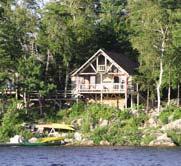

Ellis Paul has traveled the world performing his crossover style of modern folk. Spend an evening at Chocolate Church Arts Center enjoying Paul’s music as well as more traditional tunes by Woody Guthrie and Pete Seeger. 207-442-8455; chocolatechurch.com
MAR. 4–19: NORTHAMPTON, Spring Bulb Show. Flower lovers should be sure not to miss this beautiful show—boasting a variety of narcissi, irises, and of course tulips—hosted by the Lyman Conservatory at Smith College. 413-585-2740; smith.edu

APR. 7–8: CONCORD, Spring Pops. Spend an evening at 51 Walden with some of Concord’s finest musicians, directed by James O’Dell, and this year’s special guest, jazz vocalist and trumpeter Christine Fawson. 978-897-9969; concordband.org
APR. 21–23: BOSTON, CraftBoston. This juried show brings 90 artisans to the historic Cyclorama at the Boston Center for the Arts. Meet the creators and learn the stories behind their work, which ranges from handmade furniture to clothing and jewelry. 617-266-1810; societyofcrafts.org

APR. 21–23: MANSFIELD, New England Folk Festival. Now in its 73rd year, this musical extravaganza draws visitors from near and



far to local schools for a weekend of music, dancing, and crafts. 617-299-1590; neffa.org
APR. 27–30: WALTHAM, Leonard Bernstein Festival of the Creative Arts. Spotlighting nationally acclaimed artists and performers alongside emerging talents, it’s a feast of dance, music, film, theater, and visual arts. 781-736-5008; brandeis.edu

MAR. 25: PORTSMOUTH, The Moth Mainstage. Enjoy an evening of tales told live at the Music Hall in Portsmouth, as national and local storytellers provide entertainment and insight through performance. 603-4362400; themusichall.org

APR. 1–2: DURHAM, Seacoast Home and Garden Show. Head to UNH’s Whittemore Center to check out the latest home and garden products and services, plants, and specialty foods. Bonus: Seminars and lectures will be offered throughout the weekend. 866-2956438; seacoast.newenglandexpos.com

APR. 5–8: MANCHESTER, MQX Quilt Festival New England. If you love quilts and quilting, you won’t want to miss this show and conference at the Radisson Hotel. There will be a roster of classes, and quilters from near and far will showcase their work, some of which is available to buy. mqxshow.com

This family-owned, 93-room luxury inn features two great restaurants, 23 fireplaces, an indoor heated pool and is fully handicapped accessible. Select pet-friendly rooms available. Walk to the best shopping on the Maine coast and the Amtrak Downeaster train station. Ask about our Yankee Getaway Package. Book direct for complimentary breakfast and afternoon tea.



See Ireland this year with YMT Vacations!

APR. 20–23: KEENE, Monadnock International Film Festival. Celebrate independent filmmaking and filmmakers from all over the world as well as right here in New England. The impressive lineup of feature-length and short films will be screened at several venues. 603-522-7190; moniff.org

MAR. 2–26: PAWTUCKET, The Nether. Judith Swift directs Jennifer Haley’s fairy tale–influenced sci-fi thriller of a play at the Sandra Feinstein-Gamm Theatre, conjuring up a virtual world where everything is not as it seems. 401-723-4266; gammtheatre.org
APR. 15–24: NEWPORT, Daffodil Days Festival. This townwide celebration of spring invites you to participate in workshops, take a cliff walk, tour gardens and houses, admire vintage cars, and enjoy music, a parade, and more. 401-846-4500; daffodillion.com
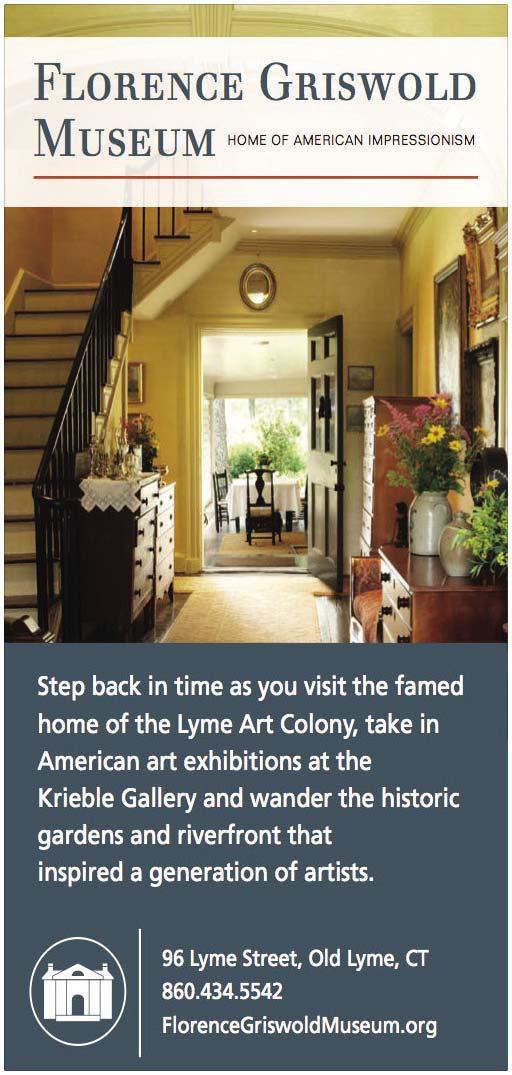
APR. 25–29: PROVIDENCE/WARWICK/EAST GREENWICH, Southeast New England (SENE) Film, Music, and Arts Festival. Theaters around the region showcase independent films from all over the world. Be sure to set aside some time for the live music and art exhibits, too. 401-203-7363; senefest.com
APR. 28–29: NEWPORT, Newport Craft Beer Festival. The Great Friends Meeting House hosts this annual celebration of Newport’s long and rich brewing history, highlighted by opportunities to sample craft beers and meet the folks who make them. newportcraftbeer.com

MAR. 11: MIDDLEBURY, Vermont Chili Festival. Stroll the streets of downtown Middlebury and chow down on chili from all over Vermont. Along the way, you can do a little shopping and enjoy live music and street performers. experiencemiddlebury.com



12 days from $1,499* now $1,399* Your exploration of the Emerald Isle starts and ends in Dublin. See all of the city highlights including the Bank of Ireland and St. Patrick’s Cathedral. Next is the Rock of Cashel, Waterford and a visit to the famous crystal factory. Continue to Cobh, Blarney Castle and Killarney. Drive the spectacular Ring of Kerry, explore Bunratty Castle & Folk Park and view the incredible Cliff s of Moher before arriving in Galway. In the Sligo area, see Kylemore Abbey en route to Belfast. Lastly, discover “The Giant’s Causeway” and Titanic Belfast, visitor experience. Departs June – September 2017 1-877-216-2802
MAR. 17–26: MONTPELIER, Green Mountain Film Festival. Now in its 20th year, this festival spotlights independent filmmakers who focus on cultural, social, and historic themes. 802-917-1225; gmffestival.org


MAR. 18: STRATTON MOUNTAIN, Taste of Vermont. Some of Vermont’s best restaurants, chefs, and bakers will gather at Stratton Mountain Resort’s Main Base Lodge, where you can taste their favorite creations and pick up some new recipes. 802-297-2096; strattonfoundation.org

*Prices are per person, double occupancy and do not include taxes & government fees of $299 per person. Add-on airfare is available. All special offers apply to new bookings only made by 3/31/17 and are subject to availability. Seasonal surcharges and single supplements apply. Additional terms and conditions apply, visit ymtvacations.com or ask your Travel Consultant for details.

APR. 1: WOODSTOCK, Season Opening Day. At Billings Farm and Museum’s 35th opening day, families can explore the barns and greet the animals, as well as take a horse-drawn wagon ride and sample free ice cream. 802457-2355; billingsfarm.org
APR. 14: RANDOLPH, Béla Fleck and Abigail Washburn. Chandler Center of the Arts invites you to enjoy the banjo music of two of the world’s best and hear tunes from their debut album, which incorporates gospel and blues. 802-728-6464; chandler-arts.org












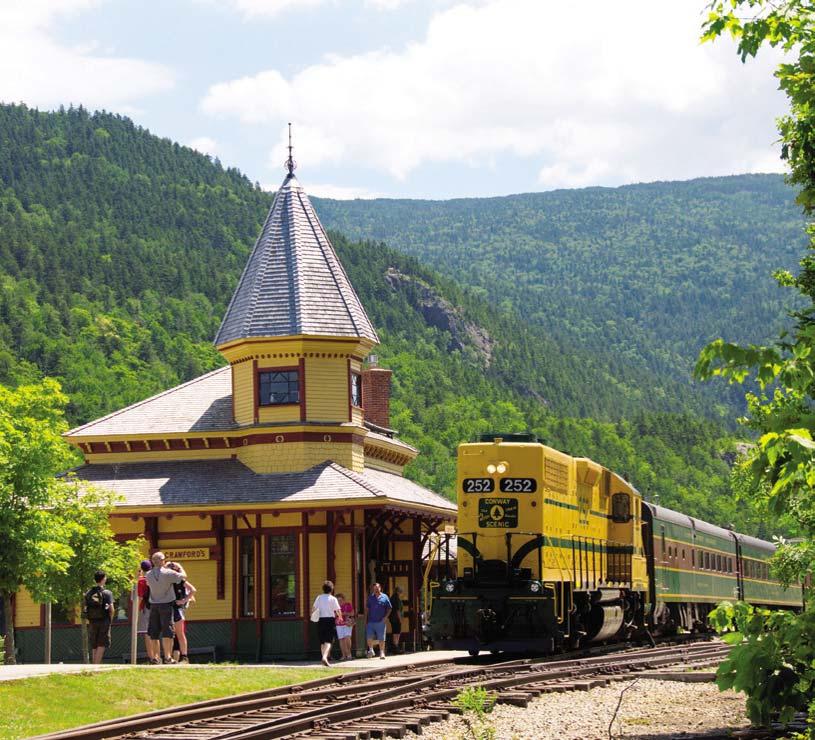





Henry David Thoreau once wrote, “An early morning walk is a blessing for the whole day.” These coastal strolls will fill your senses with the sights and sounds and exuberance of being by the sea.

Today I’m pursuing the gentle curve of a beach that stretches to the horizon, somewhere I can get lost in the beat of water and the warmth of grainy sand in this tiny state that asserts itself like a terrier, claiming the entire ocean in its nickname. Napatree Point Conservation Area, in the coastal village of Watch Hill, is spoken of reverently as an insider’s favorite. One of the most beautiful and least crowded beach spots in Rhode Island, it is 1½ miles of arcing coastline, with skinny paths leading off through dune grass, taking you from surf to coves, luring hikers and bird watchers. The beach hugs the Atlantic, with Little Narragansett Bay shining on the north side of the barrier that protects the dunes. After about a mile, you come to the ruins of Fort Mansfield, all that’s left of a 1901 fortification that once protected Long Island Sound and New York City. Keep going and you’ll reach the tip of the point. Plan it for sunset, and see the sun melt into the sea.
 —Annie Graves
—Annie Graves

There’s always another bench around the corner, just begging you to sit and contemplate a view that stretches all the way to Spain.
 BY ANNIE GRAVES
BY ANNIE GRAVES
his is what it feels like to be a seabird, a poet, a pirate, on top of the world. To take a vertiginous walk on the edge of beauty, high over the ocean, while waves pound rocks into sculptures far below, and toss starfish and tiny shells into tidal pools scooped out like cauldrons brewing the ultimate plateau de fruits de mer
Take a deep blue breath of Atlantic air and step onto the Marginal Way, which winds from Ogunquit Beach to tiny Perkins Cove, a collection of onetime fishing shacks now refurbished as shops and restaurants, shining like a periwinkle on the far side. People get married on the Marginal Way. Others want to have their ashes scattered into the sea here. Strollers transport infants on their first-ever cliff “walk”; a wheelchair, available at the town fire station, assists those who need it. Birth, marriage, and death— as well as an overarching splendor that speaks to the inner stillness that guides us all—share the path.
Solitude by the Seashore
“People have their memories here,” says Paul Breen, 81, who has lived in Ogunquit year-round for the past 10 years; he’s also summered here since ’68. He walks the Marginal Way every day, patrolling for erosion (he’s president of the Marginal Way Preserva-
tion Fund) and checking in on one particular bench—his memorial to the daughter lost to lupus—among the 39 ing their favorite view, these benches face the horizon, engulfed by beach roses, or sit sequestered in a cedar grove, or perch on the cliff’s edge. There’s a bench for every mood, every
It’s all impossible to resist, and why would you? The story of this strip of coast “on the margin” unfurls like a love story between the town of Ogunquit and the sea. To most, the Ogunquit. Deeded to the town in 1923 by Josiah Chase, a retired lawyer from Portland, Maine, the granite-cliff pathway was added to over time by abutters who contributed easements to create the stretch of path we know today: an easy mileplus meander. Start near Ogunquit Beach and search for tucked-away Wharf Lane if you want a sneak preview, or duck down the “official” trail
It was my husband, who worked for the trails division of Cape Cod National Seashore, who told me about the special places that the public isn’t aware of. Trails that aren’t included in park literature but are perfectly permissible to walk, and all with legal parking areas. Trails that lead to the most exceptional beaches I’ve ever seen on the Cape. Trails like Snail Road.
On Route 6 north, toward Provincetown, you’ll come to an intersection with a sign saying “To Route 6A, Provincetown.” Leave your car at the small parking area on the right, and start walking. The trek along Snail Road (the only trail here, but it has no sign) is roughly 1½ miles each way—it’s difficult to say exactly, because the dunes are high and the sand is soft.
The view from the summit blew me away. In front of me was the Atlantic; behind me was Cape Cod Bay and the peak of Race Point Light; to the right I could see Pilgrim Monument, as well as miles of rolling dunes. It reminded me of an Edward Hopper painting. I saw only one person on my walk, and the beach at the end of the trail was empty. —Jennifer Kain DeFoe
entrance near the Sparhawk Resort. Some know the landmarks like their own children: Little Beach, Mother’s Beach, Devil’s Kitchen, the Marginal Way Lighthouse (with online daily views from a webcam).

Louesa Mace Gillespie, 80, grew up on the Marginal Way—her family owns the Beachmere Inn, an expansive compound overlooking the churning Maine water. She remembers biking the path decades ago, in the early 1940s. “It was a dirt path across the property,” she says. “You could ride your bike right out to the Cliff House.” But not everyone took the path, she recalls: “When I was a kid, you were a wimp if you touched foot on the Marginal Way. You had to do it on the rocks!”
It’s a funny thing about this cliff walk: You’re almost never alone, but it’s still plenty meditative. You’ll pass sunbathers, bench sitters, chess players, shutterbugs, musicians, painters, and kids clambering over boulders. Everyone finding their own little corner. Lots of everyones. In fact, to gather hard data about the ongoing problem of erosion (apart from natural causes), the town’s Marginal Way committee installed a people counter last year. On Fourth of July weekend, some 12,000 people walked by; in August, the tally was 97,000.
But this is much more than a tourist stroll. Ogunquit villagers are fierce about their walk. The town and various Marginal Way groups, both municipal and nonprofit, work overtime to maintain it: trimming back daily the invasive species and shoring up collapsing stretches of pathway. They’re holding back the sea. Rebuilding benches. Constantly fund-raising (though there’s a moratorium on adding benches, a Friends of the Marginal Way memorial has been created, a pretty granite alcove with name plaques available). And they’re even replacing sections of path: In 2007, a terrible storm “tore
apart the Marginal Way,” says Breen, with over $2 million in damage.
It’s that mighty power that keeps us awestruck. Waves crashing, foam flying. The spectacle of this view, with such amazingly easy access (foot traffic is encouraged all along the way, with seven entrances). The gently rolling nature of the trail, making it a friendly walk for young and old. And always another bench around the
corner, just begging you to sit and contemplate a view that stretches all the way to Spain.
“When you’re a kid, you say, ‘I’m never going to sit on those benches,’” says Gillespie. She glances out toward the water, and a path that has drifted along this coast for decades. “And then, when you’re my age, you think … it might be nice to sit on a bench and watch the surfers.”
There’s something especially satisfying about a loop walk, knowing that the trail wending its way through the landscape will lead you home again.
The loop walk in Odiorne State Park , just south of Portsmouth, New Hampshire, in the village of Rye, takes visitors through the largest swath of undeveloped coast in the state. After exploring the Seacoast Science Center, where nifty exhibits include a hands-on tide pool tank, you can hit the trail and wander past ocean, marsh, and forest, with the bonus of spotting remnants of the era when the site was used for coastal defenses in World War II. —M.A.
Long before tourists discovered Newport’s famed Cliff Walk, deer and Native Americans and, later, fishermen made their way along the tight path above the bay as they navigated from one place to another. When some of the nation’s wealthiest families built their mansions here in the 19th century, they could stroll out onto their back lawns to view the water and, if they wished, follow the trail to see what their neighbors were up to. Today, the 3½-mile Cliff Walk, New England’s first National Recreation Trail, serves as nature’s counterbalance to the opulence that put Newport on the map. Much of the path is moderate; some is even easy. Certain stretches do require basic caution, though, since erosion has taken a toll, and in spots wet rocks require care. The walk is kept open to the public by the constant efforts of its caretakers. It comes with gifts bestowed equally to all: waves scudding off rocks, sailboats skimming the water, fine architecture to ogle, and camaraderie with fellow walkers who, like you, feel lucky to be there. —Mel Allen


alk into the wind. This is the first rule of the winter beach walk. The bitter gusts will sting your cheeks and the salt-infused air might make your nose run (you have tissues, right?). Be sure your hood is snapped tight to the collar of your down coat. You’ll set off, and quickly your walk will become a battle. You’ll wonder why you’re here in this weather. You’ll persevere for as long as you are able. Turning back, you will claim your reward. You will hear the repeating surf. You will consider the vastness of the ocean, and remember that map you saw online that shows if you swam in a straight line away from this beach, you’d land in South America. You will notice a constellation of gulls up ahead. And then you will realize: You are thinking about nothing. The combination of wind and water has swept your mind clear. All your worries, your challenges—
gone. In this empty space, you will walk with the wind at your back.
Then comes March. The equinox arrives on schedule. Night and day are equal partners now. The sun begins to warm the inland places, but the chillier shore requires scarves and mittens. Still, the steel blue of winter—in sky and sea—is greening up. The harshness of the light is softening.
From the parking lot at Cape Cod’s Craigville Beach, I walk toward the water. At the high-tide mark, I pause to check the wind. Then, I hang a right.
The water is stirred up from last week’s storm, and my eyes are open for treasures. I’m not exactly beachcombing (I have overflowing baskets of shells and rocks at home), but I might be tempted by something shiny and portable: a piece of Coke bottle–green sea glass, or an orange jingle shell.
Walking into the wind today, I am walking into a glorious sunset. This
A spectrum of
seems a good bargain. I push harder, moving toward the deepening blue, the glowing golden light—apricot, streaked with the palest pink. There are many winter afternoons when I do not walk. Stopping by the beach on my way home from the post office, I’ll snap a photograph of the sky. If I printed all those images, I’d have baskets of sunsets, too.
I pass the boarded-up beach club, the floats and diving docks that spend the off-season on land. I pass the house that burned down and was rebuilt sideways. I tuck myself into a dune and sit for a few minutes, realizing: I’m warm enough to stop moving.
It won’t be tomorrow or the next day, or even next week. But soon, I’ll trade my down for corduroy. Next, I’ll ditch the gloves. And then one day— maybe late in April or in early May—I won’t walk into the wind. I’ll just walk. And that’s how I’ll know it’s spring.
waves crashing in the distance. The woods give way to coastal shrubbery—some of the most exemplary on the East Coast—and the walker alights upon a deserted beach. This is merely one potential scenario in a trail system that comprises 28 miles on a 10-square-mile island, a dozen miles off Rhode Island’s coast, that the Nature Conservancy called a “Last Great Place.” The trails crisscross the island, from the tangle of paths known as “The Maze” at Clay Head to the natural amphitheater of Rodman’s Hollow and down to the remote southern beach, Black Rock—which means you can traverse most of the island, north to south, east to west, entirely via the Greenway network. —Peter Voskamp
a ‘Last Great Place’
t’s toward the end of her walk that Libby Delana finds her picture. For the past hour she’s made her way along the paths of the Parker River National Refuge on Plum Island, Massachusetts, a barrier island off the state’s North Shore that is home to thousands of federally protected seaside acres. Through towering beach grass that hangs heavy with dew, through a
scrubby dune-scape, through a forest that will soon glow red with September foliage, Delana meanders along the boardwalk. Stopping, gazing, contemplating. Look at that spiderweb. Listen to that ocean. Is that a blue heron?
It’s fresh appreciation for familiar ground. For the past five years or so, Delana, an art director and cofounder of a marketing agency in her home-

town of nearby Newburyport, has made walking this land an early morning habit. “It’s a way of slowing down,” she says. “It’s probably my most creative time of day.”
This ritual is accompanied by an artistic endeavor. For each session, Delana uses her iPhone to take a single image of the landscape. She then shares her discovery on Instagram with her 5,500-plus followers. Often the picture is accompanied by a quote from a favorite author or sometimes a pithy line from the photographer herself. “Same walk, different day. Always,” she recently wrote.
This morning’s search concludes on the edge of a service road that runs by the sea. It’s there, amid the rusting marsh vegetation, a family of white herons patrolling the waters, and a silky fog that hides a gently curling Atlantic, that Delana takes out her phone and frames her shot.
“Just look at that,” she says in a whisper. She taps her screen, then fixes her gaze on the scene for several long seconds. “It’s like a painting.”
Soon, the herons take notice of Delana’s presence. A few flutter into flight and glide toward a more remote patch of water. She watches the big birds land, then scans the landscape one last time.
“Our days are filled with emails and other messages,” Delana says, still whispering. “Bing, bing, bing. To have a chance to be in a place like this, that’s good. That’s good for all parts of us.”
With that, she wheels around and begins to walk back to her car, to head home and move into the rest of her day.

“Just look at that,” she says in a whisper. “It’s like a painting.”
hen you walk the inviting carriage road alongside the Poquonnock River estuary at Bluff Point State Park, you find both passage back into precolonial Connecticut and a respite from the submarine-building industry that has shaped the area from the past century through today.
Visitors come to Bluff Point, a peninsula of some 800 undeveloped acres jutting into Long Island Sound, through what once were potato fields. In the mid-1940s the fields were developed into a sprawl of prefab housing to accommodate the naval submarine base and booming submarine work at the Electric Boat Company in Groton during and after World War II.
After dipping beneath an Amtrak railroad trestle and navigating a rutted dirt road, you reach the parking lot and shaded picnic tables at the Bluff Point
entrance. From there, in just a few steps, everything—the industry, the railroad, the hubbub of commerce—is left behind.
Hikers, joggers, cyclists, parents with strollers, and even horseback riders find footing on a broad, mostly flat and unobstructed path leading, a mile and a half ahead, to the bluff and

its airy panoramas of river and ocean. Along the way, there are folks on the pebbly riverbank digging for shellfish and, farther down the estuary, anglers casting saltwater lines. Kayakers and sailors are afloat. Despite sporadic traffic at the small regional airport across the estuary, the ambient sound is wind through the trees.
Side paths offer hikers more challenging, mildly hilly
alternatively, beachcombers can veer off toward a narrow, mile-long sandspit. The bluff itself, as rocky and exposed as any New England coastal precipice, likely still harbors discarded shells from the days of Pequots fishing for seafood here.
Views of gulls and ducks, distant islands and New London Ledge Light, glacial rock and stone walls, salt marshes and towering oaks, and a path for every pace—this is Bluff Point.
I stand alone on a boulder-strewn Maine shoreline. The waves thrash against the rocks. The sound is almost deafening. They call this part of Prouts Neck “Cannon Rock.” I’m lost in some Winslow Homer canvas, man facing unforgiving nature. There are few American artists in whose footsteps you can walk and still see the same unblemished scenery to which the painter devoted himself. Indeed, it’s not a stretch to call Homer the American Monet, and the rocks of Prouts Neck our lily pads. Less than a half-hour drive south of Portland, this little peninsula was the lens through which Homer observed powerful gales, dense fog, and nor’easters. When the moment happened, he’d record in unsentimental fashion the small dinghy stuck on a wave or engulfed by the sea, or the layer of white froth slamming against Cannon Rock.
Thanks to Homer’s brother Charles, who donated this path to the public in 1879, you can stroll the same route that the artist traveled almost every day with his terrier, Sam. Halfway along, the trail ascends. The jagged shoreline, rising to a crescendo, was the inspiration for High Cliff, Coast of Maine. Heading back down, you reach Kettle Cove, where Homer would create his last work, Driftwood. As a final gesture, after finishing Driftwood, Homer scrambled the paints on his palette to officially declare his retirement. Today, the Prouts Neck Cliff Walk is accessible to all, artists and nonartists alike, a glorious gift to art lovers, who can stroll straight into Homer’s masterworks.
—Steve JermanokThe bluff itself, as rocky and exposed as any New England coastal precipice, likely still harbors discarded shells from the days of Pequots fishing for seafood here.

If a walk in these pages is calling your name, why not make a getaway out of it? We’ve compiled all the essential travel information, including our editors’ picks for great places to stay and eat, at newengland.com/ bestwalks2017

There are beach roses and birds, hydrangeas, and, of course, those views of an endless Atlantic.
n 1873, William J. Flagg, a summer resident of Nantucket and real estate developer, staked part of his fortune on an expanse of windswept pasture just south of Sankaty Lighthouse. In the nearby quiet fishing village of ’Sconset, a tourist economy had started to percolate, and Flagg wanted to turn his new land, which sat high on a bluff with commanding ocean views, into a neighborhood of grand seasonal cottages. The locals, who struggled to see an economy beyond whaling, found the idea absurd. When one fisherman heard of the plan, he asked the developer to repeat himself to be sure he hadn’t misunderstood.
But Flagg—who was also a winemaker, lawyer, and author of a book on world religions—was not a man who gave in to convention. He liked to think big. His own house on the bluff, a lavish Victorian appropriately named Flaggship, was built in 1890. Other homes followed, and by the 1920s Flagg’s vision of ’Sconset as a high-class summer resort had come to fruition.
So had another key element of his plan. Whether out of a sense of tradition or a belief that those high bluff views shouldn’t be just for those who could afford them, Flagg did something extraordinary in setting up his house lots: He built into the deeds a right-of-way to be “used as a foot-path or foot promenade and for no other purpose or purposes whatsoever.” Wealthy newcomers could have their oceanfront homes, he reasoned, but the bluff-edged pathway that had been the domain of farmers and fishermen for generations would remain open to “residents and visitors of Nantucket.”
It remains so today.
It’s a walk that offers up different identities. Here you’re on a narrow village road. Now you’re cutting through scrubby forest. Next you’re strolling across a manicured backyard. There are beach roses and birds, hydrangeas, and, of course, those views of an endless Atlantic. If you’re compelled to dip your toes into the sea, there are staircases down the bluff for that, too. Just
remember: A walk here is exactly that. Polite signs remind you that biking and jogging are not permitted. If you aim to exercise vigorously, head elsewhere.
In the years since Flagg built his homes, property owners have periodically objected to the pathway. There have been legal challenges and makeshift blockades. Some years ago, one summer resident positioned a pair of sprinklers so that no one could cross his property without being soaked. But the courts have always sided with the public. Like the allure of Nantucket itself, the ’Sconset bluff walk has endured.
Ironically, the biggest threat to the path just might be the very thing it honors. In recent years the sea has claimed several houses, forced the setback of Sankaty Light, and cut short the pathway. These views, this land, it seems, can’t really be owned. Something’s there, and then it’s not. Perhaps that’s what inspired William J. Flagg all those years ago. There’s beauty in the temporary, and he wanted everyone to have the chance to experience that.
It’s the series of contrasts in Menemsha Hills that makes it one of my top walking trails: wetlands to dune grass; sea level to hills; thick forest to wide-open horizon. This Trustees of Reservations property on Martha’s Vineyard is just big enough (211 acres) to thin out the crowds, and its trail is just long enough (3.2 miles) to deter short-strollers. My niece skipped along a path crowded by pitch pine, under maples, beeches, and oaks, and up Prospect Hill, then down into a bosky dell that felt like New Zealand. We rounded a bend and out into the light we came, up to a bluff overlooking hills of goldenrod and beach plums, rolling down to the sea, where in the distance the Elizabeth Islands spread out in a line. We climbed down stairs to a beach where once, long ago, Menemsha’s brickworks stood; you’ll still find bricks scattered among the stones. We ate apples and peanuts, let the water spray our faces, smiled at two people sharing a seat on a boulder. Then we headed up the stairs through incoming fog, back through the enchanted forest, and home to tell our families about our magical day, right in our own backyard. —Jamie
How a developer of Nantucket seaside estates made sure everyone could enjoy the view.
While these days anyone with a smartphone can take a photo, only some possess the patience and the eye to create an image that tells a story, or inspires us to look at the commonplace as if seeing it for the first time. This year’s winners of Yankee ’s reader photo contest do just that. A blanket of snow descends on a Somerville neighborhood, and Mary Kocol’s lens finds a quiet world apart from anything, and anybody. We can only imagine the residents inside, peering out at snow that deepens by the minute. Aleksandar Baba-Vulic’s storm rushes toward an island harbor, and it feels as if nature’s power is leaping straight at us. In contrast, Mim Adkins lets us breathe in the ease of a summer evening settling down in Maine.
Our guest judge, Paula Tognarelli, executive director and curator of the Griffin Museum of Photography in Winchester, Massachusetts, along with Yankee ’s art director, Lori Pedrick, and photo editor, Heather Marcus, sifted through hundreds of reader images to select these three top choices. Many others deserve to be seen, and you will find them on our website (newengland.com/2016-photos). The theme of the contest, “My New England,” can be seen in different ways: perhaps in a portrait, or a moment caught on a bustling street, or a seascape at twilight. What connects every image we saw is New England’s hold on the imagination—its raw beauty, its sense of roots and tradition, its characters, even its sudden shifts of weather. It’s enough to make anyone want to walk around and start looking. —M.A.

Title: Snowing Again, Storm #4
Location: Somerville, Massachusetts
Photographer: Mary Kocol

Judge’s comments: “This artist photographs the New England landscape from her roof deck in Massachusetts and does it with a bit of whimsy. The moment takes place during a winter of 10-foot snowdrifts. It’s how she captures the falling snow that makes this ph otograph so special: She uses the camera’s built-in flash, which renders the flakes as large as snowballs and adds some magic.”

Title: Storm over the Old Harbor

Location: Block Island, Rhode Island
Photographer: Aleksandar Baba-Vulic
Judge’s comments: “ I am drawn to imagery that is well crafted, provides a fresh perspective, and evokes narrative inquiry. Storm over the Old Harbor gives the viewer all three. The artist uses composition to direct the central focus to the storm in a number of ways. He uses the ship to draw the viewer in, as if to point toward danger. The cloud and its reflection with the centralized white boat with mast form the eye of potential activity. The photograph itself is not cliché and leaves us to linger and imagine the meaning of the moment caught by the artist.”
Paula Tognarelli
The executive director and curator of the Griffin Museum of Photography in Winchester, Massachusetts, Tognarelli has juried and curated exhibitions around the world and is on the advisory board of the New England School of Photography in Boston. griffinmuseum.org

Title: Night Hammock

Location: Boothbay Harbor, Maine

Photographer: Mim Adkins
Judge’s comments:
“The photograph takes place after everyone has eaten. The artist is left alone to experience a quiet yet still animated moment in the woods. We experience the stillness as if we are there.”
 Veterinarian Tom Stuwe has been a fixture in rural Vermont for almost four decades. OPPOSITE : In Sutton, an ATV proves handy in herding a stray calf and cow back to the barn.
Veterinarian Tom Stuwe has been a fixture in rural Vermont for almost four decades. OPPOSITE : In Sutton, an ATV proves handy in herding a stray calf and cow back to the barn.
WHEN TENDING TO PATIENTS THAT WEIGH AT LEAST HALF A TON, A COUNTRY VET MUST PRACTICE PATIENCE AND KINDNESS— AND THAT’S JUST WITH THEIR OWNERS.
by Ben Hewitthe morning of Good Friday 2016 was cold and damp, the colors of the central Vermont landscape a muted collage of grays, dull greens, and browns. The falling precipitation was either rain that was almost snow, or snow that was almost rain. An undecided day in an undecided season. I rode in the passenger seat of a Chevrolet pickup truck piloted by Tom Stuwe, a 67-year-old large-animal veterinarian who has been driving these graveled roads for nearly 40 years, the back of his truck loaded with the tools of his trade: medications and lotions, scalpels and syringes, a portable x-ray machine, and, most ominous, a medieval-looking castrating implement attached to a cordless drill.
Just before 8 a.m., we swung left and began to climb a steep, frost-rutted hill toward a dairy farm where a Jersey heifer labored futilely to deliver her first calf. After a few minutes, the farm came into view: low barn, listing sawdust shed, two New Holland tractors parked at odd angles in the barnyard. And mud. Lots of mud.

The interior of the barn was neater than I’d expected. The concrete floor was covered in a fresh layer of sawdust, and the cows—tawny Jerseys, mostly—were clean and, to use the parlance of the trade, in good flesh. Three young calves lay in the wide aisle between the two rows of milkers. Knotted-together lengths of baling twine ran between the
calves’ collars and the ceiling’s framing members, and I was reminded of trellised tomatoes.
We found the heifer on her side, two small hooves protruding from beneath her tail. She’d been struggling for a couple of hours and was clearly exhausted; the farmer—his name was Ben—had been attempting to pull the calf, but those efforts yielded little progress.
We tried to compel the heifer to stand, first by pushing and yelling. When that didn’t work, Stuwe zapped her with a battery-powered prod. She rose briefly, then went back
down and was disinclined to try again. Ben unhitched her, and we dragged her into the aisle for better access. Stuwe stretched out across the floor and slid an arm deep into the heifer’s birth canal to reposition the calf while Ben braced his boots against the heifer, trying to hold her in place. When the calf was positioned to Stuwe’s satisfaction, he wrapped pulling chains around the protruding feet and he and Ben heaved. Once. Twice. Three times. On the fourth pull, the calf slid onto the barn floor.

When my sons were young, they loved being read stories from a series of books by James Herriot, the nom de plume of James Alfred “Alf” Wight, a veterinarian who practiced for decades in the British countryside beginning in the 1940s. We read those books over and over again, all of us captivated by Herriot’s wry wit, his obvious respect for the farmers of the Yorkshire Dales, and his compassion for the animals he treated. Later, after we’d been through all of Herriot’s printed work, we happened upon the BBC’s All Creatures Great and Small television series, and thus passed many happy winter evenings.
There is something inherently fascinating to me about the work of a largeanimal veterinarian. For one, there are the beasts themselves, which to most of us are lumbering and mysterious, unable to communicate their ills in language we can understand. For another, there are the keepers of the animals, the men and women (and sometimes children) who are in many cases as dependent on these creatures as the creatures are on them. As Herriot made so delightfully clear, these are often people of unusual character and enviable wit in the face of hard work and ever-diminishing economic returns.
Finally, there is the simple fact that as family-scale livestock farming for meat and dairy continues its decline, the work of large-animal veterinarians is changing rapidly. This was true in Herriot’s day, as tractors and other mechanized technologies were replacing draft horses, and it is perhaps even truer now for Tom Stuwe, who increasingly finds himself tending to

Tom Stuwe knows what I suspect every good veterinarian knows: The job is 10 percent animal and 90 percent human.
Caption to come here from editors.
Caption to come here from editors.
Caption to come here from editors.
Caption to come here from editors.
With the decline of family farming, Stuwe often finds himself caring for horses, not cows. Here he gently places the hoof of a gelding named Ace onto a platform to be x-rayed.

the pleasure-riding community. “My business has shifted from being 70 percent bovine and 30 percent equine to being 70 percent equine and 30 percent bovine,” he told me on the first day I rode with him. Of course, there are also pigs, sheep, and goats, and he’ll occasionally do the hard work of euthanizing a client’s ailing dog, but the majority of his patients weigh the better part of a half ton.
I rode with Stuwe for a total of five days over the course of three seasons, long enough to get a sense of the scope and rhythm of his work. I learned that being a country vet means spending a lot of time driving; Stuwe drives nearly 40,000 miles annually, pinballing across Vermont’s back roads, which he knows intimately (indeed, not once did I see him use the GPS feature on his phone). I learned, too, that much of Stuwe’s work is repetitive and not terribly exciting. For instance, during one visit he vaccinated 25 horses in a row, two straight hours of needle pricks. “Does it get monotonous? Yes, it does. But it gives me a chance to see animals I wouldn’t otherwise see, and sometimes that lets me pick up on problems the owners haven’t noticed.”

Stuwe is tall and just slightly stoopshouldered, and he speaks in a calm, deliberate manner that conveys competence—which might have something to do with the fact that he’s accustomed to working with large animals, which he’s done since 1978. I first met Stuwe in the late 1990s, when he frequented the bicycle shop where I worked (he remains an avid cyclist and still completes 100-mile rides regularly); I got to know him a bit better when we started keeping livestock of our own and he became our veterinarian.
But other than the handful of times I’d seen him tend to our animals over the years—an injured hoof here, a pregnancy check there, a cow that broke into a full bag of grain and gorged herself sick—I knew nothing about what it truly meant to be a large-animal veterinarian. And I was curious to hear about how his work had changed over nearly four decades of practice, in part as a result of evolv-
ing technologies, but also due to a rural landscape that is transitioning away from farms.


Tom Stuwe was raised in Michigan, and he retains just a whisper of that midwestern way of drawing out o ’s, particularly when he says “OK.” His uncle Carl was a dairy farmer, but Stuwe did not spend much time on the farm, nor
did his immediate family keep livestock, though he had a dog for most of his childhood. Stuwe was not a notably good student in high school, and in college he fared little better. “Basically, I flunked out of college,” he told me as we rolled along a remote gravel road (pretty much everything Stuwe told me was relayed as we rolled along a remote gravel road).
For a time, he hung his hopes on piloting commercial aircraft—he’d gotten his pilot’s license at the tender age of 17—but Stuwe was born with an essential tremor that causes his hands to shake subtly. The condition was inconsequential to his ability to safely pilot an airplane, and indeed he found a job flying corporate jets for Pepsi. Still, he was fired after an executive aboard the jet Stuwe was flying complained about the tremor, assuming it was caused by alcohol or drugs.
Thus began a challenging period in Stuwe’s life. He had recently married his girlfriend, Ruth (they are still married today), and the couple had a newborn daughter. He had no college degree, little future as a commercial pilot, and few prospects for supporting his new family. Plus, it was winter, and the economy was in recession. So he did the only logical thing: He bought a snow shovel and started knocking on doors near the East Lansing apartment they called home.
“After being a pilot, it was such a downer,” Stuwe recalled. I was mildly surprised to hear him admit this; although it was only the second time I’d ridden with him, already I’d become accustomed to Stuwe’s lowkey but relentless optimism, which seems rooted in a well-cultivated sense of gratitude. The word blessing peppers his speech with some frequency, and here he turned to it again. “But going through that period of asking people if I can shovel their driveway for five bucks was a real blessing. It altered my whole perspective, and made me really appreciate work.”
He appreciated the snow shoveling but not enough to make a career of it, so Stuwe applied to Michigan State University with the ultimate intention of earning a veterinary degree. Poor
grades from his previous schooling, however, were an impediment to acceptance (“And they accept everybody!” he told me), and Stuwe was compelled to enroll in junior college to bolster his record. One of his classes was organic chemistry, the passage of which required solid scores on three tests. On the first test, Stuwe earned a D. On the second test, another D. “I thought to myself, ‘It’s over,’ but I wanted to at least do something positive, so I read one review chapter before the final test.” He picked the chapter at random, out of dozens of chapters; it was the academic equivalent of a Hail Mary touchdown pass, and Stuwe knew it. But when he turned the test over on his desk, he found that the questions had been lifted straight from the single chapter he’d reviewed. “It was incredibly improbable,” he said. He looked over to me to be sure I understood what he was saying. “It was such a blessing.”
Eventually, Stuwe made his way to veterinary school with the intention of becoming a small-animal vet (according to the American Veterinary Medical Association, 67 percent of veterinarians in the U.S. practice exclusively on small animals). But one day during his senior year, the school brought in none other than Alf Wight (aka James Herriot), who was touring to promote his latest book.

Later that day, Stuwe found himself sitting next to the famed author at lunch. At one point during the meal, he asked Stuwe: What are you going to do? “I told him I was going into small animals, and he just looked at me and said, ‘Why?’ It’s amazing how one person can change your life in two minutes.”
It should be said here that Tom Stuwe is a Christian—not that being a Christian is unusual, but it seems clear to me that his faith plays a profound role in his relationship with both man and beast. He believes that humans sin, perhaps inevitably, but he also believes in forgiveness, both at the hand of Jesus and also in our more earthly relations. During our time together, we spoke at length of forgiveness and empathy, and the steady, seemingly intractable erosion of these qualities in contemporary America.
 At the Cabot farm of one of his oldest clients, Barbara Carpenter (left), Stuwe performs an ultrasound on a cow using equipment that transmits digital images to the goggles he wears.
At the Cabot farm of one of his oldest clients, Barbara Carpenter (left), Stuwe performs an ultrasound on a cow using equipment that transmits digital images to the goggles he wears.
In Stuwe’s view, Christianity serves as framework for guidance in a world that is occasionally wicked, and often confounding in its unfairness. “Sometimes it feels like I fix these animals, and they live a little longer, and then they’re dead anyway,” he said. “Sometimes you know you’ve done everything right, and things go bad no matter what you’ve done. In the past, I dove into things where nobody else would touch the animal because it was dying anyway. I don’t do that so much anymore.”
Perhaps for good reason: In 2010, the British journal Veterinary Record stated that veterinarians are four times as likely as the general population to commit suicide and twice as likely as those in other health care professions. “You don’t think the euthanizations are wearing you down,” Stuwe told me, “but they are. You start to wonder what you’re doing.”
Tom Stuwe knows what I suspect every good veterinarian knows: The job is 10 percent animal and 90 percent human.
This ratio is variable, of course: Farmers who rely on their stock for income generally need less hand-holding than, say, a family who keeps a couple of horses for weekend trail rides. But there is a human component to almost all of his calls, including one of the first I attended.
It was mid-April and raw; I’d arrived at Stuwe’s home at 6:45 that morning. He was already in action, dispensing medication to a dairy farmer whose calves were scouring (a term for diarrhea in bovine, a common affliction among young stock that are subject to the physical stress of weaning) between arranging his day’s supplies on a workbench in his garage.
With his truck stocked and the farmer’s taillights disappearing down the road that leads from Stuwe’s home, we set out for a small hill farm about 30 minutes to the south. There, we walked

across a winter-browned pasture; the ground had thawed and partially frozen again, and it felt strangely buoyant under our feet. A large dog trailed behind us, limping, her gait disturbed by the tumor in her back. It was a big and bulbous tumor, plainly visible to the naked eye, at least the size of a softball. Still, she trotted along gamely.
“She’s putting on a good show for you,” the dog’s owner said. His name was Eric.
Stuwe nodded. “They often do that.”
We walked another dozen steps or so. Stuwe laid down his supplies and prepared the injection that would transition the dog into death. “I commend you for doing the right thing,” he said to Eric. There were tears in the corners of Eric’s eyes. He patted the dog softly as he cried.
I saw the syringe in Stuwe’s hand and turned away. It was quiet for a short period, then I heard Stuwe speak. “I’m so sorry for your loss,” he said. We retraced our steps back across the
pasture, stopping briefly at the truck before continuing across the road to a small livestock barn. It was just a few minutes after 8 a.m.; already Stuwe had euthanized a beloved pet suffering from untreatable cancer. Now it was time to remove the testicles from a yearold bull.
Stuwe’s work provides him with unique insight into humans’ relationships with the animals under their care. Sometimes, this insight fills him with hope, as with the obvious love and respect between Eric and his dying dog. And sometimes, it fills him with despair, as with every time he must appear in court to testify on behalf of mistreated animals: half-starved and nearly frozen horses, or dogs held captive in crates, bedded in their own feces. “The human mind is fascinating to me, why people do what they do. A lot of times, people say, ‘If only I had this, I’d be happy.’ But it doesn’t usually work out that way.”
Thanks to the hands-free mobile phone in Stuwe’s truck, I was privy to both sides of the conversation during the many calls he received while driving (his phone rarely stayed silent for more than 15 minutes at a stretch). Often I was struck by the extent to which these conversations veered from the particulars of animal care and into more personal terrain.
Late one afternoon, Stuwe received a call from a dairy farmer inquiring about the mastitis test results from a cow he hoped to purchase. But within three minutes, the conversation had shifted. “We’re really tight on cash right now,” I heard the farmer say. “I’m scratching my head, saying, ‘How’s this gonna work out?’” Stuwe murmured in a sympathetic fashion. “We’re losing lines of credit,” the farmer continued. “I talked to the bank, and they’re saying we should still be OK, but I don’t know.” Stuwe murmured again.
“That man’s 50 years old, living in a mobile home with eight kids, and trying to borrow $500,000 to buy a farm when milk’s at $14,” Stuwe told me afterward (he was referring to the price of milk on the commodity market, which is priced per 100 pounds; it is generally accepted that it costs
the farmer about $17 to produce 100 pounds of milk). “He’s a hard worker, but I don’t know if that’ll be enough.”
We continued on to his next visit, where he bred a mare with a straw of semen that cost more than $1,000.
The next time I saw Stuwe, he was walking with a noticeable limp, the result of a broken fibula in his left leg, which he’d suffered when a horse had spooked and trampled him. “It’s a lot better,” he said when I remarked on the injury, which he’d x-rayed himself utilizing the portable machine he uses
Emily Comstock, who’d grown up with horses and accompanied Stuwe on his rounds when she was just 12. “I really want it to work out with her,” Stuwe said. “It’s not easy. This is a maledominated profession, and she’s got a lot of debt from school. But I think it’s going to work. I really do.”
Last call of the day. A dairy farm in central Vermont, a cow off her feed. We entered the barn through a barrage of cluster flies, into the sweet smell of silage and the warmth of all that bovine flesh. The cow was lying down,
in veterinary work. He continued hobbling around his garage, collecting the medications and equipment he’d need for the day’s appointments.
After being trampled, Stuwe had taken a handful of days off, but he quickly returned to a full schedule. Although the demand for largeanimal veterinarians is declining as dairy farms go under and new technologies reduce the need for in-person calls (for instance, cows can now be checked for pregnancy with a mailin milk sample rather than a physical examination), the supply of largeanimal vets seems to be declining even faster, perhaps because the finances are so marginal. Sure, Stuwe charges $120 an hour for a call, which seems a pretty penny until one considers the many unpaid hours he spends driving each day, along with the approximately $300,000 it costs to complete the required schooling. “There’s not much money in large animals anymore,” he said. “Everything’s changing so fast. I understand why no one wants to be a farm vet anymore.”
I asked if his injury had compelled him to consider his retirement. He nodded. “I already think about retirement all the time,” he replied. “I’m ready.” To this end, he recently took on a partner, a 36-year-old woman named
but she rose quickly when prodded—a good sign.
Stuwe donned a long rubber glove and ran his arm into the cow, extracted a handful of manure. Examined it. “This is an easy one,” he said, sounding pleased. “It’s reticulitis.” Reticulitis is an injury to the reticulum, the first chamber in the alimentary canal of ruminant animals, and as Stuwe explained it in detail I suddenly realized where I’d heard of it: in an episode of All Creatures Great and Small , in which it had also been called “hardware disease,” since it’s often caused by a cow ingesting a piece of metal, maybe a scrap of old fencing, or the broken tip of a cutter blade lurking in the lush summer grass.
But this time it was small pebbles that Stuwe recovered, scraped from the ground with a loader full of feed. “This has a good ending,” he told the farmer, a 50-ish man named Frank who bore the deep back-of-neck creases caused by prolonged sun exposure. “She’s going to be just fine.”
We pulled out of the barnyard. Stuwe was grinning ever so slightly. “I like it when things end well,” he said.
For additional photos of Tom Stuwe’s day-to-day life as a country vet, go to newengland.com/farmersbestfriend.
“Everything’s changing so fast,” Stuwe says. “I understand why no one wants to be a farm vet anymore.”

t was my intention, upon arriving at my family’s longtime summer home in Gilmanton, New Hampshire, to tear down the white picket fence lining our front yard. It was speckled with moss, and tilting. It was rotting in many places, and though my daughter, Allie, had painted it six years ago, a lot of the paint was gone, erased by the cars that hiss by, kicking road salt up into our yard. The fence looked abysmal, and to me it was a useless accoutrement to the rambling, idiosyncratic farmhouse that my great-great-grandfather, a New York cigar merchant, had bought in 1905. The fence was a hollow gesture at quaintness, and it symbolized the futility of human endeavor. Allie had labored to make it resplendently white; now it was a gray eyesore amid the gray snow of late spring. The fence was bound for the dump— and I was not the only one to believe it belonged there.

“Painting that fence is punitive ,” said Scott, my carpenter. “We’ll just throw it in my truck and you’re done.”
I liked the simplicity of Scott’s plan, but I have to admit I never felt spite for the fence. And before we ever got around to our dump run, the environmentalist in me reckoned that the fence could at least be reused. I put an ad up on Craigslist: “100 Foot Picket Fence. Free.” In less than two hours, I heard from seven people. I decided to edit the ad so that it read, “100 Foot Picket Fence. $300.” Over the course of a week the revised ad failed to elicit a single response.
Meanwhile, the fence just sat there. I walked past it every day, and it was familiar to me. I remembered that I had painted it once myself, in June 1983, when I was 18 and living in the house by myself for the first time ever. My grandmother was away somewhere, which put me in an expansive frame of mind. Taking a cue from Thoreau, I decided to live that week without watches or clocks, outside the strictures of time. A couple of times I rose at what must have been 3 or 4 in the morning
became an unexpected promise to keep.Illustration by CINDY RIZZA
and painted the fence in the cool dark before dawn. Once, when I thought it was about lunchtime, I phoned my mom. “Why are you calling us at 6:30 in the morning?” she said.
I decided I would at least keep the fence in Gilmanton. Then, as I looked for someone to take it, I made the profound mistake of calling John Dickey.
John is the president of the Gilmanton Historical Society and also, at 70, an age-group star on the tennis court. Forty years ago, when he moved to Gilmanton, he actually elected to build a fence for his pleasant old house. He cut the pickets himself.

When I called John, he went to his bookshelf and pulled down Gilmanton Summers , a volume that my grandmother Jane Cumming had written in 1993 about growing up here at the turn of the century. The book was once featured on New Hampshire Public Television; it is still in print. In Gilmanton, its words are effectively law. “I’m looking at page 4,” John said, “and there’s a photo of your house with the fence.” He read my grandmother’s caption: “By The Way as it was in 1907. The picket fence, now edged with a perennial garden, still stands along the road.”
“That fence has been there at least 108 years,” he said, “and you’re going to tear it down?”
A few days later, in roughly midApril, I consented to paint the fence, in part because John told me he’d evolved a quick and easy technique for scraping it: He simply hit it with a pressure washer. My fence would take only two or three hours to spray, he assured me; he could help.
It all sounded good, but my painting guru is Scott’s wife, Alison, who painted our house last spring, after doing most of the other old houses around Gilmanton Corners. When I
told Alison we’d be pressure-washing the fence, she was aghast. “That’ll be a disaster,” she said. “You’ll have paint chips everywhere, and then the fence will be waterlogged, unpaintable, for three weeks.”
Luckily, there are always kids around to paint stuff, and Alec Carpenter and his brother, Ayden Ernst, 15 and 16, respectively, came highly recommended. They had cleared the snow off John Dickey’s roof when he was away in Florida at tennis camp, and before that they’d helped another friend with haying. I called them. Alec answered. “We’ll come paint it tomorrow,” he said. “We’ll stay there until it’s done.”
Gingerly, I explained the concept of prep work. But it wasn’t until the next day, when Alec and Ayden arrived and I took my first hard look at the fence, that I began to fathom what a project it would be. Each picket was its own unique microcosm of tragedies: There was unscrubbable dirt and hammer divots, while the oldest pickets were shriveled, their bottoms eaten away by time. Many pickets were so rotten that when you tapped them they fell from the crossbeams. There was one whole section of fence, 8 feet long, that had to be rebuilt. It sat on a hill, in a tricky region of the fence that turned a corner and hooked to the gate.
Alec and Ayden scraped, coming over every two days or so, between lacrosse practices and family outings. For a couple of weeks they kept tapping at my office window, summoning me out to the fence so I could play overlord and inspect their work. The scraping was an iterative process, though, and the fine work they did with wire brushes, flossing the
fence’s most remote crevices, entailed frequent negotiations with me. I often worked beside them, too, wielding a power drill as I constructed a few new segments of fence.
At first, they called me “Mr. Donahue” and addressed me in a stiff, formal language worlds removed from the teenage patois they used when they thought I was out of earshot. Over time, the barriers broke down. Alec and I talked about his favorite poets— Tennyson, Wordsworth, and Frost— and he displayed a journalist’s knack for hardball questions:
“Can I ask you something, Bill?”
“Go ahead.”
“Why are you screwing in that crossbeam like that? It doesn’t really make sense to me.”
“I’m doing it like that, Alec, because I don’t know what I’m doing. OK?”
When we were ready to paint, it was still so cold that we needed to have another nuanced conversation—this time about the minimum outdoor temperature at which paint can dry. After conferring with their parents, Alec and Ayden put it at 50 degrees Fahrenheit. That number was also on
the paint can, but Alison told me she’d gamed it at 35 degrees and suffered no ill consequences. I had those boys out there in 38 or 39 degrees, in hats and gloves, braving the brisk New England weather, building character.
As Alec and Ayden painted, I messed with the newly built sections (which, naturally, didn’t fit into place) and also sifted through my grandmother’s archives. The fence figured in many of the most resonant photos. It was a background melody, a delicate music playing at the edge of our yard, extending the magical world of the house out to the road and also enclosing that world, signaling gently, without ever impeding the view, that everything outside its bounds was not part of the dream.
When I look at photos like these, I am bowled over by how short life is. A few days ago I was the boy painting the fence. A few days more, and I will be too old even to tell the kids painting that they need to scrape more. My mom, the girl in the wheelbarrow, has arrived at that place in her life, after being the keeper and principal decision-maker of this house for 30-odd years. And so for the moment—for the next four or five paintings of the fence, until I hand it over to Allie or one of her cousins—it’s all me.

It’s just a fence, and there’s no question that we could live full and happy lives without ever thinking about it again. Still, I am old enough to have sensed a certain gravity in the moment when the fence became, all at once, my headache and my headache alone. When one of your parents is dead and the other is fading, you become aware, suddenly, that for decades—for many years after you grew up and left home, even—you had a safety net. You had some backup. And now that backup is gone. You’re on your own. It is your moment to carry the ball—the weight of history, the stories, whatever—and it is very important that you do not screw it up.
So, I am happy we kept the fence— even if the paint is already starting to chip.
The fence was a delicate music playing at the edge of our yard, extending the magical world of the house out to the road and also enclosing that world.




Lewiston, Maine, is home to a remarkable number of African immigrants—some 6,000 in all. And even amid the nation’s uncertain new political climate, they remain dedicated to building their lives in the old mill town they helped bring back from the brink.
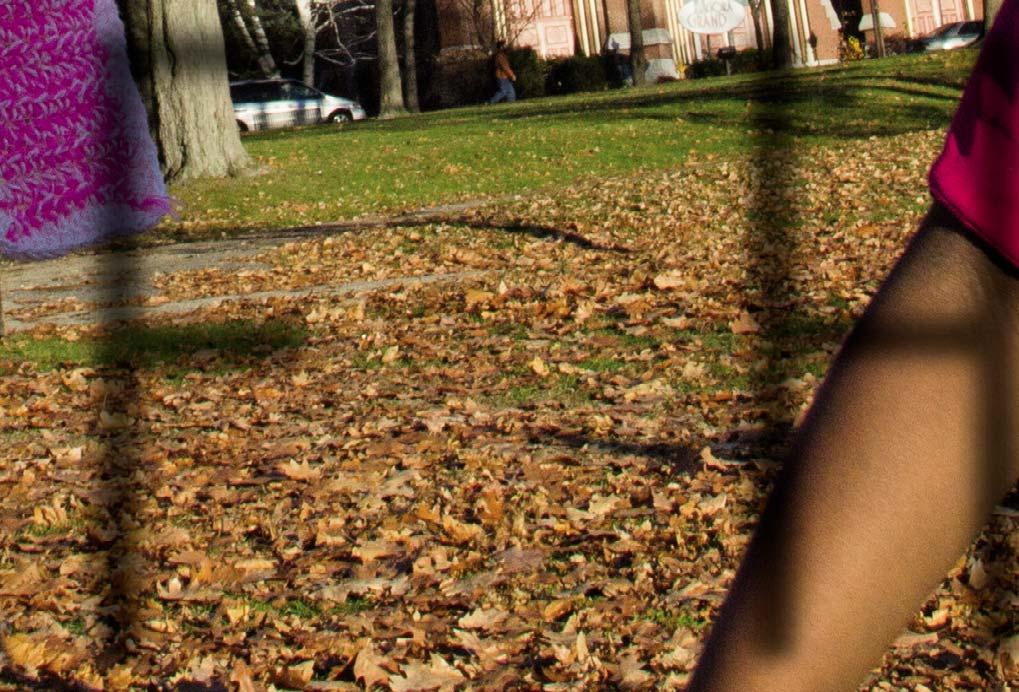
 BY CYNTHIA ANDERSON
BY CYNTHIA ANDERSON


riday, teachers’ workshop: Kennedy Park in downtown Lewiston, Maine, teems with kids and the energy of a no-school day. Children play tag beneath bare-limbed trees, crisscross the paths on bikes. Flags fly straight in the March wind. A few kids, impervious or optimistic, have shed their jackets, and a couple of boys wear shorts, but mostly hoods are up and coats are zipped. The forecast calls for snow.
Periodically a car pulls up, someone honks, and children come running: a girl in a long skirt and hijab with a ball under her arm, a pair of middle schoolers who were part of tag. Other than women with toddlers at a row of swings, there are few adults. The scene evokes an easier time, when kids ran and played unsupervised and parents let them be.

Before the first refugees arrived here in 2001, before a few dozen Somalis became hundreds and then thousands, before the subsequent waves of asylum seekers from other African nations, Kennedy Park would have been all but empty on a cold spring day. Back then, Lewiston was moribund—a beautiful old ghost of a city whose glory years as a manufacturing hub were long gone. In their wake, a wan service economy had taken hold, but the population drain continued and the core of the city was a shambles. The Lewiston of my ’70s youth—busy sidewalks, women in wool suits and heels, the heady smell
in Ward Brothers of everything the cosmetics counter had to offer—was barely recognizable by 2000.
Lewiston needed to stake a claim in the 21st century, and it has— although not one it sought or anticipated. In the past 16 years it’s undergone a transformation as profound as that of any U.S. city, from homogeneous to diverse, underpopulated to revitalized. More than 6,000 of the city’s 36,500 inhabitants are now of African descent. Immigrants work in health care, retail, banking, industry. The downtown is busy once again; classrooms are filled. As Maine’s leaders lament the aging of the state,

Lewiston is younger than it’s been in decades.
It’s not utopia. The city still struggles financially, while the needs for social services and education have intensified. Joblessness among the older generation of newcomers remains high, and many speak little English. For some, the effects of a traumatic past hinder acculturation. And while discord has not been pervasive, the racism and Islamophobia that overlay the national social landscape show up here, too.
But there’s a vibrancy in Lewiston that didn’t exist a decade ago. The repopulation has attracted artists and
entrepreneurs. A new elementary school is being built. What’s happening is isbedal , the Somali word for transformation.
At Kennedy Park, a van pulls up. A woman gets out and crosses to the basketball court, wind billowing her black abaya. At the fence she waves her arms. A boy in a T-shirt disentangles himself from a group, pulls his coat from a pile. The woman speaks pointedly in Somali, chastisement clear. As the boy thrusts his arms backward into the jacket—“Like this?” he asks, in English—she puts back her head and laughs.
outlet and the heater, flicking back a braid or two when they fall forward. On-screen, members of the Forrester family scheme to stay on top of the L.A. fashion world.
The SAT is April 12, and Nasafari needs to do well. She hopes to attend St. John’s University in New York for the paralegal studies that will set her up for law school. But her parents, conservative and watchful, aren’t sure they want Nasafari that far away, given the situation with her two older sisters. One dropped out of high school and lives in a nearby town with her boyfriend; the other moved to Arizona with the family
In school, Nasafari’s strengths are history and English—“I like words, adding to my vocabularies,” she told me the first time we met. She’s been learning languages all her life: Kinyamulenge in the refugee camp where her mother, in her third trimester, had fled after rebels pillaged her Congolese village and jailed her husband. Nasafari (whose name means “journey”) was born en route to the camp. While her father remained imprisoned, the rest of the family resettled in Rwanda. Nasafari learned Kinya rwanda there.
After the rebels released her father, he applied for asylum in the U.S.

In a condo three blocks from the park, 17-year-old Nasafari Nahumure streams The Bold and the Beautiful , fixated on her iPod when she knows she should be studying for the SAT. But these few hours are her haven, a respite from the intensity of school and homework and the youth center where she volunteers. The house is unusually quiet—her younger siblings upstairs in their rooms, her father at work, her mother out. Earlier Nasafari cleaned the house, swept and dusted, wiped down surfaces with Lysol. This bit of time is hers. She sits in her place at the table, close to an
of the church youth pastor. Nasafari’s father keeps a close watch on his third daughter: She has no phone and little in the way of a social life. In navigating the halls of Lewiston High School, where she’s a junior, it helps that she’s outgoing. People know the slim girl in boots and jeans even though they rarely see her at night or on the weekend.
and the family reunited in Maine. Nasafari has lived 11 years in Lewiston, longer than anywhere else. Her English bears traces of Down East: occasional dropped consonants at the ends of words, a two-syllable “there.” She loves Portland (“booming and friendly”) and Freeport for its shopping. Her father’s paychecks from Pioneer Plastics bought this two-story family home.
Five years ago Nasafari walked into the office of Tree Street Youth, the after-school program where she now works, and announced she wanted to be a judge advocate general (JAG) lawyer. Tree Street director

Julia Sleeper remembers the moment: “She was 12, a sixth-grader. I didn’t even know what a JAG was.” Nasafari herself can’t recall where she got the idea to join the JAG Corps. “I just knew I wanted to serve my country and also to be a lawyer.”
Sun patterns the room in blocks of light and dark. The Bold and the Beautiful is over. Nasafari switches off her iPod, takes out her homework.
Downtown on Lisbon Street, Fatuma Hussein is running late. She is 37, and her days are packed, this one no exception. She needs to get to court in Portland, a 40-minute drive if she pushes the speed limit. The hearing is on behalf of a woman whose husband violated a protective order; Fatuma will be there as an advocate. She has an hour, and she hasn’t eaten lunch—which she must, because earlier this week she learned she’s pregnant with her eighth child. That wasn’t something she was hoping for, exactly, but the weeks of denial ended when the midwife swept a probe across Fatuma’s belly and a baby materialized on-screen.
So there’s lunch to be gotten through and a long drive, and Portland traffic, and Fatuma’s caught in the office doorway while her assistant, Rosaline, issues updates on who’s called and why. Finally Fatuma puts a hand on Rosaline’s arm. “I really have to go.”
Whenever the topic of Somali leadership comes up, so does Fatuma’s name. The reason for this is partly her charm but also her resolve. She arrived in the U.S. at 12, without her parents, after two years in a Kenyan refugee camp. Within a few years she had married and relocated to Maine, determined to vector loss into forward momentum. The organization she founded in 2001, United Somali Women of Maine, has grown into a successful nonprofit now known as the Immigrant Resource Center (IRC). But there are stresses too: family responsibilities, this pregnancy (which she’s not yet told her children about), and a perpetually jammed schedule. Then there’s the


urgency to expand the IRC as other immigrant-headed nonprofits crop up in Lewiston and vie for funding.

The strain of it all sometimes shows in Fatuma’s face. It’s showing now. Even so, at the restaurant across the street she and the proprietor greet each other warmly. As-salaam alaikum. Wa-alaikum as-salaam. Within minutes, a steaming platter of chicken and rice appears at her table, where Fatuma perches watching the clock. Save for the table, the TV, and a plush prayer rug, the persimmonhued room is empty. It typifies the Somali aesthetic for indoor spaces:
dinner and tuck her younger kids into bed before checking the older ones’ homework. It’s easier when her husband is home, but he’s a trucker and often out of state.
The next morning she’s on the road again, to and from Augusta and then south to Portland for an observance of International Women’s Day. In Portland, she takes the microphone, talks about the need for women’s-rights advocacy and, more generally, about the state’s immigrant presence. “We are not a burden. We come, and we succeed,” she tells the crowd to echoes of “That’s right.” Applause grows as
the federal government had first resettled the refugees. Moving to the extreme Northeast was their choice— a gutsy one, considering that photos shared through social media showed snow banked four feet high.
In Lewiston, a handful of families turned into a few dozen, and then several hundred. For a while, as many as 50 Somalis were showing up by Greyhound bus each week. Most settled into the vacant triple-deckers that fanned out from downtown Kennedy Park. By the end of the summer, almost 1,000 newcomers had moved in. The city scrambled to provide

bright and uncluttered, pared of material possessions.
Dutifully Fatuma finishes her chicken and some salad, takes a long swallow of orange Fanta. Her phone rings: Rosaline. The client is en route to court. Fatuma asks Rosaline to call the interpreter, to confirm her arrival time. And then she’s off, headed south on the highway. She gets there just in time to take the hand of the woman and listen to the long proceedings. Then she’s back in her SUV, driving north and west into a reddening sky, arriving home to cook
she continues, “The state of Maine is lucky to have us.”
Back in his office in Lewiston, deputy city administrator Phil Nadeau agrees. “Things are good and have been for a while,” he says.
The early years were rocky. The first to arrive were Somalis who came north from Portland, where housing was scarce, in February 2001. Maine was cold, and homogeneous (it was then the second-whitest state in the nation), but it offered safety and access to services, and a lower cost of living than places like Atlanta, where
language and social services. There was pushback about who would pay for what, and how. The situation was complicated by the fact that federal money set aside for refugees doesn’t follow them if they move from original resettlement locations—and is short-term, in any case.
It seemed to me then that longtime Lewiston residents were responding to the changes in accordance with their natures: curious, or suspicious, or holding off on judgment. But tensions were rising. In October 2002, then-mayor Laurier Raymond wrote
“We are not a burden. We come, and we succeed,” Fatuma tells the crowd to echoes of
an open letter urging Somalis to stop inviting friends and family members to join them. “This large number of new arrivals cannot continue without negative results for all…. [W]e need breathing room.” The now-infamous letter triggered a chain of reactions, including a poorly attended white supremacist rally and a sizable counter demonstration at nearby Bates College.
The refugees kept coming. The New Yorker called what was happening in Lewiston a “large-scale social experiment”—a blunt but not wholly inaccurate assessment. There were,
head through the doorway of a Lewiston mosque while people inside were praying, the reaction—at least publicly—was unanimous. The deed was denounced, the offender criminally charged. The imam urged mosque members not to retaliate, and the broader community drew close around the Somalis.
Jamilo Maalim, who arrived in the city in 2003 as a 9-year-old, remembers a more welcoming reception overall than the one in Dallas, where she’d first been resettled with extended family. “People were just friendlier in Lewiston,” she says.
traits—the slight set to her chin, the upright posture, the open but searching gaze—suggest both sensitivity and resilience. As an infant she was separated from her parents after the Somali civil war intensified; an aunt escaped with her to Kenya. Three years ago she learned her parents were alive and living in the same refugee camp where she had been. Right away she began to save money for a trip. Last spring she flew to see them. “When I got there, I was in such a rush. It was like, There’s this lady. I’m told she’s my mother.” She pauses, blinks back tears. “When I hugged her, I felt like I knew her.”
after all, now several thousand African Muslim immigrants in a city not known as a liberal outpost. Pickups with Confederate decals regularly parked downtown, and stories about the newcomers in the local Sun Journal triggered xenophobic online rants. Fatuma recalls verbal abuse and taxi drivers who refused to pick up Somalis, and white men exposing themselves to immigrant women.


But if there was an ugly undercurrent, increasingly the tone was one of accommodation and accord. In 2006, when a man threw a pig’s
Now 22, Jamilo lives in a downtown apartment—a Somali-spare yet cozy place decorated with garlands of plastic flowers and framed photos of her son and daughter. The living room holds a leatherette sofa, a TV, and a big soft rug where the family sits to eat their meals. Jamilo’s physical
Jamilo stayed in Kenya six weeks, and now keeps in regular contact with her mom and other family members there via phone and social media. But she doesn’t think about leaving Lewiston permanently. She’s a working single mom who values health care, education, community. In many ways the city has formed her.
While Jamilo was growing up— entering third grade in a new place, finding friends, figuring out how to be both American and Somali—TV and newspaper accounts of what was happening in Lewiston focused on
“That’s right.” Applause grows as she continues,“The state of Maine is lucky to have us.”FROM LEFT : The Mogadishu Store owner Shukri Abasheikh, right, affectionately known as “Mama Shukri”; a shopper on Lisbon Street; a food-filled gathering at the Masjidul Salaam Mosque to honor a recently deceased community member.

isolated, dramatic incidents. The mayor’s letter, the rally, the pig’s head. What’s really transpired in Lewiston is quiet forward motion, a lot of hard work by longtime residents and newcomers alike. The city’s initial unpreparedness may have worked to its advantage: As officials scrambled to build programs, they had to partner with churches, hospitals, schools, and the refugees themselves in ways that
But mutuality and steady, imperfect progress are not the stuff of headlines. Every time Muslims or refugees are in the news, reporters still call Phil
What’s happening in Lewiston? ,
In his city hall office, surrounded by photos of Lewistonians and a street map that stretches overhead, Phil smiles and settles back in his chair. “I
And yet—much remains at stake. Kids who arrived as refugees or asylum seekers are heading off to college in rising numbers, but will they return to Lewiston? Will there be jobs if they do? And the climate, not the cold and the long wait for spring, but the social climate: What will happen in the wake of the presidential election and during the next four years? The comers need opportunity and a sustained sense of welcome. Lewiston needs its new residents to settle in and

In mid-April at Tree Street Youth, Carrys Ngoy practices keyboard for an upcoming performance, though not wholeheartedly. Whenever he stops, hip-hop filters in from down the hall where kids work on a dance routine. The floor reverberates with bass and pounding feet. In two weeks Carrys will perform his piece with his best friend and housemate, Isaac Kabuika, who right now is at Bowdoin on a three-day visit for accepted students.
Carrys and Isaac have much in common: both high school seniors, Congolese, both in the U.S. without
parents. Both seeking asylum because of peril in their country. Their friendship was cemented in AP Calculus II, where they’re two of only three students in the class.
At home in their shotgun-style apartment, Carrys and Isaac share chores and hang out when they’re not at their desks. They talk religion and philosophy, wash down any disagreements with Welch’s sparkling grape juice. For all they have in common, the two have different styles: Isaac, forthright; Carrys, deliberative and wry. Recently Isaac announced that he didn’t like to cook and hoped to marry a woman who does. Carrys eyed him sidelong. “She might not like to cook either,” he said. Isaac nodded, smiled. “We’ll take turns and eat out on my nights.” In the
fari is in her own state of uncertainty. The SAT was Tuesday, and she’s not sure how it went. The verbal portion seemed OK, but the math was challenging. Plus, she felt off that morning: It was raining, she got to school late, ate little breakfast. She sighs, flicks a braid. “Maybe I did fine.”
A boy appears in the doorway. He smiles at Nasafari, leans there for a while, waiting. Eventually she smiles back. After he leaves, Nasafari is quiet. They are not dating, she says finally. “I mean, I don’t do relationships. School and my family come first.” As she speaks, she looks older than 17 and also very young.
Last week a woman came to Tree Street to talk about her path to a career as an attorney. Nasafari’s face
at Bates. She founded Tree Street in 2011 and recently raised more than $1 million to renovate its quarters in a former paint shop. “It’s very exciting,” she says of what’s happening at Tree Street and, more generally, in Lewiston. “Things have evolved so much over the last decade. There’s been tremendous growth, collectively and individually. Of course there are difficulties—the issues are complex and thousands of lives are involved—but when you see people overcoming, when you see success, it’s very motivating.”
Her investment in the kids is obvious two weeks later at the performance in the atrium of the refurbished Bates Mill. From the front row, she mouths the words to all the songs and spoken pieces. The kids dance “Powerful” and
meantime, Isaac buys stuff to microwave while Carrys experiments with cooking from scratch.
With Isaac away, Carrys is spending much of his time at Tree Street. “Actually, it’s lonely at home,” he says in French-inflected English. He’s been in the U.S. 15 months to Isaac’s two years and is unsure where he’ll wind up in the fall. The University of Maine at Orono accepted him into its engineering program, but, unlike Isaac, who got a scholarship, Carrys doesn’t know how he’ll come up with the tuition. As an asylum seeker he can’t apply for federal loans, and although he’s filed for an asylum hearing, the backlog of cases means it could be years before he learns whether he can remain in the country.
So Carrys waits: for news about private scholarships, for his hearing, for alternatives for September. Maybe he’ll take classes at the community college. Maybe he’ll stay on at Tree Street as staff. He does love Lewiston, he says. For tonight, he’ll eat some leftover pork and beans he made. Isaac will be home on Sunday.
At a table in the room next to where Carrys is practicing keyboard, Nasa-
gains composure as she describes how the woman raised her siblings and married young before attending law school. “It was really inspiring. I’d love to job-shadow her,” she says.
For a majority of the kids at Tree Street, their experience at the center culminates in the college prep program. Application essays paper one wall, and acceptance letters another. They’re there, Julia Sleeper says, partly for celebration but also, and more importantly, so that the younger children will be inspired.
About 130 kids come through the doors every day. Most are African immigrants, a few are native Mainers. Hand-painted lettering on the dance room wall sums up the center’s approach: Respect yourself. Respect others. Respect the space. Participate. The place is not always a haven of good behavior—there are back-talking kids and misbehaving ones, children in whom the effects of trauma are clearly evident—but it emanates a steady warmth.
At 30, Julia has worked in Lewiston’s immigrant community for more than a decade, since she was a student
“Cultural Mash-up,” and Julia sways and bounces in her seat, anticipating every move.
In May, Carrys learns the University of Southern Maine has accepted him—he applied at the last minute, when other prospects weren’t looking good—and awarded him a $2,500 scholarship. For days he goes around smiling. During the school year he’ll live in Portland, off-campus to save money, and he’ll start out studying math and science, since USM doesn’t offer engineering.
Nasafari’s news is not as good. She didn’t do well on the SAT—poorly enough that she won’t reveal her scores. She points out, though, that her last name, Nahumure, means “patient.” In the coming months she’ll redouble her prep for a fall retest.
At the IRC, Fatuma learns that Rosaline is moving to Dallas. While Fatuma is happy for Rosaline and her family, the timing isn’t great: Fatuma’s five months pregnant now, fatigued and a little overwhelmed, realizing how much she has to do to prepare for several upcoming conferences.
“We need to integrate more,” says Abdikadir Negeye. “We should know each other better and share in each other’s cultures.”

Keith arrived in our store one winter day in 2014. Stephen, my son, met with him.

Keith said, “I make jewelry and my greatgreat-grandfather was a clipper ship sea captain from Maine.” Keith’s great-great-grandfather was Captain John Drew of Hallowell, Maine. Captain Drew of the clipper ship The Franklin, carried ice to the Far East and brought back sugar and rice. Captain Drew, in addition to the traditional ship’s logs, kept a personal journal that still survives today, Keith loaned us Captain Drew’s journals and we have posted the original pages with our transcriptions on our website.

Do visit our Clipper Ship Trade Wind Jewelry Collection at www.CrossJewelers.com/journals for a first-hand account of life on board The Franklin

Keith follows a path similar to his great-great-grandfather. Traveling to the Far East every two years to buy gems: rubies, emeralds, and sapphires; then returning home to design and make his jewelry.




But a few weeks later, at a celebration of World Refugee Day at SimardPayne Park, she’s her usual self— greeting people, accepting an award, dancing to Somali music with her husband and others on the outdoor stage. People clap, cheer. Steam rises from tables of African food: fish stew and muamba , cassava and sambusas —free, and popular. Women refill serving dishes. The site, fittingly, is a former rail yard for trains that carried 19thcentury immigrants from Canada to work in the Lewiston mills. Now it’s part of the Androscoggin River Walk, and a public recreation space.
Fatuma had worried that the leaden sky would keep people away. But a crowd that’s half black, half white mills around, kids darting among adults, who step aside as they balance plates. Teens jockey for position around Mike McGraw, who coached the Lewiston High soccer team to its first-ever state championship in 2015.
On nearby Oxford Street a truck slows, honks, then revs its engine and speeds by. Two food servers glance up apprehensively; the national rise in anti-immigrant sentiment has people on alert. Although overt hostility is not common—crime has dropped during the past decade and continues to decline—racial and antiMuslim bias lingers among some in Lewiston. So does a conviction that the newcomers consume a disproportionate share of welfare dollars, although that view is not borne out by the numbers. Somalis, who make up about three-fourths of the city’s new residents, received general assistance at a lower rate than the nonimmigrant
community in 2015, for instance, and housing vouchers commensurate with their population.
One challenge to community cohesion is that, other than schools and commerce, the orbits of longtime residents and newcomers often barely overlap. “We need to integrate more,” says Abdikadir Negeye, the 31-year-old human resources director of Maine Immigrant and Refugee Services (MIRS). “We should know each other better and share in each other’s cultures.”
The closeness of the immigrant community itself is a source of resentment for some in Lewiston. A store owner complains mildly about business loans available to newcomers, then, more heatedly, he says, “They don’t do things like the Dempsey Challenge [cancer fund-raiser] or the balloon festival. They keep to themselves…. You can see it as exclusive.” Robust support structures among Somalis, in particular, may foster




















this perception. Outreach is immediate when new people arrive—they’re taken in, fed, shown around. Women collectively shop in bulk and watch each other’s children; inside the mosque on Lisbon Street, preschoolers flow as a single unit before Friday prayers. Rotating credit and coownership of possessions facilitate the purchase of cars and other items.
After arriving from Kenya in 2005, Abdikadir spent months hosted by one family after another. “Everyone tries to make sure you’re happy and safe,” he says. Somali emphasis on communality is so fundamental that it has subsumed significant differences between immigrant groups. Abdikadir is Bantu, a marginalized Somali minority that began resettling in Lewiston in 2005 alongside ethnic Somalis. In their home country, the divide between the two groups is vast. In Lewiston an affinity has emerged, born of dislocation and reflexive hospitality. “Here, relations are better,” Abdikadir says. “We talk

about our similarities and work on our differences.”
Some believe the African emphasis on mutuality and community will translate well in Lewiston. At Refugee Day, a woman who came with her daughter put it like this: “Mainers are warm and so are the Somalis. We have our children and our city in common, and this beautiful state. There’s a lot to care about.”
In a city that loves its sports, soccer is another unifier. The 2015 championship team included players from Somalia, Congo, Turkey, and Germany. From the start, Coach McGraw insisted they were “one team, together on and off the field.” As the season went on and LHS kept winning, their fan base grew to several thousand,
many of whom traveled to Portland for the final game against Scarborough. Abdikadir coached many of the players when they were children. “To see that team win, what it meant to our city, it still makes me emotional,” he says.
Fatuma attended the party held two weeks later at the Ramada Inn. “It was so diverse,” she says. “I looked at the crowd and I thought, This is who we are . The whites and the blacks, the young, old, women, children, men—all of us were there to celebrate our boys.”
On the morning of Eid al-Fitr, the celebration at the end of Ramadan, shoes are piled everywhere at the entrance to the Lewiston Armory. Inside, hundreds of people sit on prayer rugs or on the floor of the huge space, men on one side, women on the other. People murmur greetings, embrace; girls take each other’s hands and admire henna tattoos applied for the occasion.
Coffee
Tarcoles River Cruise Birdwatching; Crocodile Spotting
Explore Costa Rica Natural Paradise on a Caravan Fully Guided Tour. Call Now for Choice Dates. Free Brochure.







Welcome to a great vacation at an affordable price—Includes all hotels, all meals, all activities—Fully guided tour from start to finish.
Discover for yourself why smart shoppers and experienced travelers have chosen Caravan Tours since 1952.

Your Costa Rica Tour: Itinerary
Day 1. Bienvenidos! Your tour begins in San José, Costa Rica.
Day 2. Visit active Poás Volcano, and hike the Escalonia Cloud Forest Trail.
Day 3. Cruise on the Rio Frio river. Relax and soak in volcanic hot springs.
Day 4. Hike the Hanging Bridges, and visit Leatherback Turtle National Park.
Day 5. Free time at your beach resort.
Day 6. Cruise on the Tarcoles River. Bird watching and crocodile spotting.
Day 7. Visit Manuel Antonio National Park. Hike through the rainforest and along spectacular beach coves.


Canadian Rockies 9 days $1695
Grand Canyon, Zion 8 days $1495
California Coast 8 days $1595
Mount Rushmore 8 days $1395

Day 8. Return with great memories. Hasta la vista!
Detailed Itinerary at Caravan.com.
“ Brilliant, Affordable Pricing” —Arthur Frommer, Travel Editor
New England, Foliage 8 days $1395 The



The service begins with the Muslim call to prayer: Allahu Akbar, Allahu Akbar. As everyone kneels in unison and touches forehead to floor, fabric shushes like wind. The armory is used for this holiday and two months from now for Eid al-Adha because the city’s two small mosques don’t have enough capacity.
After the service, people stream into the warm July day. Kids shout and run beneath the trees. The month of daily fasting and self-reflection is over. Eid Mubarak! everyone calls. Happy Eid! From here, family groups and friends spread out in different directions, for elaborate meals that have been days in preparation, for trips to parks and lakes and relatives in other cities. Abdikadir goes with his wife and kids to his mother’s
is a little testy. “No more dollar bills!” she tells the kids gathered on the other side of the counter. “I’ve gotten 300 of them today and I’m out of change.” But she’s not stern as she says it, and the kids crack up. It’s true they’ve brought in a lot of singles: Say Eid Mubarak to an adult, and it might elicit a dollar— a transaction that’s occurred countless times today.
On the sidewalk a group of kids peel wrappers from candy and open chips they bought after coaxing the cashier to take their singles. When I ask what Islam means to him, a boy recounts its pillars: care for the poor, the Hajj (pilgrimage to Mecca), pray five times a day, fast during Ramadan. He pauses. The Quran, another boy says. Right, says the first. Say you believe in Allah, and that Muhammad
she says—her extended family. She still can’t quite believe she was back there, in Dagahaley, for six weeks, can’t believe she got to be with her mother and meet her younger siblings. There’s wistfulness as she says, “So many people remembered me.”
Jamilo likes to cook—Somali dishes, pasta with homemade marinara, fried chicken with corn—and many of her anecdotes about her trip revolve around food. The anjera , perfect, not too tart, with bits of vegetables mixed in; the carefully spiced chai with goat’s milk. “They have so little but they cook so well,” she says.
Aaliyah sits on the floor now, playing with an iPad. Then she’s up, climbing the carpeted stairs and riding down on her bottom. “Look!”
“Try to be quiet,” Jamilo says, but
house. Fatuma and her family head for Six Flags so the kids can ride the Buzzsaw and the Wicked Cyclone. Other families drive to Boston, Old Orchard, Rhode Island, upstate New York, toddlers buckled into their boosters and, later, parents drinking tea to stay awake on the long trip back to Lewiston. Many Somalis love to travel—some attribute it to their nomadic roots—and there’s no better excuse for a road trip than Eid.
That evening in Kennedy Park, the benches are still occupied as dusk gives way to dark. People wind up picnics of goat or beef, rice, and salad—and the ubiquitous bananas that accompany every meal, to be sliced into the rice. Younger kids who earlier kicked around a soccer ball and somersaulted in the grass now snuggle in their parents’ laps. By the basketball courts, two women watch a man and a girl trace figure eights with sparklers left over from the Fourth.
Inside Speaker’s Variety, the cashier
is his messenger. The other kids nod; he’s got it.
In Jamilo’s apartment, the curtains are drawn against the sun. Outside, the late-summer heat is a wall. Residents of the four-story complex fan themselves on stair decks that double as porches. The doors to units with AC are closed, the ones without it open in hopes the air might stir.
Here it’s cool, or cooler, and quiet. On the sofa, Jamilo’s 3-year-old daughter leans against her, licking a popsicle. Fifteen-month-old Hamzah is upstairs asleep. “Careful you don’t drip, Aaliyah,” Jamilo says. The child nods, cranes her neck to look at photos her mother scrolls through on her phone in reverse chronology: pictures of the kids dressed up for Eid, some shots from May, then back to March, when Jamilo visited Dagahaley, the refugee camp where she had lived. She stops at a photo of herself with others in a dusty courtyard. “There they are,”
it’s too late—Hamzah appears. Aaliyah helps him down the steps. Jamilo hands him a popsicle. He takes a few licks, widens his eyes. “No,” he says, his current pronouncement on almost everything. Aaliyah tickles his belly. He giggles, keeps licking. “No.”
As the kids play, Jamilo talks about nighttime in Dagahaley. Her animated face stills. It was frightening. There were thieves, and men trying to get into the compound to assault women. “They grease themselves so they can get away.” She takes a deep breath. “Not while I was with my family, but it happens a lot.”
In Lewiston Jamilo has worked for Xerox in customer service and at MIRS. Soon she’ll start full-time as a fuel assistance certifier. Her paycheck is spread among babysitters, rent, utilities, groceries. She’s also started sending money to her family in Kenya, a widely practiced custom called biil “Food is very, very expensive there.
(continues on page 138)
At Refugee Day, a woman who came with her daughter put it like this: “Mainers are warm and so are the Somalis. We have our children and our city in common, and this beautiful state. There’s a lot to care about.”
























TODAY - U.S. Money Reserve has scheduled what could be its final release of U.S. government-issued $5 gold coins previously held at the U.S. Mint at West Point. These government-issued gold coins are being released on a first-come, first-served basis for the incredible markup-free price of only $123 per coin. Please be advised: U.S. Money Reserve’s at-cost U.S. government gold coin inventory will be available at this special price while supplies last or for up to 30 days. Do not delay. Call today.
If you’ve been waiting to move your hard-earned money into precious metals, now is the time to consider transferring your U.S. dollars into United States government gold coins. Gold’s recent 10-year performance has surpassed major stock indexes. Call immediately to order your United States gold coins direct from U.S. Money Reserve’s Main Vault Facility, for the amazing at-cost price of only $123 per coin. Special arrangements can be made for gold purchases over $50,000. Order your gold today!









...with the ALL-NEW DR® POWER GRADER!




CHIP BIG BRANCHES up to 5.75" thick!




SELF-FEEDING models available. No more forcefeeding!
POWERFUL ENGINES spin big flywheels (up to 62 lbs.), generating massive chipping force!

MODELS THAT SHRED yard and garden waste as well as CHIP branches.






PTO MODELS TOO!
SAVES YOU MONEY—loosens and redistributes existing material, saving you from purchasing new gravel or stone. EASY TO USE—tows behind your ATV or riding mower, filling in potholes and ruts.




PRECISE CONTROL of grading depth is adjustable from your driver’s seat.
AMAZINGLY DURABLE carbide teeth last 10X longer than steel on ordinary box scrapers.
LOWEST PRICES EVER! BurnCage.com 94814X © 2017 DRpowergrader.com


EASY FINANCING

ALSO GREAT FOR HORSE RINGS, BALL FIELDS, AND PARKING AREAS!


BurnCage.com 94813X © 2017 DRchipper.com FREE SHIPPING 6 MONTH TRIAL SOME LIMITATIONS APPLY. CALL OR GO ONLINE FOR DETAILS.



































































(continued from page 134)
Like many young immigrants in Lewiston, Jamilo seems less interested in assimilation than additive acculturation, one in which her American identity exists alongside her Somali one. Her computer fluency, close ties to Kenya, love of hip-hop, her hijab, trilingualism, abstinence from alcohol—all of it is who she is.
For Abdikadir, too, becoming a Mainer has been a cumulative process rather than one of substitution. He holds tight to Somali values around the centrality of community and deemphasis on individualism and material possessions. Like Jamilo, he remains close through social media with friends and family in Africa. Yet it’s hard to imagine someone deeper into a new
Street, store by store, with U.S. congressional candidate Emily Cain. Fatuma’s baby—a boy, she now knows—is due any day; until then her schedule will remain packed. Inside the Mogadishu Store, she introduces owner Shukri Abasheikh as “Mama Shukri,” a Somali honorific. Emily Cain tells Shukri she’s an advocate for jobs and education. In turn, Shukri affixes the candidate’s placard to her register, says there are five voters in her family.
Shukri has owned Mogadishu for 10 years. Like many shops on Lisbon it has several branches: a full line of groceries; translation, tax, and money-wiring services; and, in the back, a two-table restaurant. Mogadishu’s sambusas are known all over town. Shukri also runs a clothing business. On weekends a woman she met when their children
nod. “I mean, I feel terrible about that day,” Jamilo says, her face grave. I think of reminding her that she was 7 years old on 9/11, still living in Kenya, but of course she knows that.
The moment passes. Aaliyah goes over to the swings. Then a man with tattoos passes by, a live snake wrapped around his torso. Aaliyah rushes back, eyes wide.
Jamilo reaches for her. “You’re safe here,” she says.
On November 9, the day after the election, Jamilo texted me. She’d voted for the first time—for Hillary. She was shocked at the outcome, she said, and worried for herself and other Muslims. Then she added: God Bless
life. Since arriving in Lewiston he’s graduated from high school and college, become a citizen, married, and fathered four children. He cofounded the association that evolved into MIRS. In May, the Lewiston-Auburn Chamber of Commerce named him to its “40 Under 40” list. “I am so grateful,” Abdikadir says of the access to opportunity he’s had in the United States. As a Mainer, Somali-Bantu Muslim, and transnational citizen, he is quietly expanding what it means to be American.
Carrys begins classes at USM at the end of August. Two days later Isaac starts at Bowdoin. “All is well,” Carrys says in one of his messages from Portland, where he’s living in an apartment with other students. In Lewiston, Nasafari launches into her senior year at LHS. After school she works in a day care to save money for college; her plan is to apply early-decision to St. John’s. The SAT is scheduled for October 1. This time, she says, she is ready.
On a sunny September afternoon, Fatuma makes her way up Lisbon
were in kindergarten stitches wedding outfits in pink and peacock blue and purple while shoppers step around her.
Just before leaving the store, Fatuma turns to Shukri’s daughter, Farhiya, who’s restocking bottles of mango juice. “Young people like you need to come out and vote,” she tells her. “We all need to exercise our rights.” Farhiya nods, locks eyes with Fatuma. In November, she will vote.
The next afternoon, Jamilo and other moms relax on the grass in Kennedy Park. Babies crawl from lap to lap, and everyone shares a bag of ginger chews. Aaliyah wants the password to someone’s—anyone’s—phone. The moms talk about inexpensive places to shop for groceries, then the topic shifts to the upcoming holiday, Eid al-Adha. The date had been uncertain because Muslim holy days are determined in real time, based on the lunar calendar and new-moon sightings.
“I’m so glad it won’t be September 11,” Jamilo says. “People might misunderstand when they see us hugging and, you know, happy.” The other moms
America! I still love this country!
That was Wednesday. On Thursday she was walking home from work at lunchtime to cook chicken. As she stepped into a crosswalk, a motorist sped past, shouting for her to remove her hijab. After running into a nearby health center for safety, she sent another text: I’m terrified . She began keeping her phone in hand and on camera whenever she left the apartment.
A few days after the crosswalk incident, although she was still feeling shaky, Jamilo reiterated her love for the U.S. “Lewiston is my home,” she told me.
I’m worried, of course, for Jamilo and for all of the city’s new immigrants in the current climate. But I’m also hopeful. Despite fickle federal and state support over the past 16 years, Lewiston rose to the occasion. So did the newcomers. The divides of religion and race are far from healed. Other challenges remain. But quietly, intentionally, the city and its people have moved forward. I hope America is watching.
Though still feeling shaky after being yelled at by a passing motorist, Jamilo reiterated her love for the U.S. “Lewiston is my home,” she told me.






















Delivers the same hearing experience as devices costing thousands of dollars for less than $200 when you buy a pair.












This FDA-Registered, stateof-the-art hearing aid is doctor designed to provide crystal clear, natural sound in a crowd, on the phone, in the wind—without “whistling” or annoying background noise.




EnergAire continuously purifies up to 4,000 cubic feet (a large room) of air and makes it breathable and invigorating. Restores natural ion balance to unhealthy environments caused by industrial pollution, automobile exhaust, central airconditioning, and heating, smoke, dust, pollen, animal fur. . . removes microscopic pollution particles not removed by any other method of air purification. EnergAire was rated Number One for speed of removal of cigarette smoke by the leading U.S. consumer protection magazine. It has no noisy fan, no costly filter, and requires no maintenance. Uses less than 2 watts. 9" high. 3" diameter. Weighs less than 1 pound. $59.95



































RODAR is the super-powerful professional ultrasonic pest repeller with up to 60 or more times the power of other devices — and power is what makes RODAR so effective. RODAR ultrasound equals a jet engine — noise unbearable to pests but at frequencies humans and pets cannot hear. RODAR units are completely safe. RODAR drives pests out and keeps them from getting in. Handsome simulated walnut cabinet 5-5/8 high. Weight 1-1/2 pounds. Uses less than 5 watts. $89.95





























CHINA CRYSTAL SILVER replacements.com · TABLEWARE EXPERTS. More than 11 million pieces in vintage and current patterns. Call 800-737-5223, visit our retail store, or browse online.
REAL ESTATE
CENTER LAKE, BECKET MA 2+ acre building lot w/1 BDR, 1 BA cottage, storage barn, dock & more. Details: emk57@ aol.com $299,000


Beautiful 55+ active community. Voted “Best of Sebastian” for the last 5 consecutive years. Manufactured Home Community. New Homes starting at $89,900. Minutes to the Sebastian inlet, 4 miles to the ocean. 772-581-0080. www.beach-cove.com
TRAVEL & RESORTS
Beach houses, villas & cottages. Call Pam Harrington Exclusives for a complimentary brochure. 800-845-6966 www.pamharringtonexclusives.com


For more information: www.NewEngland.com/clicks.

Exterior & Interior Real Wood Shutters. Traditional Moveable and Fixed Louvers ~ Raised Panels Cutouts ~ Arches ~ Board & Battens



All Sizes ~ Full Painting Family Owned ~ Made in USA
203-245-2608
Shuttercraft.com


Longing
Ergonomic Seats


Fifty years ago Boston Traveler photographer Harry Trask snapped these three pictures at the Boston Marathon—and runner 261 became a legend.
athrine Switzer did not set out to run the 1967 Boston Marathon to become famous or to dramatically change the face of women’s sports. She simply wanted to test herself in America’s most celebrated marathon, which at the time was open to male runners only.
For months before the race, Switzer, a junior studying journalism at Syracuse University, trained with Arnie Briggs, a university mailman and a Boston Marathon veteran. She registered as K.V. Switzer and received bib number 261, and on the raw, snowy morning of April 19 she set off as an official entrant alongside Briggs and her boyfriend, Tom Miller. Though she was wearing a sweat suit to ward off the cold, Switzer didn’t try to hide that she was female. After a few miles, someone on the press truck took note of her long hair and yelled out to Jock Semple, the fiery Scot who was the race’s codirector, “Jock, you’ve got a broad on your hands
today!” Within moments, Semple charged at Switzer. In her memoir, Marathon Woman, Switzer recalls, “He grabbed my shoulder and flung me back, screaming, ‘Get the hell out of my race and give me those [bib] numbers!’” Seconds later, Miller sent Semple flying.
The chaotic sequence was caught by a number of photographers, but only these shots by Harry Trask, who worked for the Boston Traveler and who actually left the race to file his photos, would become iconic. Switzer, who went on to finish the race in 4:20, saw them splashed across front pages that night and knew her life “would never be the same.”
Five years later, Semple invited women to run the marathon; he even eventually forged a friendship with Switzer. As for Switzer herself, she expects—at age 70—to run in this year’s Boston Marathon, a race that will forever be linked to runner number 261. —M.A.













Hit the open road with these selected seasonal routes, from the Rhode Island coast to Vermont’s Northeast Kingdom. Includes favorite stops along the way.




The iconic flagship store is famously open 24 hours a day. What’s it like to be there in the middle of the night? We paid a visit to find out.
We served up the recipe in our March issue. Now watch how to make these to-die-for spring treats.
Beat the crowds and see all that this favorite Cape Cod summer hangout has to offer.

We share our favorite recent shots from Yankee ’s wicked good Instagram photographers.

Plus so much more!







